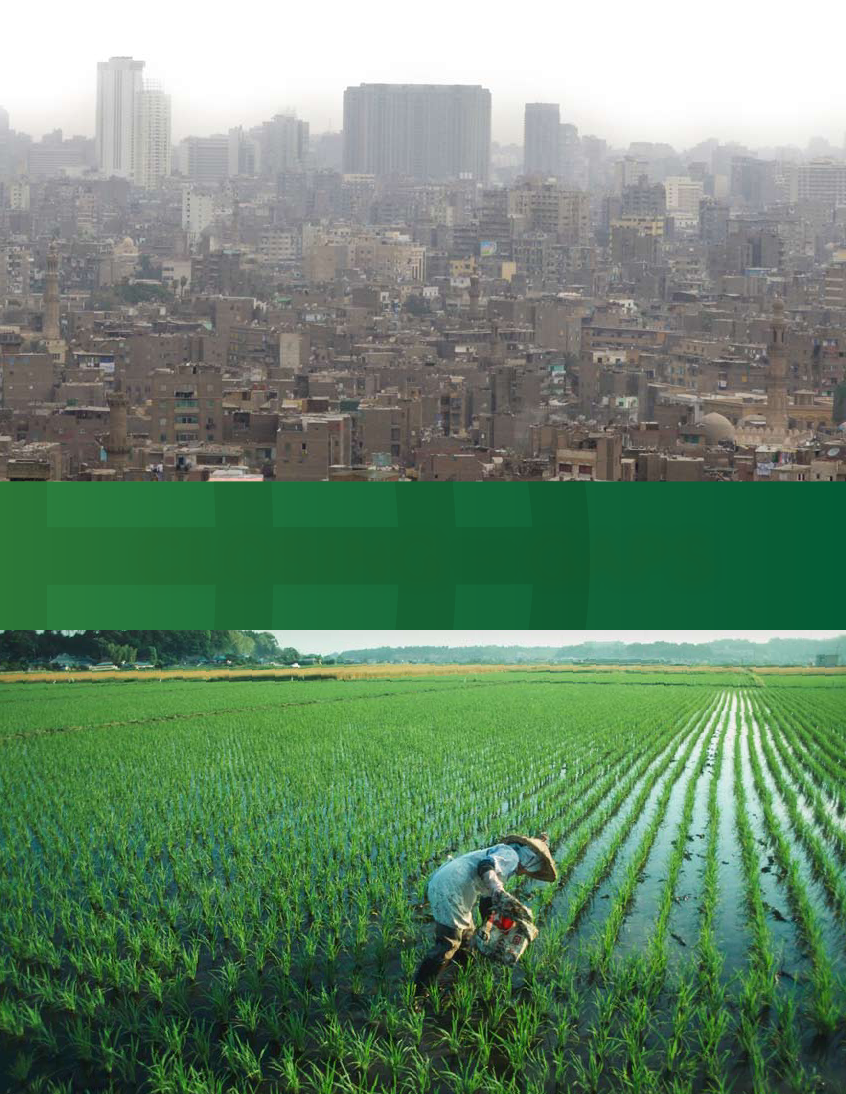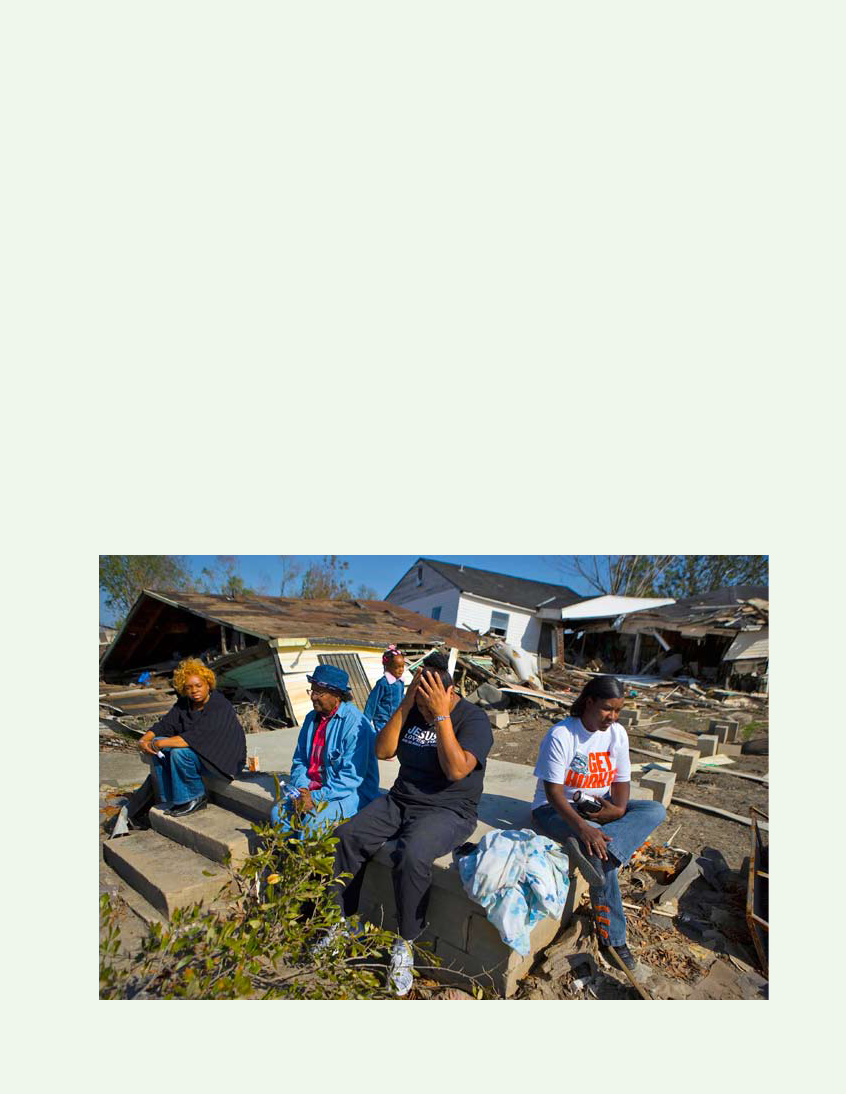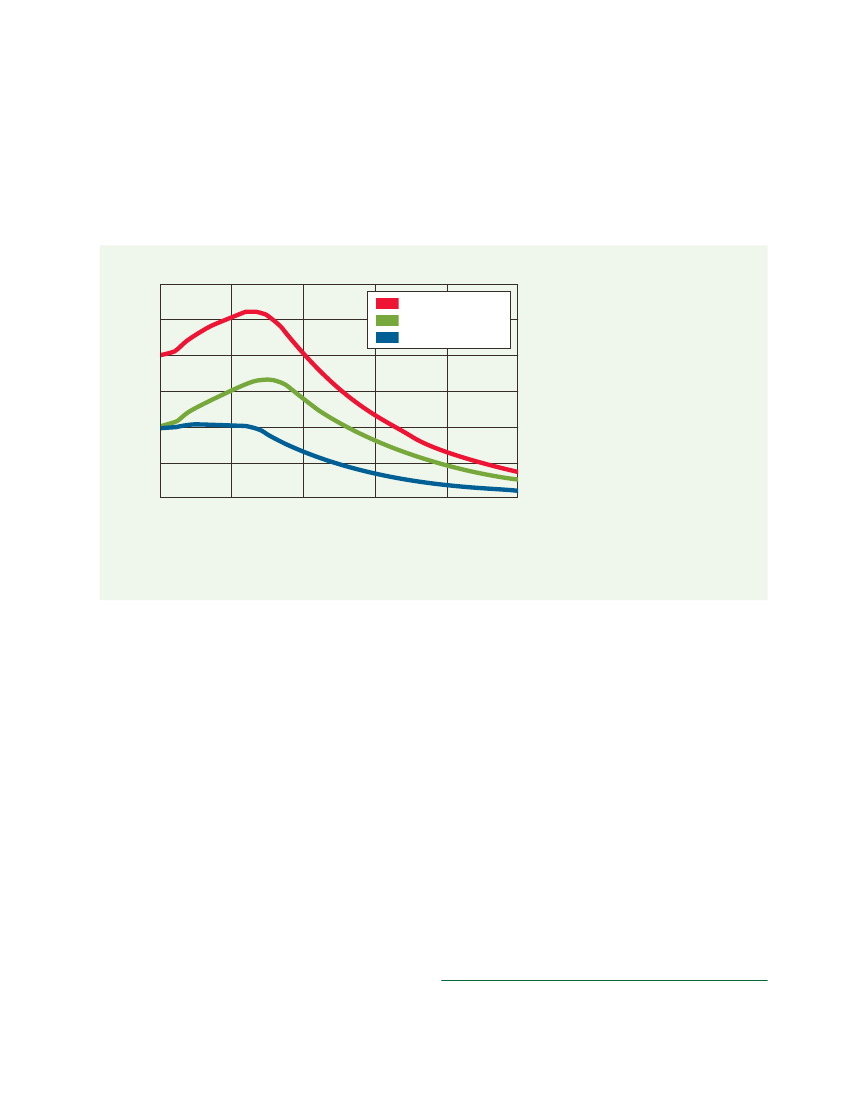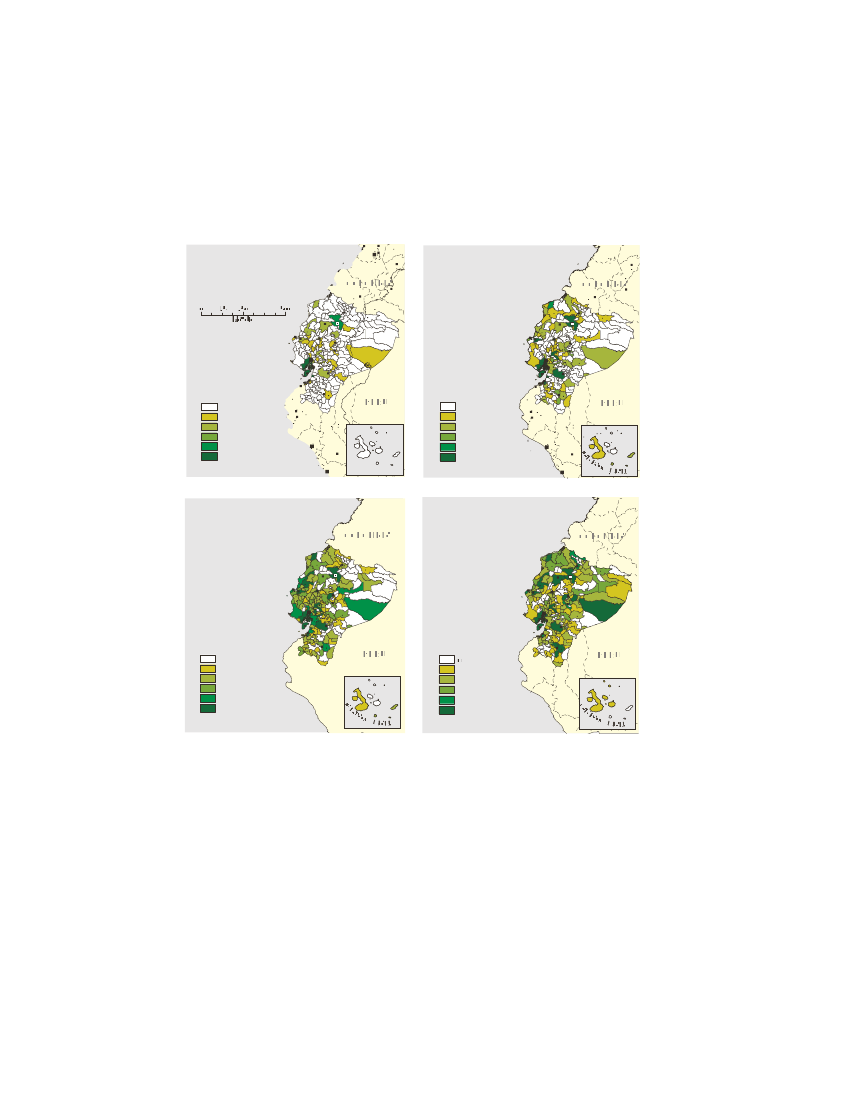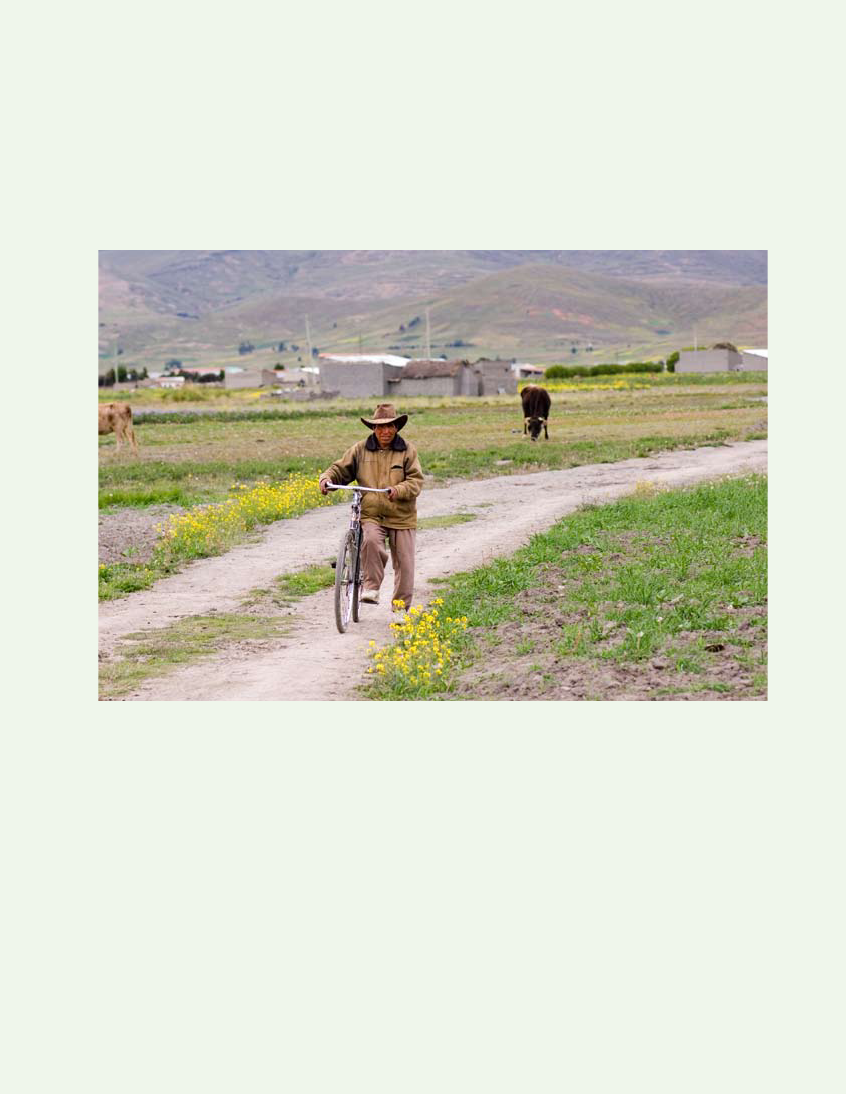Udenrigsudvalget 2008-09
URU Alm.del
Offentligt
Closingt h egaps
Commission on Climate Change and Development
Copyright � 2009by the Commission on Climate Change and DevelopmentAll rights reserved.ISBN: 978-91-633-4720-7For electronic copies of this report, please visit www.ccdcommission.orgFor hard copies of this report, please contact the secretariat of theCommission on Climate Change and Development,Ministry for Foreign Affairs, SE-103 39 Stockholm, Sweden([email protected]).Printing: Edita Sverige AB, Stockholm, SwedenDesign and layout: Johan Resele/Global Reporting, Stockholm, SwedenCover photo: David Isaksson/Global Reporting and Dorling KindersleyEditing: Linda Starke, Washington, D.C., United States
Closing the Gaps:Disaster risk reduction and adaptationto climate change in developing countries
Report of theCommission on Climate Change and Development
Members of the CommissionGunilla CarlssonChairperson of the Commission,Swedish Minister for International Development CooperationAngela CropperDeputy Executive Director of the United NationsEnvironment ProgrammeMohamed El-AshrySenior Fellow, UN FoundationSun HonglieProfessor, Director of the China Climate Change Expert Committee,Chinese Academy of SciencesNanna HvidtDirector of the Danish Institute for International StudiesIan JohnsonChairman of IDEAcarbonJonathan LashPresident of the World Resources InstituteWangari MaathaiProfessor, Founder of the Green Belt MovementIvo MenzingerManaging Director at Swiss ReSunita NarainDirector of the Centre for Science and EnvironmentBernard PetitFormer Deputy Director-General of the Directorate General forDevelopment, European CommissionYouba SokonaExecutive Secretary of the Sahara and Sahel ObservatoryMargareta WahlströmUN Assistant Secretary-General for Disaster Risk Reduction
Chairperson of the Expert GroupAnders WijkmanMember of the European Parliament
II
|
Commission on Climate Change and Development
SecretariatJohan SchaarDirectorKatell Le GoulvenSenior Programme OfficerLloyd TimberlakeLead AuthorTurid TersmedenDesk OfficerLina PastorekDesk OfficerKerstin ÅbergAdministrative OfficerTuula Yli-Tainio MinduAdministrative Officer
Commission on Climate Change and Development
|
III
Climate for ChangeThe Declaration of the Commission onClimate Change and DevelopmentSustainable development is possible but at risk. The planet’s crises – rapidclimate change, degraded ecosystems, scarcities of food, water, and energy –will outlast the serious economic downturn that now absorbs the attention ofglobal leaders and affects people worldwide. Some crises can be reversed, butthe damage to climate and ecosystems that contain and support all life may bebeyond repair and contribute negatively to economic prosperity. It is impera-tive that all countries adapt to this reality. We are all in this together.The way that nations respond to the global recession can provide the basis for anew path of development that begins to ease the planet’s interlocked emergencies.The international community seems less concerned about the failing climatesystem than about failing financial institutions. It hesitates to speak of millionsfor adaptation to climate change, but mobilizes billions for the financial crisis.Faced with a global crisis, nations risk turning inward, focusing on narrow con-cerns, which would be a historic mistake.Yet the climate upon which human civilization is based is changing faster thanimagined 20 years ago – or even 2 years ago. The change is accelerating andwill affect future economic growth and deepen the economic gaps.We must respond by mitigation – decreasing greenhouse gas emissions, creat-ing low-carbon paths of development for every nation, paths of developmentthat are both a right and a necessity.But past emissions are already causing rapid change; so we must adapt to climatechange – for present and future generations. Adaptation actions can spur devel-opment and the achievement of the Millennium Development Goals. The crisesaffect all, but they hit the poorest and most vulnerable hardest. The climatecrisis is already claiming its victims.Climate change also presents humankind with a historic opportunity to makedevelopment more sustainable, encompassing a low-carbon economy and ad-dressing the risks posed by climate change. It offers an opportunity to createtrust and cooperation to better manage all crises, to fashion a market built on
Commission on Climate Change and Development
|
V
ecological truths as well as economic data, to redefine the way we measuregrowth and prosperity. It provides an opportunity for developing renewable en-ergy for growth, providing the vulnerable with resources for adaptive capacity,and reducing the risk of disaster. The responses to climate change provide anopportunity to address the inherent inequity in the climate process and to cre-ate equity within nations, among nations, and between generations.This Commission has focused primarily on adaptation as an important elementof human development. We recognized the capacity of many peoples and fami-lies to use their knowledge and deep experience to adapt effectively, given ap-propriate signals and support. Our focus is on empowering the poorest peopleand countries to improve their ability to cope with an uncertain future – toreduce the negative effects and exploit the positive ones. Adaptation is also cru-cial because millions of lives and livelihoods are at stake and because countriesand regions that fail to adapt will contribute to global insecurity through, forexample, the spread of disease, conflicts over resources, and a degradation ofthe economic system.Seventeen years ago the world agreed on the necessity for the rich to aid thepoor in adapting and made it a treaty obligation in the UN Framework Conven-tion on Climate Change (UNFCCC). The evidence today is stronger, the moralcase unequivocal, and the political importance compelling. There can be noglobal agreement without adaptation assistance, and because of the nature ofclimate impacts, there will be much less global security without it. The worldwill be a worse place for all if we do not meet this treaty obligation.Adaptation is about forms of development in which the capacity to managerisk determines progress. Thus adaptation is much more than climate-proof-ing development efforts and official development assistance (ODA). It requiresaction, additional funding, and deep cooperation between rich and poor nationsand between rich and poor people within nations. It requires sustainable devel-opment: meeting the needs of the present in ways that do not compromise theability of future generations to meet their needs.RESPoNSIBILITIES, CoMMITMENTS, AND LEADERSHIP
A trust gap has opened between industrial and developing countries, stallingessential common action. It is rooted in a failure to fully acknowledge the pol-luter pays principle in climate negotiations and political dialogue. It results both
VI
|
Commission on Climate Change and Development
from decades of unfulfilled commitments in development and trade and fromfears that developing countries with rapidly increasing emissions are not do-ing enough to curb them. The trust gap can be bridged when commitments byindustrial countries are met. Developing nations, for their part, need to ensuretransparent management of funds and the empowerment of their communities.The causes and effects of climate change lie thousands of miles and centuriesapart. Science has spoken: we now need the political will to act. In particular,strong and capable leadership is needed to overcome the current trust impasseand help us all live up to our responsibilities to current and future generations.This leadership will require an acknowledgement of urgency, a willingness toaccept scientific truth, a long-term perspective, and collective actions.SuSTAINABLE DEvELoPMENT
Ultimately, we need sustainable development, including a rapid move towarda low-carbon global economy. New green growth investment opportunities arenecessary to respond to the urgent and growing needs for climate change ad-aptation.Development that can be sustained in a world changed by climate must be enabledby building the adaptive capacity of people and defining appropriate technicaladaptive measures. Adaptive capacity results from reduced poverty and humandevelopment. Adaptive measures require the institutional infrastructure thatdevelopment brings. Action must be fast, scaled, focused, and integrated acrosssectoral divides:▶Speed:Wasting no time – climate change is happening faster than sciencepredicted.▶Scale:With growing numbers of people in danger, responses must match thescale of change.▶Focus:Managing risks, building the resilience of the poorest, and enhancingthe ecosystem functions upon which they depend.▶Integration:Uniting environment, development, and climate change, andmanaging synergies between mitigation and adaptation.
Commission on Climate Change and Development
|
VII
GovERNANCE
The creation of adaptive capacity requires that international funds move effi-ciently to address impacts that are local. Participatory democracy, functioninginstitutions, and transparency are needed at all levels for effective adaptation.People at risk need democratic and political space so that they can inform them-selves and articulate their views and concerns. They need markets that work forthem so that they can trade and build their assets. This means that accountableand responsible government is more important than ever.Adaptation is best managed through policy coherence and through coordina-tion and cooperation among governments, civil society, and the private sector.The principle of subsidiarity should apply when dealing with adaptation.Impacts are local and contextual. The bulk of responsibility will fall on localand national governments, supported by international actions for appropriatecapacities and resources.Social protection – particularly the direct and predictable transfers of resourcesto the poor – must become a standard feature when building the adaptivecapacity of the most vulnerable households and individuals. It will include ef-fective disaster risk reduction for the most vulnerable.Women and men have traditionally played different roles in economic activityand natural resources management. Women and men should have equal rights,making full use of their different capacities; where they are affected differ-ently, attention must be given to the needs of the most vulnerable.INSTITuTIoNS
The adaptive capacity of people and communities is mediated through institu-tions. Disseminating information, building knowledge, articulating needs, ensur-ing accountability, exchanging goods and services, and transferring resources:all these are needed for adaptation and all are guided by and happen throughinstitutions. In an uncertain world, adaptation cannot be effective without ef-fective and accountable organizations and institutions.Families, neighborhoods, and communities and their local institutions musthave effective links with national, regional, and international institutions, whichhelp set the frameworks and provide many of the means in which and by whichthey adapt.
VIII
|
Commission on Climate Change and Development
Twenty-first century challenges require twenty-first century institutions. Today’sorganizations must be able to manage public goods, bringing in the privatesector. They must be stakeholder-driven, efficiently moving resources fromglobal to local levels. They must be problem solvers, valuing ecosystems indealing with climate change.In the short term, we can use existing institutions for the deployment of finan-cial resources and modify these institutions to better manage knowledge andservices. In the longer term, as funding increases and agendas expand, new in-stitutions might be needed. Application of the subsidiarity principle, mentionedabove, will help distinguish among local, national, regional, and internationalresponsibilities.Local level
Local institutions know their communities and should have the main responsi-bility for identifying the poor and vulnerable and supporting them in buildingsafe rural and urban settlements. These institutions should ensure that dissemi-nation of climate information reaches the poorest and most vulnerable throughappropriate extension services.National level
Adaptation requires mechanisms cutting across governments’ sectoral formsof organization. National policy coordination for adaptation, disaster risk re-duction, poverty alleviation, and human development should be led from thehighest political and organizational level. Climate change is far too big a chal-lenge for any single ministry because it requires coordination among multiplesectors. Our report offers encouraging examples. All national sectors must beinvolved in climate actions.All governments have a responsibility to protect their poorest and most vulner-able citizens. Climate consequences will affect growing numbers of vulnerablepeople. Therefore governments need to be ready with the appropriate social safe-ty nets. In developing countries, external technical support is needed to strength-en institutions responsible for such systems, and national and international or-ganizations should cooperate in this effort.Communities in fragile states present challenges. International organizationsand bilateral donors have a special responsibility to support and channel re-sources to them via traditional and informal organizations.Commission on Climate Change and Development
|
IX
In terms of climate change, national governments have to deal with multipleassistance agencies, all of which are trying to prove to their constituencies thatthey are taking effective action. Responding to climate change makes the prin-ciples embedded in the Paris Declaration on Aid Effectiveness and the AccraAgenda for Action – ownership, alignment, use of country systems, division oflabor – therefore even more relevant.Governments should provide an enabling policy framework covering manage-ment, planning, and service delivery functions for adaptation that facilitate andsupport local governments and other actors’ efforts. They should ensure thatdevolved administrative responsibilities are matched by resources and technicalcapacity.Governments need to invest more in climate and meteorological information,biophysical monitoring, and early warning, integrating such data in their planning.Regional level
In many cases, regional coordination will provide the best opportunities fordealing with these issues. Regional organizations should identify added value,analyze lessons learned, and ensure the provision of information on experi-ences and ongoing activities.There is a need to address climate change at the level of river basins and agro-ecological zones, making regional agencies more important. These should be-come more innovative in helping countries produce regional climate infor-mation and knowledge, design common early warning systems for extremeweather conditions, manage shared water resources, control regional infectiousdiseases, and develop and create various agricultural and ecosystem manage-ment systems.International level
The international arena provides great opportunities for major actions suchas carbon markets and technology transfer. Yet given that adaptation is basedmainly on local actions, international organizations must become more adeptat reaching the local level directly and through national governments and re-gional organizations.Adaptation and mitigation both require an improved knowledge network, withmuch greater investment in generating, disseminating, and exchanging know-
X
|
Commission on Climate Change and Development
ledge. It is particularly important to build scientific knowledge and capacityfor climate change research in low-income countries. The IntergovernmentalPanel on Climate Change (IPCC) should continue its four-yearly reports butshould focus also on the rapid turnaround and dissemination of peer-reviewedresearch findings, especially to low-income countries. The World MeteorologicalOrganization should be equipped to service these new requests of the IPCC.The IPCC should engage more actively with other existing institutions (such asthe UN Environment Programme, the World Bank, UN specialized agencies,academia, civil society, and think tanks) to ensure that climate change knowl-edge and information reach users in a timely way, particularly in low-incomecountries.The UNFCCC secretariat should focus on intergovernmental debate and policysetting, not on regulatory, financial, or operational functions. Regulatory serv-ices, the scaling up of carbon trading, and the provision of global corporateguidance (as distinct from political guidance) could be entrusted to a new regu-latory institution that would also effectively provide the least developed coun-tries with access to the carbon markets.The knowledge gap for adaptation is vast, but a growing knowledge network isbeing developed. The UN should provide a focal point for UN-related climatechange knowledge, “delivering as one” within developing countries, providingadvice on issues from water and crop management to insurance and disasterrisk reduction.The United Nations, international organizations (including civil society), andgovernments should work together to quickly and drastically scale up national,regional, and international systems for disaster response and preparedness.The new system should have a standby financial mechanism that would be trig-gered automatically by a major event, assuring rapid response. It should facili-tate recovery through a focus on vulnerability reduction; promote risk transfer,including social transfers and insurance products; and invest in staff with thecreativity and capacity to handle surprises. It should strengthen national andregional capacities.UN agencies are not effectively coordinating their responses to climate change.Governments should support the efforts of the UN Secretary-General (SG) tostrengthen coordination among UN agencies, funds, and programs. We urge
Commission on Climate Change and Development
|
XI
the SG to continue to keep climate change issues at the top of governmentand governance agendas, encouraging and maintaining political will. The SGshould bring in stakeholders and set priorities throughout the UN system.The Commission recognizes the leadership of the SG and urges the SG to con-vene, in cooperation with international financial institutions, an independenthigh-level task force to articulate a vision for development that achieves themultiple goals of mitigation, adaptation, and meeting human needs. High on itsagenda should be the connections between the different global crises and theadequacy of global public policy and global governance in dealing with themsimultaneously.FINANCE
Resources are essential, but getting adaptation right is not only about money.Adopting a new approach to development and fixing our institutions will pro-vide the kind of incentives needed for more adaptive actions. The transition toa low-carbon green economy can support the global recovery by creating newjobs across a wide range of industries, but it will also secure ecosystem servic-es on which the world depends, especially the adaptive capacity of the poorest.In this context, Reducing Emissions from Deforestation and Degradationoffers a promising mechanism for simultaneously delivering mitigation, adap-tation, and economic benefits while sustaining vital ecosystem services.Money is needed now, and more will be needed in the future to help developingcountries adapt. The estimated price tag for this is probably higher than whatis currently spent on ODA, but that is still uncertain. Hence we need a step-by-step approach that will allow us to invest as our knowledge and understandingof climate change impacts and adaptation needs improve.Three main issues must be managed to get adaptation financing right: mobili-zation of resources, management of resources, and allocation of resources.First, mobilization of resources. The Commission urges donors to honor theirODA commitments. This would improve the adaptive capacity of countries.ODA should be used now for urgent needs and to kick-start other forms offinance. In the long run, resources for adaptation will be a blend of ODA andnon-ODA resources. The latter should meet the following criteria: additionality,adequacy, predictability, and political feasibility.
XII
|
Commission on Climate Change and Development
By additional, we mean additional to the commitment of paying 0.7% ofgross national income as ODA. The concept of additionality applies to the rais-ing of funds but does not prescribe how the extra funds must be spent. TheCommission emphasizes the importance of transparency in funding and there-fore urges the Development Assistance Committee of the Organisation forEco-nomic Co-operation and Development to suggest an appropriate markerfor adaptation finance that donors will use when reporting their financial con-tributions. This will allow the tracking of additional resources for adaptation.Second, management of resources. The Commission finds the proliferation offunds for adaptation problematic; it creates a coherence problem and puts pres-sure on the management capacity of developing countries. No further verticalfunds should be created for adaptation.Existing funding mechanisms should be effective, efficient, well coordinated,and accessible for actors at different levels. They should meet the followingcriteria: transparent and balanced governance; accountability of industrial anddeveloping countries; demand-driven, with involvement of recipients duringidentification, definition, and implementation of programs; managementdevolved to the lowest level of effective governance; and independent evalua-tion and oversight.Third, allocation of resources. This should take into account climate changevulnerability and in the early stage should make use of existing channels toimplement high-priority items in National Adaptation Programs of Action, asidentified by countries. The aim should be to integrate adaptation activities intothe normal planning and budgeting processes of countries.A TWo-STEP APPRoACH
Because the creation of new mechanisms might delay essential action, we rec-ommend a two-step approach to mobilizing “new and additional” funds foradaptation in developing countries. This stepwise approach aims to narrow thetrust gap between industrial and developing countries. It provides immediatehelp to the poorest people as progress is made toward a long-term approach toadaptation funding within the context of a new agreement on climate change.As a first step, we urge donor countries to mobilize $1–2 billion (although not atthe expense of current ODA-financed programs) to assist the vulnerable, low-income countries (especially in Africa) and selected small island states (belowCommission on Climate Change and Development
|
XIII
a certain gross domestic product), which are already suffering from climateimpacts. The second step is an effective mechanism for funding adaptation thatwould be created through climate negotiations.ODA and other public funds are unlikely to provide the full resources requiredto finance adaptation efforts of all developing countries in the long term. Thereis a wide range of estimates of the needs.The main messages of our report are that adaptation will be possible and cost-effective, that costs will rise for decades or centuries, and that costs will accel-erate with continuing failure to mitigate.Although more work is required to better estimate these needs, there are prom-ising options proposed to raise funds. Some could bring between $5 billion and$15 billion additional funds a year – which is in the lower range of estimatedneeds.We urge governments to adopt the mechanisms that provide additional and pre-dictable resources and are politically feasible, equitable in terms of all donorsand recipients, and respectful of the principle of common but differentiatedresponsibility.A BETTER CHANCE
During the course of its work, the Commission on Climate Change and De-velopment has met governments and citizens struggling with the effects of cli-mate change in Bolivia, Cambodia, and Mali. We offer this declaration and itsrecommendations as a contribution to the sustainable development path thatclimate change requires. We offer it for the consideration of political leaders atthe Copenhagen climate meeting and beyond.All governments have responsibilities toward their most vulnerable citizens.All resources mobilized to mitigate and adapt to climate change must ensuretheir rights, their voice, their security.In 20 years the next generation will not judge us by the precise arrangements wemake to reduce the emissions that cause global warming and help the victimsof climate change, but rather by whether these arrangements proved effective.If we fail, their lives will be worse and will be more limited. If we succeed, wewill have provided them at least a better chance.
XIV
|
Commission on Climate Change and Development
PrefaceFor many years negotiations and debates on climate change have focused onthe need to reduce emissions of greenhouse gases. We assumed that successfulmitigation would help us avoid the harmful effects of increasing temperatures.But mitigation has yet to begin at the required scale and space. People aroundthe globe observe changes to their environment with profound consequences.The rainy season cannot be trusted to last long enough to recharge dry wellsand restore soil moisture. Returning migratory birds no longer signal the righttime for putting seeds in the ground. And violent storms and rains occur whenand where they are least expected. Those with little margin to maintain a de-cent life for themselves and their children, relying directly on what ecosystemsprovide, are most affected.In September 2007, Swedish Prime Minister Fredrik Reinfeldt therefore in-formed the Secretary-General of the United Nations of his government’s initia-tive to launch an international commission on climate change and development.Its focus would be threefold: how to design and support adaptation to climatechange, how to reduce the increasing risk of weather-related disasters, and howto strengthen the resilience of the poorest and most vulnerable communitiesand countries.Much has changed since that day in New York. In December 2007 climate nego-tiators agreed on a Bali Action Plan, where adaptation is one of the pillars ofthe continued negotiation process. Scientists report that climate change is hap-pening more rapidly than had been predicted. And the climate crisis is not alone.Food, energy and water scarcities, ecosystem degradation, and a global eco-nomic downturn are taking their simultaneous toll, especially on the poorest.The Commission on Climate Change and Development decided to build itscase from the ground up. Through our meetings with citizens and governmentsin Bolivia, Cambodia, and Mali, we sought to gain an understanding of thethreats poor people face, how they can build their adaptive capacity, and whatis needed in the form of institutions and resources to provide the most effectivesupport and the best outcomes.
Commission on Climate Change and Development
|
XV
For this to happen, a number of gaps must be bridged. There is a trust gap be-tween rich and poor countries, gaps between institutions, and a resource gap.These are addressed in individual chapters of our report.Taking adaptation actions today is a requirement for sustainable developmenttomorrow. Early action is needed to reduce future costs and irreversible eco-logical damage. We, the Commission, are convinced that the different crisescan only be resolved in unison. Assigning the right value to the climate andecosystems, ensuring that no system is used beyond its capacity, and creatingpolitical space for dialogue and action – these are steps needed to deal with ourmultiple threats. The Commission is united in its belief that the climate crisisgives us both obligations and opportunities. It is in this spirit we offer our report.Gunilla CarlssonSwedish Minister for International Development CooperationChairperson, Commission on Climate Change and Development
XVI
|
Commission on Climate Change and Development
AcknowledgmentsThe Commission and the secretariat have received advice and support frommany individuals, institutions, and organizations from around the world. Thisreport would not have been possible without their generous contributions.The Commission and the secretariat sincerely thank the group of experts whoprovided substantive inputs to the work of the Commission since its creation:Simon Anderson, Margaret Arnold, Tariq Banuri, Salvano Briceno, Ian Christo-plos, Victor Galaz, Luis Gomez-Echeverri, Richard Klein, Merylyn McKenzieHedger, Johan Rockström, Camilla Toulmin, and Anders Wijkman.Other experts who have shared their knowledge with us throughout the processinclude: Arun Agrawal, Shardul Agrawala, Jonathan Allotey, Jon Barnett, ReidBasher, Boni Biagini, Yvan Biot, Emily Boyd, Ramzi Elias, Siri Eriksen,Alex Evans, Marianne Fay, Tigue Geoghegan, Pär Granstedt, Natasha Grist,Holger Hoff, Saleemul Huq, Francis Johnson, Shefali Juneja, Saroj Khumar Jah,Bo Kjellen, Fiona Lambe, Elisabeth Lindgren, Silvia Llosa, MJ Mace, StewartMaginnis, Julia Marton-Lefèvre, Andrew Maskrey, Heather McGray, GregoryMock, Helena Molin-Valdez, Georgia Moyka, Benito Müller, Fredrik Möberg,Vikas Nath, Lina Nerlander, Fredrick Njau, Marcus Oxley, Nicolas Perrin, DavidReed, Espen Ronneberg, Fiona Rotberg, David Satterthwaite, Lisa Schipper,Melanie Speight, David Steven, Annika Söder, Susanna Söderström, YashTandon, Antonio Tujan, Koko Warner, Richard Weaver, Michael Webber, andVicente Yu.We would like to express our gratitude to the people who welcomed and guidedus during our field visits: Aghatan Ag Alhassane, Juan Carlos Alurralde, IvarArana, Victor Cortez, Yem Dararath, Halima Diakite-Diallo, Mamadou Gakou,Liliana Gonzalez, Jenny Gruenberger, José Luis Gutierrez, Erik Illes, SokontheaKith, Mama Konate, Mok Mareth, Sara Martinez Bergström, Sidi al Moctar,Oscar Paz, Tin Ponlok, Sara Ramirez, Juan Pablo Ramos, Arne Rodin, MakSithirith, Chan Sophal, Roland Stenlund, Johanna Teague, Leslie Thompson,Ibrahim Togola, Johanna Togola, and Chhieng Yanara. This gratitude is extend-ed to the staff of the SIDA offices in Bolivia, Cambodia, and Mali, to the staffof the Bolivia National Programme for Climate Change, the Cambodia Fisher-
Commission on Climate Change and Development
|
XVII
ies Action Coalition Team, and the Mali Folke Center, as well as to the popula-tions of Batallas, Kampong Chhnang, and Bougoula.We also benefited from thoughtful comments and suggestions from colleaguesat the Swedish Ministry for Foreign Affairs, the Swedish International Develop-ment Agency, and the Commission’s reference group. We are particularly grate-ful to: Anders Berntell, Jan Bjerninger, Per Björkman, Johan Borgstam, OlofDrakenberg, Lars Ekecrantz, Lars-Göran Engfeldt, Harald Fries, Nina Frödin,Elisabeth Groll Lindell, Stina Götbrink, Niclas Hellström, Peter Holmgren,Torgny Holmgren, Emilia Högquist, Susanne Jacobsson, Dag Jonzon, PernillaJosefsson Lazo, Carly Jönsson, Angela Kallhauge, Jan Knutsson, Patrick Kratt,Peter Larsson, Karin Lexén, Lars-Erik Liljelund, Lars Lundberg, Klas Marken-sten, Ann-Sofie Nilsson, Anders Nordström, Mirjam Palm, Johan Röstberg,Joakim Sonnegård, Jakob Ström, Staffan Tillander, Eva Tobisson, Lena Tran-berg, Anders Turesson, Anna Yazgan, Petra Åhman, and Ulrika Åkesson.Our sincere thanks also go to the Stockholm Environment Institute and the De-partment for Development Policy of the Swedish Ministry for Foreign Affairsfor hosting the secretariat and supporting our work on a daily basis.And finally we are indebted to the people who have helped us with the pro-duction of this report: Susanna Ahlfors, David Isaksson, and Johan Resele ofGlobal Reporting; Ing-Marie Sjunnebo and John Sundberg of Edita; Fauvettevan der Schoot of Multi-Language Services, Inc; and Linda Starke.
XVIII
|
Commission on Climate Change and Development
Table of ContentsAdapting to Change...................................................................................VPreface.....................................................................................................XVAcknowledgments.................................................................................XVIIExecutive Summary.................................................................................XX1. Adaptation: The Context for Change......................................................12. The Trust Gap..........................................................................................83. The Focus Gap: The Human Dimension...............................................134. Governance Gaps..................................................................................245. Financing Gaps.....................................................................................34Acronyms..................................................................................................44Appendixes1. Food Security......................................................................................452. Water...................................................................................................493. Natural Resources, Forests, and Trees...............................................524. Health..................................................................................................555. Energy Access.....................................................................................606. Risk and Insurance..............................................................................657. Migration..............................................................................................688. Cities....................................................................................................729. Disaster Risk Reduction......................................................................7510. Commission’s Terms of Reference......................................................7811. Commissioner Biographies.................................................................79
Commission on Climate Change and Development
|
XIX
Executive SummaryThe international Commission on Climate Change and Development waslaunched in late 2007 by the Swedish government. Chaired by Swedish Minis-ter for International Development Cooperation Gunilla Carlsson, the Commis-sion has 13 members from countries in all regions. They represent internationaland regional organizations as well as science, civil society, and the private sector.The Commission examined adaptation to climate change and its links withdevelopment and disaster risk reduction and was asked to issue policy recom-mendations on how the resilience of vulnerable communities and countries canbe strengthened through official development assistance (ODA), on appropriateinstitutional and financial architecture, and on the mobilization of new finan-cial resources.In Chapter 1 we argue that the only solution to climate change is a rapid movetoward a low-carbon global economy. This must be done urgently, efficiently,and with great determination, so that adaptation remains possible.The poor are overwhelmingly the present and future victims of climate change.Its impacts are mixed with and overlap the impacts of other syndromes such asrising food prices, the financial crisis, energy shortages, ecosystem degrada-tion due to other human causes, and demographic changes. These must bemanaged in a highly coordinated manner.The poor need adaptive capacity, which consists mainly of assets, health,education, and governance. Thus in poor countries adaptation is inseparablefrom development, where the capacity to manage risk determines progress.Adaptation is much more than climate-proofing development efforts and ODA.It requires action, additional funding, and deep cooperation between rich andpoor nations and between rich and poor people within nations. It requires sus-tainable development: meeting the needs of the present in ways that do not com-promise the ability of future generations to meet their needs.Development must quickly reach rapidly growing numbers of people, focus onreducing vulnerability, and integrate adaptation, mitigation, and human devel-opment goals.
XX
|
Commission on Climate Change and Development
Chapter 2 examines the ethics of climate change, mitigation, and adapta-tion, including the trust gap between industrial and developing nations. In theUN Framework Convention on Climate Change of 1992, wealthy nations pledgedto help poorer nations adapt to climate hardships created for them by others.Unless this pledge is honored, the poorer countries will not agree to a post-2012global framework on climate change. Yet climate ethics are complex, as causesand effects are separated by thousands of miles and by generations. The issue ofbasic fairness developed in this chapter informs much of the rest of this report.Chapter 3 focuses on the human dimension of climate change. While the ef-fects of climate change may be vast, their brunt will be borne locally by indi-viduals, families, villages, and neighborhoods. Discussions of climate changemust be turned upside down, switching from a global to a local focus. Nationalgovernments must set frameworks to ensure that adaptation measures and dis-aster risk reduction reach all, including the most vulnerable. Historically, badgovernance and a failure to respond to local needs have hindered developmentefforts. Those problems will frustrate adaptation if not managed. Moving to-ward participatory democracy is essential.Adaptation discussions tend to focus on big weather-related catastrophes. Yetadaptation to smaller, unreported events is at least as important. First, the in-crease in smaller floods, landslides, and so on is increasing poverty through theaccumulated effects. Second, households and societies that are more resilient tosmall shocks are less vulnerable to big ones.Adaptation strategies must increase the adaptive capacities of people, businesses,and ecosystems. Some development agencies and national governments are suc-cessfully using social transfers – regular and predictable grants to poor house-holds – as a way to improve access to services and address the underlying causesof inequalities in well-being. They need to be expanded and scaled up as vul-nerability increases.Adaptation is shaped by institutions at the local, national, and internationallevels; adaptive capacity at the local scale depends on developing capacity foradaptation at wider scales. The private sector is a key resource in adaptation.Three main institutional ingredients are necessary to improve people’s adaptivecapacity: targeted capacity development, inclusive governance, and ownership.
Commission on Climate Change and Development
|
XXI
Chapter 4 addresses the governance gap. It shows that despite the strong inter-dependence between economy, environment, and development, governmentscontinue to try to manage issues in silos as if they were separate one fromanother. Climate change, one of the greatest threats to human civilization, hasbeen placed in what is often the weakest governance silo: environment.Local institutions know their communities and should have the main responsi-bility for identifying the poor and vulnerable and supporting them in buildingsafe rural and urban settlements. These institutions should ensure that dissemi-nation of climate information reaches the poorest and most vulnerable throughappropriate extension services.National policy coordination for adaptation, disaster risk reduction, povertyalleviation, and human development should be led from the highest politicaland organizational level. Climate consequences will affect growing numbersof vulnerable people. Therefore governments need to be ready with the appro-priate social safety nets.The need to address climate change at the level of river basins and agro-eco-logical zones makes regional agencies more important. These should becomemore innovative in helping countries produce regional climate information andknowledge, design common early warning systems for extreme weather condi-tions, manage shared water resources, control regional infectious diseases, anddevelop and create various agricultural and ecosystem management systems.The international arena provides great opportunities for major actions suchas carbon markets and technology transfer. Yet given that adaptation is basedmainly on local actions, international organizations must become more adept atreaching the local level directly and through national governments and region-al organizations. The commission offers a number of ways that they can do so.Chapter 5 deals with the mechanisms for financing adaptation. Acknowledg-ing the difficulties of counting the costs of adaptation at any given time, it ar-gues that costs will only increase as society continues to delay serious effortson mitigation. The report calls for new and additional resources for financingadaptation. It calls for greater coordination of financing mechanisms and moni-toring of resources at the global and national levels.Mobilization of resources is key. Honoring ODA commitments improves theadaptive capacity of countries and would provide funds to help kick-start urgent
XXII
|
Commission on Climate Change and Development
adaptation measures. In the long run, resources for adaptation will be a blendof ODA and non-ODA resources. The latter should meet the following criteria:additionality, adequacy, predictability, and political feasibility.The proliferation of funds for adaptation is problematic; it creates a coherenceproblem and puts pressure on the management capacity of developing coun-tries. No further vertical funds should be created for adaptation. Existing fund-ing mechanisms should be effective, efficient, well coordinated, and accessiblefor actors at different levels. A step-wise approach for mobilizing financial re-sources is envisaged.Allocation should take into account climate change vulnerability and in theearly stage should make use of existing channels to implement high-priorityitems in National Adaptation Programs of Action, as identified by countries.The aim should be to integrate adaptation activities into the normal planningand budgeting processes of countries.Nine appendixes cover the issues of food security; water; natural resources,forests, and trees; health; energy access, climate, and development; risk andinsurance; migration; cities and: disaster risk reduction;▶Food security depends on more than how much food is grown; it dependson people’s access to markets (including for labor), the stability of supply,and quality. All are affected by climate change and must be managed.▶Water is mainly an issue of political power, especially for the poor. Efficientmanagement is also crucial, particularly for the use of rainwater.▶Natural resources management depends on land tenure and user rights. Goodmanagement, especially of forests, can have both mitigation and adaptationresults.▶Energy is necessary for development, and energy access issues must be partof mitigation and adaptation strategies.▶Health will be affected by changing disease patterns, requiring more empha-sis on prevention and improved sanitation.▶Insurance approaches must evolve toward new forms of transferring andsharing risks more effectively targeting the poor and based on climate changemodels.
Commission on Climate Change and Development
|
XXIII
▶Cities, especially the mega-cities of poor nations, require problem-solvingpartnerships between local governments and residents of informal commu-nities for innovative urban land use.▶Migration should be recognized as an adaptive strategy, to be managed andfacilitated rather than restricted.▶Disaster risk reduction strategies should focus on underlying risk rather thanresponse and on the safety of human settlements.
XXIV
|
Commission on Climate Change and Development
1. Adaptation: The Context for ChangeDevelopment and climate change are the central problems of the 21st Century.If the world fails on either, it will fail on both. Climate change undermines development.No deal on climate change which stalls development will succeed.”Lord NichoL as sterN
The international Commission on Climate Change andDevelopment was launched in late 2007 by the Swedishgovernment. Chaired by Swedish Minister for InternationalDevelopment Cooperation Gunilla Carlsson, the Commis-sion has 13 members from countries in all regions. Theyrepresent international and regional organizations as wellas science, civil society, and the private sector.The Commission examined adaptation to climate changeand its links with development and disaster risk reductionand was asked to issue policy recommendations on howthe resilience of vulnerable communities and countries canbe strengthened through official development assistance(ODA), on appropriate institutional and financial architec-ture, and on the mobilization of new financial resources.1The Commission’s first message is that the only responseto climate change is a rapid move toward a low-carbon glo-bal economy. This must be done urgently, efficiently, andwith great determination.Yet mitigation – efforts to decrease the amounts ofgreenhouse gases (GHGs) released into the atmosphere –has yet to begin at the required scale and pace. In fact, GHGemissions have increased steadily since the UN FrameworkConvention on Climate Change (UNFCCC) was adopted in1992. Thus anthropogenic emissions are already changingthe climate and, due to their long residence in the upperatmosphere, will continue to do so for many decades if notcenturies to come. Civilization will have to adapt to thesechanges.Policy makers and scientists have all been slow to focuson adaptation, largely because mitigation got much of their
attention. In fact, many environmentalists feared that anyfocus on adaptation would take attention away from the ur-gent need to mitigate. That has changed.The Fourth Assessment Report of the IntergovernmentalPanel on Climate Change (IPCC) noted that even if globalsociety does succeed in reducing emissions, some climatechange impacts are now unavoidable (see Box, p. 2.) andsolutions must be found to adjust to them.As a result, the 2007 Bali Action Plan called for strong andextremely ambitious steps on adaptation, giving priority tourgent and immediate needs of vulnerable developing coun-tries, including the full range of risk reduction measures.
A stronger sense of urgencySince the IPCC’s Fourth Assessment Report, a number ofscientists and scientific organizations have published paperssuggesting that climate change is happening much fasterthan the panel suggested. The 2009 meeting of the Ameri-can Association for the Advancement of Science heard howcarbon emissions have been growing at 3.5% per year since2000, up sharply from 0.9% per year in the 1990s.The European Union has set a goal of not allowing thetemperature increase to exceed 2� Celsius. Staying underthat target would imply emission cuts of at least 80% by2050. Many scientists argue that an increase of 2� is toohigh and call for more drastic cuts in emissions. Positivefeedback mechanisms such as a reduced albedo and thethawing of the permafrost are likely to accelerate climatechange, and the planet appears to be moving toward dan-gerous tipping points.Evidence is also growing that the absorptive capacity ofcarbon sinks such as oceans and terrestrial ecosystems isdiminishing. Deforestation, soil erosion, overfishing, andbad management of freshwater resources have further re-
1
See Appendix 10 for the Commission’s full terms of reference.
Commission on Climate Change and Development
|
1
of the trends will accelerate, leading to an increasingrisk of abrupt or irreversible climatic shifts.3
Different impacts for different regionsin africa, the situation is quickly becoming more serious: analystsproject that by 2020, between 75 million and 250 million people willbe exposed to increased water stress due to climate change, and insome countries yields from rainfed agriculture could be reduced by upto 50%.in asia, by the 2050s freshwater availability in central, south, east,and southeast asia, particularly in large river basins, is projected todecrease, and diarrheal diseases associated with floods and droughtsare expected to increase in east, south, and southeast asia.in Latin america, productivity of some important crops is projectedto decrease and livestock productivity to decline, with adverse conse-quences for food security. changes in precipitation patterns and thedisappearance of glaciers in the andes are projected to significantlyaffect water availability for human consumption, agriculture, and en-ergy generation.in small island states, sea-level rise is expected to threaten vital in-frastructure, settlements, and facilities that support the livelihood ofisland communities. By mid-century, climate change is expected toreduce water resources in many small islands in the caribbean andPacific to the point where they become insufficient to meet demandduring low-rainfall periods.source: intergovernmental Panel on climate change,Climate Change2007: Synthesis Report. Contribution of Working Groups I, II and III tothe Fourth Assessment(Geneva: 2007).
Interconnected crisesThe impacts of climate change are mixed with and overlapthe impacts of other syndromes such as rising food prices,the financial crisis, energy shortages, ecosystem degrada-tion due to other human causes, and demographic changes.The lack of atmospheric space to safely dispose of GHGemissions is one of several linked scarcities now affectingsociety. Others include scarcities of affordable petroleum-based products, affordable food, and fresh water.4Climatechange is accelerated by the use of carbon-based energy andthe alteration of forests to farmland; it changes the avail-ability of fresh water. Agriculture needs a predictable cli-mate, water, energy sources, and fertilizer, much of whichis petroleum-based. It is not clear how long these scarcitieswill persist or how they will continue to affect one another.These strong connections mean that the scarcities mustbe managed in a highly coordinated manner. The next-gen-eration technologies, protective investments, and shifts inpolicies needed to correct economic and financial imbal-ances can also serve the collective purpose of protectingour common environment from overexploitation. Failureon one will be failure on both.
Focus on the poorduced the capacity of Earth’s systems to respond to futureshocks.2In March 2009 in Copenhagen, 2,500 researchers fromsome 80 countries presented their most recent findings.Their main message, according to conference organizers,was that:Recent observations confirm that, given high ratesof observed emissions, the worst-case IPCC scenariotrajectories (or even worse) are being realized. Formany key parameters, the climate system is alreadymoving beyond the patterns of natural variabilitywithin which our society and economy have devel-oped and thrived. These parameters include globalmean surface temperature, sea-level rise, ocean andice sheet dynamics, ocean acidification, and extremeclimatic events. There is a significant risk that manyAll nations and all people must adapt to climate change.This truth is demonstrated by the heat waves of 2003 in Eu-rope and North America and by Hurricane Katrina in 2005and other hurricanes affecting US cities. Although singleevents can rarely be attributed to climate change, they doshow that it is the poor, even in wealthy countries, who aremost affected by extreme weather events.
2
Millennium Ecosystem Assessment,Ecosystems and Human Well-being:Synthesis(Washington, DC: Island Press, 2005).“Key Messages from the Congress,” International Scientific Congress –Climate Change: Global Risks, Challenges & Decisions, University of Co-penhagen, 10–12 March 2009.See, e.g., A. Evans, “Multilateralism for an Age of Scarcity. Building Inter-national Capacity for Energy, Food and Climate Security,” Working Paper(New York: Center for International Cooperation, New York University,July 2008).
3
4
2
|
Commission on Climate Change and Development
1.adaptation: the context for change
Continuum of adaptation activitiesFigure 1.
Vulnerability focus
Impacts focus
Addressing the driversof vulnerability
Building responsecapacity
Managing climate risks
Activities seek toreduce poverty andother non-climaticstressors that makepeople vulnerable
Activities seek to buildrobust systems forproblem solving
Activities seek toincorporate climateinformation intodecision-making
Confronting climatechange
Activities seek toaddress impactsassociated exclusivelywith climate change
source: r. J. t. Klein and Å. Persson, “Financing adaptation to climate change: issues and Priorities”(Brussels: centre for european Policy studies, 2008).
This report focuses on adaptation to climate change bypoor countries and by poor people in those countries:▶Because climate change threatens poverty reductionand the achievement of the Millennium DevelopmentGoals,▶Because poor people in poor countries depend directlyon endangered ecosystems and their services for theirwell-being,▶Because poor people in poor countries lack the resourc-es to adequately defend themselves or to adapt rapidly tochanging circumstances, and▶Because their voices are not sufficiently heard in inter-national discussions, particularly in climate change ne-gotiations.
drought-tolerant crop varieties, agricultural diversification,vaccines, upgraded drainage systems, enhanced wateruse efficiency, enlarged reservoirs, or revised buildingcodes. Building adaptive capacity aims to address the mul-tiple drivers of vulnerability, including poverty. Betweenbuilding adaptive capacity and instituting adaptive meas-ures, there exists a continuum of adaptation activities. (SeeFigure 1.)6Adaptive capacity increases with human development. Itcan be summarized under four simple headings – wealth,health, education, and governance:▶Wealth, or access to assets, provides the buffers andbackup that take people through crises and enable themto recover. Assets may be financial or material, directlyaccessible or through insurance, and come from the so-cial networks of family and kin or through government
Adaptation and developmentWhat is adaptation? The UNFCCC provides a clear answer:“Adaptation is a process through which societies makethemselves betterable to copewith an uncertain future.Adapting to climate change entails taking the rightmeas-uresto reduce the negative effects of climate change (orexploit the positive ones) by making the appropriate adjust-ments and changes” [emphasis added].5Adaptation is about building adaptive capacity and carry-ing out appropriate adaptive measures. Adaptive measuresseek to address climate change impacts by, for example, anew seawall, crop insurance schemes, research on heat- and
5
UN Framework Convention on Climate Change (UNFCCC),ClimateChange: Impacts, Vulnerabilities and Adaptation in DevelopingCountries(Bonn: 2007), p. 12.R. J. T. Klein and Å. Persson, “Financing Adaptation to ClimateChange: Issues and Priorities” (Brussels: Centre for European PolicyStudies, 2008), adapted from H. McGray, A. Hammill, and R. Bradley,with E. L. Schipper and J. Parry,Weathering the Storm: Options forFraming Adaptation and Development(Washington, DC: World Re-sources Institute, 2007).
6
Commission on Climate Change and Development
|
3
▶
▶▶
social protection schemes for those with few means oftheir own.Health safeguards the productive capacity of the indi-vidual and the integrity of families. This comes throughclean water and effective sanitation, safe childbirth, andfood of the right kind and amount so that children growto their full potential.Education gives people access to information, knowl-edge of their options, and the ability to make informedchoices.Governance, or rather the fullness of the institutionalenvironment, provides the means through which people,working with others, have access to resources, articulateneeds, and exercise their rights.
A new development pathThe development path under climate change will involverethinking and reformulation on four levels: speed, scale,focus, and integration.▶Speed:Wasting no time – climate change is happeningfaster than science predicted. The IPCC prediction thatin Africa between 75 million and 250 million peoplewill be exposed to increased water stress by 2020 allowsfor little more than a decade of development.▶Scale:Development must decrease the vulnerability ofall of the planet’s poorest, and especially the “bottombillion.” Growing numbers of people are in danger;responses must match the scale of this change.▶Focus:Development should be centered on managingrisks, building the resilience of the poorest, and enhancingthe ecosystem functions upon which they depend. Thisrequires new focus and emphases in all sectors, includ-ing food security, with special attention to poor people’saccess to markets; water, with special attention to equityof access and the efficient use of rainwater; natural re-sources management, with special attention to land tenureand user rights of the poor; energy, with special atten-tion to a decentralized mix of renewable and low-carbonoptions for the poor; migration, with special attention topolicies that benefit the most vulnerable regions and min-imize transaction costs on remittances; and disaster riskreduction, with special attention to the most vulnerablegroups and settlements and to rehabilitated infrastruc-ture that contributes to reduced risk. (See appendixes forfurther discussion of these issues.)▶Integration:Adaptation, mitigation, and human devel-opment goals are closely interrelated. (See Box, p. 5)Mitigation measures such as afforestation, reforestation,and avoided deforestation are also effective adaptation,as they improve economic and ecosystem resilience. Thecurrent approach, which tries to deal with them sepa-rately, will not only be ineffective, it will be counterpro-ductive. The conceptof sustainable development unitedthe two concerns of environment and development; ournew development path unites environment, development,and climate change (adaptation and mitigation).
Understanding adaptation in this way tells us that adaptiveaction must be highly context-specific. In countries andcommunities where human development indicators are low,priority must be given to strengthening the adaptive capac-ity of people and institutions. If capacity is already there,through assets, insurance, a healthy and well-educatedpopulation, and formal and informal institutions that medi-ate support and through which needs can be analyzed andarticulated, then action will naturally emphasize climate-specific measures – that is, measures that would not havebeen necessary if climate change were not happening.This report looks at the adaptive capacity of people,firms, and ecosystems and discusses their interactions,complementarities, and competition. It also looks at adap-tive capacity across scales – local, national, international– and how interfaces among these scales facilitate or standin the way of adaptation.Adaptation to climate change is about forms of develop-ment in which the capacity to manage risk determines pro-gress. Thus adaptation is much more than climate-proofingdevelopment efforts and official development assistance.The Commission finds that it requires action, additionalfunding, and deep cooperation between rich and poor na-tions and between rich and poor people within nations. Itrequires sustainable development: meeting the needs of thepresent in ways that do not compromise the ability of futuregenerations to meet their needs.
4
|
Commission on Climate Change and Development
1.adaptation: the context for change
Structure of the reportOur report is structured around four main parts follow-ing this chapter. Chapter 2 examines the ethics of climatechange, mitigation, and adaptation, including the trust gapbetween industrial and developing nations. Wealthy nationspledged in the UN Framework on Climate Change of 1992to help poorer nations adapt to climate hardships created forthem by others. Unless this pledge is honored, those countrieswill not agree to a global framework on climate change.Yet climate ethics are complex, as causes and effects areseparated by thousands of miles and by generations. Theissue of basic fairness developed in this chapter informsmuch of the rest of this report.Chapter 3 focuses on the human dimension of climatechange. While the effects of climate change may be vast,their brunt will be borne locally by individuals, families,villages, and neighborhoods. Discussions of climate changemust be turned upside down, switching from a global to alocal focus. National governments must set frameworks toensure that adaptation measures and disaster risk reductionreach all, including the most vulnerable. Historically, badgovernance and a failure to respond to local needs havehindered development efforts. Those problems will frus-trate adaptation if not managed. Moving toward participa-tory democracy is essential.Chapter 4 addresses the governance gap. It shows thatdespite the strong interdependence between economy, en-vironment, and development, governments continue to tryto manage issues in silos as if they were separate one fromanother. Recognizing the limitations of individual actions,the report calls for an enlightened, prudent, yet proactiveglobal public policy.Chapter 5 deals with the mechanisms for financingadaptation. Acknowledging the difficulties of counting thecosts of adaptation at any given time, it argues that theywill only rise as society continues to delay serious effortson mitigation. The report calls for new and additional re-sources for financing adaptation but also recognizes theimportance of official development assistance to kick-starturgent adaptation efforts. A step-wise approach for mobi-lizing financial resources is envisaged. It calls for greatercoordination of financing mechanisms and monitoring ofresources at global and national levels.The appendixes cover the issues of food security; water;
Synergies between mitigation and adaptationMitigation and adaptation can be mutually reinforcing. increasing thestorage of carbon and avoiding its release from forests and soils canhave multiple benefits. the reducing emissions from deforestation andForest degradation program offers a promising mechanism for simulta-neously delivering mitigation, adaptation, and economic benefits whilesustaining vital ecosystem services. the basic principle is that coun-tries and those that own and manage forests would be paid to protectand increase the public goods they provide. similar ideas with regardto carbon sinks in soils are under discussion.such measures could be combined with adaptation efforts and pro-duce synergies. Maintaining or increasing forest coverage, avoiding till-age of highly organic soils, or integrating bio-char may lead to improve-ments in water retention and soil productivity, ultimately promoting theresilience of ecosystems and of the communities that depend on them.Mitigation would go hand in hand with adaptation. a high value wouldbe assigned to the sustainable management of natural resources andpotentially also promote the implementation of the conventions on bio-diversity and desertification.But there are also conflicts. ample experience tells us that withoutsecure rights and proper governance arrangements, the poor and land-less risk being forced out when the value of forests and land increases.New opportunities will enrich some while others lose out. if safeguardsagainst such risks are not put in place, new climate policy may furthermarginalize the poor and vulnerable.
natural resources, forests, and trees; health; energy access,climate, and development; risk and insurance; migration;cities; disaster risk reduction; and the Commission’s termsof reference and biographies of the Commissioners.
Commission on Climate Change and Development
|
5
United StatesFor nearly eight years, Mike Miller, director of supportivehousing for UNITY of Greater New Orleans, has workedwith the city’s homeless population. The burly, beardedMiller reckons that demand for his services has increased60% since floods caused by Hurricane Katrina brokethrough badly built dikes in 2005.According to a US government survey, slightly more thanone-third of all New Orleans buildings – houses, churches,medical centers, and so on – are considered officially vacant.In early 2009, Miller is visiting James Kelly, 61, andDeborah Williams, 54, who have set up barebones house-keeping on the second floor of an abandoned house in a neigh-borhood of abandoned buildings, like many neighborhoodsin the city. In a back room are a battered bureau, a flimsy din-ing table, and a neatly made bed. The owner of the buildingis letting the pair live there in hopes of discouraging arson.It took Kelly and Williams three weeks to clear their livingspace of post-Katrina debris and lay plywood over rottingwood floors. There is still a large hole in the ceiling andthe walls are stained with water and mildew, but Williamssweeps the floor daily. A nearby church provides them withwater, and Kelly receives a monthly $600 disability checkthat pays for food.“It’s actually insanity to live in a place like this,” he says.“But it’s better than the street, where you can get raped orkilled.”UNITY’s Miller also knows that abandoned buildingscan be havens for drug dealers, drug users, and prostitutes.P h oto : Vincent L aforet
6
|
Commission on Climate Change and Development
So he restricts his searches of vacant buildings to daylighthours, looking for signs of habitation, like bedrolls, clothes,or prescription vials. He says that 9 out of every 10 build-ings he searches show signs of people living in them.Kelly and Williams are just two of what Miller estimatesmay be as many as 10,000 people living in these abandonedstructures, a large portion of them, like Kelly and Williams,senior citizens.In New Orleans, lax construction codes had allowedhouses to be built below likely flood levels, and slow-mov-ing bureaucracy and begrudging federal aid have restrictedmany homeowners from either reclaiming or selling theirproperties.For renters, the situation is even worse. The LouisianaRecovery Authority has reported that more than 82,000rental units were badly damaged or destroyed by Hurri-cane Katrina, more than 44,000 of those in the greater NewOrleans region. It reports that rental rates in metropolitanNew Orleans have risen 52% since the hurricane, althoughcoming down from a post-disaster spike caused by land-lords looking to cash in on strong demand and very limitedsupply.City officials decided just before Christmas 2007 to teardown nearly 5,000 public housing units to make way forprivately built housing that promised to supply a small per-centage of below-market-rate housing at some time in thefuture. This decision was formally criticized in a UN reportthat decried “the disparate impact that this natural disastercontinues to have on low-income African-American resi-dents, many of whom continue to be displaced more thantwo years after the hurricane.”The lack of affordable housing hurts the most vulner-able, but it also contributes to maintaining a shortage ofinexpensive labor and creates a drain on social servicesprovided by both governmental and non-governmental or-ganizations.UNITY has obtained more than 3,000 federally spon-sored vouchers that low-income residents can use to helppay rent. But demand exceeds supply, and attention to theproblem is generally lacking, except in extreme circum-
stances, like the formation of two homeless encampmentsclose to public thoroughfares that UNITY helped to clearin the summer of 2007. Says Miller, “We play clean-up forthe whole broken system.”A short time after his visit to James Kelly and DeborahWillams, Miller was able to obtain for Williams an apart-ment specifically designed for her particular medical con-dition. Meanwhile, Kelly lives alone in the vacant buildingthe two had shared, waiting for his own chance to moveinto a real home for the first time in 10 years.“This is just surviving,” Kelly says. “This isn’t living.All I know is things are supposed to be better than this.We’re all trying to make the best out of a bad situation, butthis just ain’t no way for people to live.”
Commission on Climate Change and Development
|
7
2. The Trust GapClimate change is a perfect moral storm. One consequence of this is that,even if the difficult ethical questions could be answered, we might still find it difficult to act.For the storm makes us extremely vulnerable to moral corruption.ProFessor stePheN G a rdiNer7
While climate change raises many scientific, technical, andeconomic issues, it is often described as primarily an issueof political will. Yet this shortcuts the fact that most na-tions are democracies, and thus political will must dependon the value citizens place on defending the vulnerable andthose who have had little to do with causing the problem,including future generations.The IPCC wrote in its 2007 report that determining whatconstitutes dangerous anthropogenic interference with theclimate system “involves value judgments. Science can sup-port informed decisions on this issue.”8Thus coping withclimate change, both mitigation and adaptation, becomesprimarily an ethical issue.The simplest ethical argument runs along the followinglines: the stronger and richer peoples and nations have beenputting GHGs into the atmosphere; this approach to devel-opment helped them get stronger and richer; their actionsare harming – and will cause greater and greater harm to– the weaker and the poorer, who have had very little todo with causing the problem; the rich should take a leadin cleaning up what they have done and should take stepsto protect the weak as well as future generations, who areblameless.Many argue the ethical stance quite vehemently, notingthat all of the world’s major religions and ethical systemsposit a duty of the stronger to help the weaker, especiallywhen it is the actions of the stronger that are inadvertentlyharming the weaker.Other commentators maintain that such “finger point-ing” arguments simply do not work in political negotiationsand are in fact an impediment to those discussions. A focuson the vulnerable without apportioning responsibilitymight be more helpful.Though the ethical argument appears at first glance
fairly straightforward, the quest for fairness in allocatingrights to emit GHGs has achieved little success. Sugges-tions range from all people being entitled to an equal shareof the atmospheric commons, to a “polluter pays” approachthat has countries paying for pollution they have generated,to a position accepting a state’s current rates of pollution –a sort of “squatter’s rights” approach. Some approaches fo-cus on the productivity of the carbon generated and otherson guaranteeing each nation at least a “subsistence level” ofGHG emissions.
The polluter pays principleA number of these approaches, and the negotiating stancesof the wealthier countries, tend to ignore a widely agreedprinciple that has been the basis of much international andnational environmental law for at least the last quarter-century. The polluter pays principle (PPP) requires that thecosts of pollution be borne by those who cause it.The principle first appeared internationally in the 1972Recommendation by the OECD [Organisation for Econom-ic Co-operation and Development] Council on GuidingPrinciples Concerning International Economic Aspects ofEnvironmental Policies,which said: “The principle to beused for allocating costs of pollution prevention and controlmeasures to encourage rational use of scarce environmen-tal resources and to avoid distortions in international tradeand investment is the so-called Polluter-Pays Principle.”
7
S. Gardiner, “A Perfect Moral Storm: Climate Change, Intergenera-tional Ethics and the Problem of Corruption,”Environmental Values15 (2006), pp. 397–413.Intergovernmental Panel on Climate Change,Climate Change 2007:Synthesis Report. Summary for Policmakers(Geneva: 2007), p. 18.
8
8
|
Commission on Climate Change and Development
2.the trust Gap
It added that the principle “means that the polluter shouldbear the expenses of carrying out the above-mentionedmeasures decided by public authorities to ensure that theenvironment is in an acceptable state.”The PPP helps to internalize environmental externali-ties of economic activities so that the prices of goods andservices fully reflect the costs of production. Four differentaspects of the principle have been described: economically,it promotes efficiency; legally, it promotes justice; it pro-motes harmonization of international environmental poli-cies; it defines how to allocate costs within a state.9The principle has evolved into something called the ex-tended or strong PPP, as the OECD in the late 1980s includ-ed in the PPP costs related to accidental pollution, whichwould presumably cover GHG emissions.The PPP was reaffirmed in the 1992 Rio Declaration andis mentioned inAgenda 21and the World Summit on Sus-tainable Development’s Johannesburg Plan of Implemen-tation. It has become one of the fundamental principles ofinternational environmental law, and it is explicitly men-tioned or implicitly referred to in a number of multilateralenvironmental agreements.
The trust gapThe apparent willingness of wealthier countries to dismissduring the climate change negotiations a principle that theyand their organizations have insisted on for years is one ofseveral reasons that there is a “trust gap” between rich andpoor countries that makes climate and many other negotia-tions so difficult.One reason for this gap is that industrial nations have of-ten committed to increasing their official development as-sistance, but few have done as promised. Since 1970, leadersof most industrial countries have agreed many times thataid-giving nations should provide resources equal to 0.7%of their gross national income (GNI).Promises of more aid were made in Monterrey, Mexico,in 2002, when leaders pledged to increase aid to help coun-tries meet the Millennium Development Goals. The 0.7%commitment has been repeated more than 50 times, butmost industrial countries are still far from honoring theirpromises.In fact, the 22 main aid-giving countries gave $119.8 bil-lion in aid in 2008, the highest figure ever. But this only
represents 0.3% of OECD members’ combined GNI – wellbelow the percentage target.10Another breach of trust has occurred in the area of trade.In November 2001, World Trade Organization member na-tions agreed in Doha to a new round of trade negotiationsthat would benefit poor countries, allowing them a betterchance to trade their way out of poverty. In early 2009, thesetalks remained stalled, largely due to disagreements be-tween some industrial nations and rapidly developing ones.Mistrust does not flow in only one direction. Northernnations tend to worry that the South wants a free ride onmitigation, while getting considerable help with adapta-tion. They see rapidly developing economies such as Chinaand India as able and needing to do more. They denouncethe view, common in developing countries, that the Northcaused climate change, so the North should sharply cut itsown GHG emissions, leaving the South to develop along acarbon-intensive path until it is much richer.Recent work has shown that the notion that developingnations can remain carbon-intensive cannot withstand em-pirical scrutiny and is, in fact, dangerous for the South it-self. The South’s cumulative carbon emissions are alreadylarge enough to jeopardize climatic stability and its ownfuture growth, regardless of Northern emissions. By impli-cation, a fossil-fueled South will undermine its own devel-opment long before it reaches Northern income levels. (SeeFigure 2, p. 10.) Sustainable development will thereforerequire a shift toward clean energy in the South, beginningimmediately, as well as rapid reduction of Northern emis-sions.11Those who do not trust one another to keep to com-mitments can rarely negotiate successfully, especially onsomething as complex as a post-Kyoto climate framework.
9
H. C. Bugge, “The Principles of Polluter Pays in Economics and Law,”in E. Eide and R. van der Bergh, eds.,Law and Economics of the Envi-ronment(Oslo: Juridisk Forlag, 1996).Organisation for Economic Co-operation and Development (OECD),“Development Aid at Its Highest Level Ever in 2008,” press release(Paris: 30 March 2009).D. Wheeler and K. Ummel, “Another Inconvenient Truth: A Carbon-Intensive South Faces Environmental Disaster, No Matter What theNorth Does,” Working Paper 134 (Washington, DC: Center for GlobalDevelopment, December 2007).
10
11
Commission on Climate Change and Development
|
9
The South’s dilemmaFigure 2.
122�C Emergency pathway
Annual CO2 emissions (GtC)
10
Non Annex I emissionsAnnex I emissions
8
the red line shows the 2�c emergencyPathway, in which global co2emissionspeak in 2013 and fall to 80% below 1990levels in 2050.the blue line shows industralized countries’emissions declining to 90% below 1990levels in 2050.the green line shows, by subtraction,the emissions space that would remain forthe developing countries.
6
4
20200020102020203020402050
source: P. Bauer, t. athanasiou, and s. Kartha, “the right to development in a climate constrained World: the Greenhousedevelopment rights Framework,” heinrich Böll stiftung Publication series on ecology, Volume 1 (2008).
Industrial and developing nations must work quickly andeffectively to close the trust gap. Such an effort amongthe richer nations would include keeping past promises onincreased ODA, providing efficient aid for developing coun-tries’ adaptation to climate change, and identifying and in-vesting in synergies between mitigation and adaptation indeveloping countries – especially in land use, natural re-sources, and forestry management. Developing nations ontheir side need to ensure transparent management of fundsand a willingness to commit to goals and targets, based ontheir current capacity.
The values gapThe ethics of climate change are incredibly complex, withcauses and effects being both thousands of miles and centu-ries apart. Any successful treaty must in some way establisha form of intergenerational equity in terms of carbon use.Yet today’s leaders are in a difficult position. The GHGsaffecting this generation were emitted previously. TheGHGs emitted today will affect not this generation but
future ones. Thus it could be argued that it is not in thisgeneration’s interest to mitigate. GHG emissions will bringmuch more good than harm to those alive and making eco-nomic and political decisions today.12But all future generations will be in exactly the same sit-uation as this one, facing the same hard truths. It has beenargued that this conundrum is so difficult that it pushespolitical leaders into stressing uncertainties and claimingprogress in negotiations when there is little to none.Thus success in mitigating climate change and helpingthe poor adapt to its effects will require that leaders and thepeople who vote for them make sacrifices for future gener-ations. Yet there is much evidence that generational equityis not a widely held value.While “future generations” remain an abstract popula-tion, the present adult generation has one very real future
12
Gardiner, op. cit. note 7.
10
|
Commission on Climate Change and Development
2.the trust Gap
generation under its care: children. Society in general doesnot live up to its responsibilities for children well. Almost10 million children under age five die each year – morethan 26,000 a day – nearly all in developing countries andmostly of common illnesses preventable by cheap interven-tions such as vaccines, sugar/salt solutions, and insecticide-treated mosquito nets.13Given that governments have allowed this to continueyear after year, it is hard to imagine sacrifice for futuregenerations we cannot see and know. The literature on eth-ics and climate change also suggests – almost always im-plicitly – that heroically strong and capable leadership willbe required to overcome the climate challenge, leadershipof the sort that led to the founding of the United Nations orthe European Union. And as the next chapter makes clear,in terms of adaptation much of that strong leadership mustbe local.Given the complexity of the climate change challenge andthe lack of motivation for any single generation to decreaseemissions, serious mitigation may not occur until the planetruns short of carbon-based energy. This possibility putseven more pressure on the adaptation side of the equation.
13
www.unicef.org.
Commission on Climate Change and Development
|
11
SamoaResponse to climate change is mixed in the South Pacific,even though the region, with its isolated nations of tiny,low-lying atolls, is often billed as the global front line ofclimate adaptation. Spreading the word is hard over thevast distances; many people experience climate changedaily but have not heard of it.The region’s governments are working at both ends ofthe climate political spectrum. They have devised a PacificIslands Framework for Action on Climate Change 2006 –2015; they are active and aggressive in global climate nego-tiations, and they are trying to get information on climatechange throughout the Pacific.Much governance in the island nations takes place atvillage level, and there are strong traditions of self-organi-zation along the lines of church, women’s, youth, and fish-ers’ groups. International nongovernmental organizations(NGOs) like WWF and the International Federation of RedCross and Red Crescent Societies are also focusing on cli-mate change.For example, Tuvalu is a nation of nine islands stretch-ing over 1,000 kilometers from north to south but with only26 square kilometers of land mass. It has 11,000 inhabitants(4,000 of whom live in the capital), a population densitygreater than Japan’s, and no land higher than 4.5 metersabove sea level. It is at risk of rising seas, cyclones, tsunamis,house fires, drought, and flooding due to high tides andstorm surges.The Tuvalu Red Cross is connecting outer islands withsatellite phones, spreading courses in sea survival skillsthroughout the islands, and developing information material– difficult because the Tuvaluan language is not standardthroughout the islands. It is also involving youth groups inthe effort, seeing them as powerful agents of change.
P h oto : riccardo SPiLL a
He was a huge, weathered New Zealander who had lived inSamoa 15 years and did not want to give his name becausehe sometimes had problems with the authorities. He ran asports fishing boat, and there were occasional issues abouthis clients catching something they should not or his puttingover the side something he should not.Asked if he had noticed climate change, he exclaimed:“My god! It has been horrible for the past four years – com-pletely unpredictable. Storms when they are not expected.Big seas when there are no storms, crazy currents. I canhardly make a living.”Told there was a climate change conference involvingall South Pacific nations in progress in Samoa and even acourse to teach journalists how to write about it, he re-sponded: “Bloody environmental propagandists!”One Samoan taxi driver said that he had not seen anysign of climate change and did not even believe in it. Helives in the central hills of the main island. Another taxidriver said climate change was trying to kill him and hisfamily and every year recently he had to build back part ofhis house. He lives on the beach.
12
|
Commission on Climate Change and Development
3.the Focus Gap: the human dimension
3. The Focus Gap: The Human DimensionAll politics is local.at triButed to “ tiP ” o’NeiLL ,LoNGtiMe sPe a Ker oF the us house oF rePreseNtatiVes
14
So much discussion of climate change is from the globalperspective: sea-level rise, temperature increase, negotia-tions, and policies. Even discussions of adaptation focus onglobal costs and large-scale modeling. Although they maybe extensive and severe, the effects of climate change willbe felt locally, however: by individuals, families, villages,and neighborhoods.The Commission finds that most adaptation will alsohappen at the local level, in ways that are usually unnoticed,uncoordinated, and unaided by national governments orinternational agencies.The diversity of climate change effects and of how indi-viduals, households, businesses, governments, and civil so-ciety deal with them are best understood through analysisof their local circumstances. Even so, what determines vul-nerability, impact, and capacity to respond is usually em-bedded in broader social, cultural, political, and economicstructures. But only if we focus on the local dimensions ofadaptation can we tell whether human vulnerability isbeing reduced.This chapter starts with people and the complex mix ofclimate and other risks they face. Learning from past expe-rience with development cooperation, this chapter showsthat effective climate change adaptation requires integrat-ing risk analysis in development, supporting social protec-tion, and promoting locally owned capacity developmentprocesses.
Unpacking climate risksPoor people manage a complex mix of changes and risks on adaily basis. Food and energy insecurity, scarcity of fresh water,changing markets for crops, and labor are on their daily agenda.Climate change just adds an extra layer of risk. (See Box.)
How climate change risks are tangled upwith other risksclimate change plays a role in declining food security, though there iscontroversy over its importance in the extraordinary rise in food pricesin 2008. the fact that poor people have less to eat is rarely due to de-clining national food stocks but is usually due to changes in local andglobal markets and their inability to afford available food. old assump-tions about the poor being “peasants” or “subsistence” farmers mustbe replaced with an awareness of how urbanization, market integration,multifunctional rural livelihoods, and other factors affect food-climateconnections.climate change affects ecosystems and the ways in which peoplemanage them and use their services, but shifts in land use patternsalso affect ecosystems. ecosystem services – such as purification ofair and water, erosion control, and food production – are fundamentalfor human well-being. they support livelihoods and are the foundationfor food security, health, and economic development. ecosystems canalso mitigate the impacts of natural hazards such as landslides and hur-ricanes and provide an important asset in the aftermath of a disaster.climate change creates new health risks such as increased mor-tality due to heat waves, increased malaria and diarrheal disease oc-currence, malnutrition due to local food insecurity, and injuries due toviolent weather. Most of these risks can affect entire communities, butindividual health risks tend to affect the poor disproportionately andto have long-term effects on their well-being and ability to accumulateassets. Poor workers may be disabled by excessive heat or affected byre-emerging infectious diseases such as yellow fever and dengue.source: see appendixes for more details and references.
14
This chapter builds on a 2009 background paper to the Commissionby I. Christoplos, S. Anderson, M. Arnold, V. Galaz, M. Hedger,R. Klein, and K. Le Goulven, “The Human Dimension of ClimateAdaptation: Local and Institutional Issues”, available atwww.ccdcommission.org. The paper was edited for the purposes ofthe Commission’s report.
Commission on Climate Change and Development
|
13
Risk literature distinguishes between general categoriesof risk to describe its frequency and intensity and how it isdistributed among individuals and groups. It differentiatesin particular between idiosyncratic shocks, which are thosethat affect the individual or household (e.g., death, injury,or unemployment), and covariate shocks, those that affectlocalities or nations (e.g., epidemics, disasters, or war).Climate change affects all of these risk categories by:▶Increasing idiosyncratic risk (e.g., increased mortalitydue to heat waves, increased malaria and diarrheal dis-ease occurrence, increased small-scale hazard events);▶Increasing covariate risk (e.g., increasing frequency oflarge-scale disasters); and▶Making idiosyncratic risk covariate (e.g., increasingseverity of disasters or small, localized hazard eventsbecoming larger disasters).But because climate change is not a linear process, italso brings something new and different to the existing risklandscape: gradual changes may build up until some tippingpoint is reached. Glaciers melt gradually, and then sudden-ly are no more.Moreover, climate change brings surprises, having atleast three dimensions: the event in itself may be unexpect-ed, the speed of change may be unexpected, and the geo-graphical scale of change may be unexpected.Adaptation discussions tend to focus on increasing lev-els of dramatic covariate risk expressed as weather-relatedcatastrophes. The Commission stresses the obvious need to“harmonize” disaster risk management and climate changeadaptation and to develop the capacities of national andlocal governments in these areas. There is learning on ad-aptation in the disaster risk management community thatshould inform current policy formation related to climatechange.However, adaptation to idiosyncratic risks is at least asimportant, for two main reasons. First, the increase in small-er idiosyncratic risks is having a larger impact on poverty.The accumulated impacts of small and medium-size disas-ters equal or exceed those of large disasters. These eventsare recurrent, and their impacts are felt locally. Small dis-ease outbreaks, local flash floods, and land degradation areusually invisible to the media and often to policy makersas well. Repeated disaster shocks have cumulative effects,as when drought reoccurs with such frequency that people
have no time to recover between events, leading to deep-ening poverty and chronic food insecurity. Also, exposureto one type of risk can increase vulnerability to other riskfactors, such as when crop failure leads to malnutrition,which increases the risk of common illnesses. Over thepast few years, the number of smaller disaster events thatdo not trigger international disaster response but that areresponded to locally or nationally has increased. (See Box,p. 16, and Figure 3, p. 15.) Thus the most important capaci-ties for addressing idiosyncratic risk are within societiesand local organizations.Second, the Commission has noticed that householdsand societies that are more resilient to idiosyncratic shocksare less vulnerable to covariate shocks. Different risks cancompound one another and increase a household’s overallrisk level. However, developing capacity for communityresilience and self-reliance bolsters capacity to manage co-variate risk.Adaptation must provide space for surprises, for unex-pected change in the form of novel or re-emerging epidem-ics, invasive species, unforeseen and rapid negative ecosys-tem changes, and other occurrences.Compartmentalized structures create a double problem.Development actors tend to ignore both sudden and gradualonset catastrophes, as they see them as interruptions to de-velopment rather than indications that it is time to considerthe risks inherent in development itself. Countries that ex-perience recurrent drought often fail to coordinate reliefand development efforts, creating parallel structures to ad-dress emergency needs that contribute little to addressingthe underlying causes of vulnerability to drought.15Humanitarian actors, on the other hand, tend to focuson disasters, forgetting idiosyncratic risks. And both devel-opment and humanitarian actors have demonstrated theirinability to come to terms with surprises. They need tocome to grips with this.
15
ProVention Consortium and ALNAP, “Slow-Onset Disasters: Droughtand Food and Livelihoods Insecurity,” Briefing Paper, 2008.
14
|
Commission on Climate Change and Development
3.the Focus Gap: the human dimension
Disasters in EquadorFigure 3.
1970 - 1979
1980 - 1989
1990 - 1999
QUITO
QUITO
QUITO
012-56 - 1011 - 15More than 15
012-56 - 1011 - 15GAL
AP
More than 15AGOS
012-56 - 1011 - 15More than 15
1989
1990 - 1999
2000 - 2007
QUITO
QUITO
QUITO
0than 15
15
012-56 - 1011 - 15More than 15
12-56 - 1011 - 15More than 15
the weather related disasters in ecuador resulting in less than 50 deaths or 500 houses destroyed during 1970-2007.source:2009 Global Assessment Report on Disaster Risk Reduction, United Nations International Strategy for Disaster Reduction(Geneva: 2009).
We know which areas are prone to droughts, hurricanes, andcertain diseases; we can make surprises less surprising andmore manageable and we can better control the conditionsthat cause them. Investments in knowledge managementcan bring together information often dispersed in differentorganizations. This will help local societies decide whatthey perceive to be an acceptable level of risk. Otherwise,repeated surprising events will challenge local and nationaladaptive capacity, escalating social tensions and hinderinghuman development.
Climate change thus makes evident the need to recog-nize the risk inherent in development. The Commissionbelieves that it is not about “mainstreaming risk” intodevelopment, but rather recognizing that a successfuldevelopment process manages risk. It is about unpackingthat risk, making it visible and transparent, and ensuringthat households and societies have sufficient informationto take decisions on how much risk they will accept andhow they will manage it.
Commission on Climate Change and Development
|
15
What is happening to global disaster risk?the2009 Global Assessment Report(Gar) – a biennial report ongovernments’ progress in implementing the disaster reduction policyframework established in Kobe, Japan, in 2005 – gives cause for greatconcern.Mortality risk is highly concentrated in a few large events. Just 23 ofthe 8,866 registered disaster events that killed 2.3 million people be-tween 1970 and 2008 caused 78% of the deaths. But under the surfaceof these mega-disasters, a different picture emerges. the frequencyof small disasters has increased steadily since the early 1990s in whatseems to be a global trend. they are closely linked to the expansion ofcities and slums and the expansion of farmland into less populated are-as. each event may result in only a few casualties and damaged homes,but they are increasing in frequency, with more people exposed, andprimarily take their toll among the poor. some 92% of these local eventsare weather-related – floods, storms, and landslides. Places where cli-mate change will result in more and heavier rains and where there is noinfrastructure to deal with more surface runoff are now even more in thedanger zone.disaster risk is not being reduced, according to the Gar. althoughmany governments report progress in establishing new institutions andlegal frameworks and raising awareness, the drivers of vulnerability andrisk are unrelenting. Key drivers include weak urban governance, frag-ile rural livelihoods, declining ecosystems, and the absence of socialprotection. the Gar forcefully explains how disaster risk reduction andpoverty alleviation must go hand in hand.source:2009 Global Assessment Report on Disaster Risk Reduction,United Nations International Strategy for Disaster Reduction(Geneva:2009).
Unpacking adaptive capacityTo manage risks requires appropriate adaptive capacity.As laid out in Chapter 1, this report acknowledges the con-vergence of adaptive capacity with human development. Inthis chapter we take the analysis one step further to lookat the adaptive capacity of businesses and ecosystems andtheir interactions, complementarities, and competition withpeople’s adaptive capacity.
Markets for adaptation goods and servicesThe components of adaptive capacity – assets, health, knowl-edge, and governance – are as relevant for businesses as forpeople. To adapt effectively and efficiently, businesses need
sufficient assets and capital to invest in adaptive behavior.They need a predictable investment climate with solid reg-ulations and transparent institutions, as well as cash flowsand market intelligence. They need access to informationon how climate change impacts and social and ecologicalchange will affect their trading. Businesses need to be inmarkets that allow adaptive behavior to be easily plannedand executed. Fundación PROFIN in Bolivia illustrates howprivate actors – in this case, small farms – can benefit froma process that allows adaptive responses to an increasinglikelihood of extreme weather events. (See Box, p. 17.)Businesses must adapt to and try to exert some controlover customers, suppliers, lenders, and regulators, as wellas to the various climate change effects. They must adaptto and exert some control over markets, while the marketsthemselves operate within the sphere of higher scales ofinfluences and regulations and depend on these for theiradaptive capacity.The Commission recognizes that much adaptation takesplace in the private sector – choices, investments, and ac-tions taken by individuals, households, and businesses.To the extent that businesses trade relevant goods and serv-ices to individuals and households, there is an adaptationmarket. Access is determined largely by price mechanisms,but state interventions can help break down problems ofmarket segmentation and inaccessibility for the poor.Perhaps the most obvious adaptation-relevant commod-ity is information about climate variability and change.People and businesses will invest in getting access to infor-mation to help reduce the unpredictability of climate eventsand trends. Governments can and do provide such infor-mation. Similarly, expertise on adaptation options and re-sources can be marketed to improve the way people adapt.Hard technology will find a market when people perceiveadaptation as a necessary or advantageous avenue.Adaptation can also be facilitated by a range of othergoods and services supplied by the private sector, such asbanking systems, agricultural risk insurance, and drip ir-rigation.However, the products most useful for adaptation by thepoor are often not provided in forms they can afford or ob-tain. This differential access to insurance, credit, and tech-nologies accentuates the “adaptation gap” between the poorand the better off. In some cases products are widely avail-
16
|
Commission on Climate Change and Development
3.the Focus Gap: the human dimension
able but need to be tailored to the specific needs and limitedmeans of the poor. This could mean a major redesign ofboth the products and their markets. In other cases, newproducts to support the poorest may need to be developed.
Fondo de Mitigación del Riesgo Agrícola BoliviaFundación ProFiN has developed an innovative, index-based insurancescheme being piloted in four provinces in Bolivia. it combines incen-tives for risk reduction and a flexible, people-centered index mecha-nism. in this scheme, the trigger is based on the production levels ofreference farming plots in areas that are geographically similar in termsof temperature, precipitation, humidity, and type of soil.Farmers identified as good practitioners by their peers farm the ref-erence plots. the scheme is based on the fact that these farmers haveestablished reputations within their communities for their skills andknowledge and that the yields on their plots can serve as reliable indi-cators of whether production levels have been adversely affected byenvironmental factors (thus triggering an insurance payout) or by otherfactors within a farmer’s control. this reduces the moral hazard in thescheme, and the reference farmers also serve as technical assistanceagents to promote ideas for increasing yields and reducing disasterrisks and impacts.the system encourages other farmers to match the reference farm-ers in implementing efforts to reduce the effects of drought, excessrains, hailstorms, and frost, because those farmers run the risk thattheir own plots will be significantly affected while the reference farmers’plots will be less affected.source: Fondo de Mitigación del riesgo agrícola, atwww.fundacion-profin.org/fmra.html.
Adaptation through ecosystem protectionEcological systems do not respond to change in a smoothfashion. Tipping points occur when the cumulative effectsof both slow and fast environmental changes and distur-bances reach thresholds that result in dramatic and oftenrapid negative changes in ecological systems. Small eventssuch as droughts, floods, or pest outbreaks might triggerecological changes that are difficult or even impossible toreverse. This phenomenon has been observed in ecosys-tems such as coral reefs, fresh water, coastal seas, forests,savannah, and grasslands. Accumulated stresses may leadto catastrophic shifts like the loss of coral reefs and theservices they bring. Fast-onset surprises, such as invasivespecies and emerging infectious diseases, could becomemore common.Climate change is likely to change ecosystems that haveco-evolved with the previous climate. If these changesbring rapid losses of ecosystem services, human adaptationoptions shrink.The Commission stresses that people can be helped toprotect and improve their local ecosystems in ways thatalso support their livelihoods and adaptive capacities.Highlighting the role of ecosystems in adaptation sug-gests a number of possible win-win options. These arerelated to increasing the flow of ecosystems services andhelping disadvantaged groups deal with future impacts ofclimate change. These strategies can lead to risk reductionand can also contribute to attempts to promote a transitionto sustainable poverty alleviation in rural communities. InTigray province in northern Ethiopia, for example, col-laboration between local farmers and experts on a farm-ing-with-nature project – using compost to increase yields,selecting a diversity of wild plant species to decrease theneed for fertilizers, making trench bunds to hold water andreduce soil erosion – led to higher yields and groundwaterlevels while increasing household income and livelihoodopportunities for women.16The “win-win” relationship between investments inecosystem services and improved livelihoods of the poor
should, however, not be assumed to be cheap, quick, easy,or inevitable. The better-off can capture the benefits of theseefforts, and in some cases the outcomes have not lived upto expectations.17Coping strategies can also create “lose-lose” situations.Those in poverty and vulnerable to climate change, perhapsunable to grow their traditional crops, may be forced tooverharvest ecosystems for food, fiber, and fuelwood, ac-celerating ecosystem degradation and the sort of qualita-
16
J. Lundberg and F. Moberg,Ecological in Ethiopia – Farming withNature Increases Profitability and Reduces Vulnerability(Stockholm:Swedish Society for Nature Conservation, 2008).H. Munk Ravnborg, M. Gervin Damsgaard and K. Raben,Paymentsfor Ecosystem Services – Issues and Pro-poor Opportunities for De-velopment Assistance,Danish Institute for International Studies (Co-penhagen: 2007).
17
Commission on Climate Change and Development
|
17
tive ecosystem change that will leave them worse off. Inaddition, the indirect impacts of climate change can leadto acts that rapidly undermine the resource base of localcommunities. Examples include extraction of nonrenew-able fossil groundwater, rapid land use change as a result ofinvestments in biofuels, or increased fishing pressure as aresponse to changing market prices.Efforts to conserve ecosystems and to adapt to climatechange often involve trade-offs, as highlighted by researchat the World Resources Institute.18Managing those trade-offs and effectively using adaptation strategies to realizeboth livelihood and ecosystem objectives remain difficultchallenges, requiring an understanding of factors that un-dermine resilience – such as biodiversity loss and habitatfragmentation – and a range of management and govern-ance issues. Social sources of resilience – diverse and ef-fective institutions, social capital, ecological understand-ing – are all critical assets in dealing with crisis.
additional revenue, and the transfers must be long-term andpredictable. Incremental approaches to introducing andthen scaling up social transfer programs have proved themost effective.The Commission stresses that governments and donorsneed to assure policy coherence between social transferprograms, wider service sector initiatives, and climate ad-aptation plans within and among sectors (health, education,social welfare, agriculture). Managing social transfers toimprove climate adaptive capacity will require institutionalstrengthening that may necessitate a parallel technical as-sistance program.
From adaptive capacity to capacitydevelopmentAdaptation does not happen in a vacuum. It is shaped by in-stitutions at local, national, and international levels. Adap-tive capacity at the local scale depends on the capacity forplanned adaptation at wider scales.Three main institutional ingredients are necessary toimprove people’s adaptive capacity: capacity development,inclusive governance, and ownership.
Adaptation through social protectionSocial protection refers to a broad set of policies and pro-grams to reduce poverty and vulnerability by diminishingpeople’s exposure to risks, encouraging effective labormarkets, and building people’s capacity to protect them-selves against hazards and loss of income. Some develop-ment agencies and national governments now see socialtransfers – direct and predictable transfers of resources tothe poor – as a way to improve access to services and ad-dress the underlying causes of inequalities in well-being.One problem is that social transfer policies tend to ignorethe long-term risks associated with climate change. Also,much of the current social protection agenda is designedand financed by external actors – bilateral and multilateraldonors, international NGOs, academics, and consultants –and not enough by domestic constituencies, national gov-ernments, local civil society, and citizens.19Despite these flaws, a review of impacts of social transferschemes in Mexico, Brazil, and Ethiopia found that state-managed social transfer programs do improve the adaptivecapacity of the poor.20Social transfers are used to scale upaccess to and demand for equitable health and educationservices. New aid flows for poverty reduction and adapta-tion should use this channel to support the poor.However, social transfers require significant amounts of
Capacity developmentMany countries, provinces, districts, and municipalitiesfacing the most serious adaptation challenges have meagercapacity and poor governance and thus need help with ca-pacity development.This goes well beyond the technical cooperation andtraining approaches that have been associated with “capac-ity building” in the past. The stock of human capital and thesupply of general and technical skills are important. How-ever, a country’s ability to use skilled personnel to good ef-fect depends on the incentives generated by organizations
1819
McGray, Hammill, and Bradley, op. cit. note 6.M. Davies, J. Leavy, T. Mitchell, and T. Tanner, “Social Protectionand Climate Change Adaptation,” Policy brief prepared by Institutefor Development Studies for the Commission on Climate Change andDevelopment, 2008.T. Geoghegan, J. Ayers, and S. Anderson, “An Assessment of Chan-nels to Support Climate Adaptation by the Poorest,” Working Paper(London: International Institute for Environment and Development,forthcoming).
20
18
|
Commission on Climate Change and Development
3.the Focus Gap: the human dimension
and the overall environment. It is an endogenous processthat cannot be imported from the outside.21Evidence has shown that public, private, and civil soci-ety organizations will never become sustainable or respon-sive to their members, staff, or clients if they are createdsolely to implement a project. Stand-alone training projectsand indeed projects in general have had little discernableor sustainable impact on capacity development. Disastermanagement in particular has been locked into short-termprojects, not least due to the boom-bust cycles that are in-herent in the humanitarian funding approaches upon whichthey rely.The Paris Declaration on Aid Effectiveness was in parta response to top-down “capacity building” efforts of thepast, being an attempt to move away from trying to trans-fer the “right answers” to instead stressing that a nationallyand locally owned capacity development process must beat the core of any sustainable change effort. This lesson hasnot been reflected in most recommendations for climatechange adaptation.
Inclusive governanceThe uncertainties of climate change make ongoing accessto information crucial. Democracy relies on people havingthe information and resources they need to make their owninformed decisions.A main tool of adaptation is inclusive governance, es-pecially as it can help reduce vulnerability through effortsto alleviate poverty. Vulnerability reduction depends oncapacities to provide leadership, engage actively as part ofcivil society, get access to services (especially those relatedto information, technology, and capital), and mobilize adynamic business environment that creates opportunitiesto pursue less risk-prone livelihoods.National policies and commitments to reducing vulner-ability are important, but they cannot simply be transferredto the local level.As a result of decentralization, local government is be-ing overwhelmed by massive responsibilities. The Commis-sion saw this firsthand in field visits in countries as differ-ent as Bolivia, Cambodia, and Mali. The responsibilitiesof local governments are rising without increases in humanor financial resources. Efforts to decentralize responsibili-ties for adaptation need to reflect inevitable human resource
gaps, lags in organizational and institutional reform, andunfulfilled promises of financial devolution.The principle of subsidiarity is essential, in that local ac-tors and local governance are the most important basis foraction informed by existing conditions. At the same time,factors related to covariate risk mean that local govern-ment (particularly poorer municipalities and districts) havehad little chance of managing these risks or obtaining re-sources to develop their capacities.Aid can help overcome some of these obstacles and hasbeen effective in producing risk maps, initiating participa-tory planning, and building basic human resources. Thegreater challenge is in creating effective links betweennational climate change efforts and the municipalities, dis-tricts, and provinces that must move from words to actions.The Commission believes that this challenge must be met.In many countries there are capacity and communica-tion gaps between those holding the financial resources andmanaging the international networks at ministerial levelsand the local government actors who lack the skills, aware-ness, and time to explore ways to get these resources. Fi-nancial pipelines become blocked where lean environmen-tal ministries cannot even send their staff out of the capitalsand where rural municipal authorities are too busy withother tasks to figure out how to respond to climate change.One obvious way to overcome this is to involve the minis-tries and public authorities that have a greater local pres-ence (e.g., those dealing with water, energy, spatial plan-ning, and agriculture) in adaptation efforts.Adaptation efforts must therefore be based on the op-portunities and constraints facing local governments andtheir relations with line ministries. The need for a deeperunderstanding of how climate change adaptation could bebetter managed through decentralized structures suggestsnew priorities for research, evaluation, and public admin-istration reform.Civil society organizations are helping set the rules forclimate change adaptation, acting as a watchdog to see thatthe rules are enforced and also mobilizing populations to
21
Development Assistance Committee (DAC), “The Challenge of CapacityDevelopment: Working Towards Good Practice,” DAC Guidelines andReference Series (Paris: OECD, 2006).
Commission on Climate Change and Development
|
19
act accordingly. Some organizations are taking on sig-nificant roles in service provision, helping to fill the gapswhere local government and business are weak or absent.Local-national-global networks of civil society organiza-tions can help address the gaps between national and lo-cal governments by creating multistakeholder platforms fordebate about how to manage climate risks.The Commission finds that business is an engine fordevelopment by providing jobs, tax revenues, and technol-ogy; it is the biggest investor in areas such as technologytransfer, and it is businesses, not governments, that usuallyown the technology. Business makes many of the most im-portant decisions that affect how risk is managed. Privatesector investments constitute up to 86% of investment andfinancial flows and are thus a critical point of leverage forreducing climate and disaster risks.22Firms’ adaptation efforts have often focused on climate-proofing their factories, stores, and field operations. Whena farmer chooses a different seed variety or when a shop-keeper installs a stronger roof, these private sector actorsare also investing in their own risk reduction. Larger com-panies have been focusing more on adaptation and risk re-duction as they realize that they cannot succeed in societiesthat are failing due to lack of adaptation. Corporate socialresponsibility is a growing channel for working with localneighborhoods or even entire nations to help manage waterresources, mobility, and communications.For all these reasons, the Commission believes that it iscritical to engage the private sector as a stakeholder and keyresource in adaptation. The business community must bepresent in forums for planning and decision making forproactive risk management. However, the question must al-ways be asked, Whose risk are we talking about, and who isbenefiting? A number of proposals have been put forth thatincorporate public-private partnerships and the provisionof micro-insurance and other forms of risk financing insupport of adaptation. The challenge is to find schemes thatare relevant for the poor and that they can get and afford,be the approaches market–based or public. So far, micro-insurance has mainly been in the form of small-scale pi-lot schemes. To contribute to the adaptive strategies of thepoor, micro-insurance needs to be scaled up, flexible, payquickly to cover losses, and include incentives for invest-ments in risk reduction.
OwnershipGood governance for adaptation is ultimately manifestedin the ownership of policy objectives. In recent years thedrive for ownership in an aid context has been promotedthrough efforts to implement the Paris Declaration on AidEffectiveness by aligning aid with national strategies andharmonizing donor approaches.This ownership relies on coherence among formal regu-latory frameworks, central investment strategies (and, in-deed, among international and donor agencies), and localplans and processes. As mentioned earlier, the task ofbridging the local-national divide must not be underesti-mated. There are well-justified fears that the emerging cli-mate change adaptation agenda is a top-down effort thatwill reduce the space available for local actors to determinetheir own strategies and control their own futures. Thestruggle to react to climate change as a “crisis” diminishesopportunities for local people to take ownership of theirown climate change agenda and integrate it into their owndevelopment strategies.There is a disconnect between short political cycles andthe need for investments in long-term risk reduction. Thesearch for short-term political gain is rarely conducive toappropriate adaptive policy action. If vulnerable people aregoing to benefit from investments in climate change, it willbe because their political institutions help them toward bet-ter protection from risk than they have today.The Commission reiterates that ownership is a precondi-tion for long-term sustainability, but it is not a guarantee.Bringing together ownership and sustainability may bemore complicated than it seems. The design of National Ad-aptation Programs of Action (NAPAs) by least-developedcountries illustrates this. NAPAs are nationally owned, butthey are rarely integrated into national planning and budg-etary processes. They have not received significant levelsof financing because they are seen as exemplifying thekind of “projectization” that the Paris Declaration seeks toeliminate and replace with programmatic approaches. Fur-
22
UN Framework Convention on Climate Change (UNFCCC).Invest-ment and Financial Flows to Address Climate Change: An Update,Technical Paper(Geneva: 2008).
20
|
Commission on Climate Change and Development
3.the Focus Gap: the human dimension
thermore, the little funding they have received has largelybeen outside of the mainstream aid process, which alsocontributes to limited integration. (See Box on NAPAs inChapter 5.)This leads to a conundrum. The NAPAs and many othersmall adaptation and disaster risk reduction initiatives, par-ticularly those promoted by civil society, are a first step to-ward local learning about how to manage climate change.They can create concrete, on-the-ground examples of ac-tions to address what is widely seen as a rather abstract setof hazards. Ultimately, the NAPAs are more about capacitydevelopment than they are about furthering adaptation.Without this first step, there will be great difficulties intaking a far larger second step, since the modest levels ofownership that they represent will be extinguished. Sup-port for initiatives such as the NAPAs must then be situatedwithin a much more comprehensive dialogue on adaptation.This means that although these “pilot projects” may not ac-tually be scaled up, they should be used as capacity devel-opment exercises and as a platform for establishing a broaddialogue about what climate change adaptation implies.The climate agenda must be aligned with the Paris Dec-laration, and action must respect and promote adaptivecapacity through subnational actors. Harmonization andalignment processes have sometimes disenfranchised thecivil society actors who must be part of sustainable devel-opment.The development community tends to see their climatechange colleagues as being too focused on macro-level tech-nical models to relate to on-the-ground realities. If thoseimplementing climate change initiatives are to be held ac-countable for the quality and effectiveness of their work,and if they are to learn about impacts, they must devise anduse monitoring and evaluation techniques on a much largerscale than thus far.Climate change initiatives frequently include mecha-nisms for monitoring whether people are managing the en-vironment in prescribed ways. Adaptation requires moreof a learning approach, combined with systems by whichaffected populations can begin to hold their political lead-ership (and aid donors) to account for whether vulnerabilityhas been reduced. Three principles should guide monitor-ing and evaluation of adaptation efforts: impartiality/inde-pendence, credibility, and usefulness.23
▶Impartiality/independenceis needed to ensure that
▶
▶
assessment is free from vested interests and bias. Thedesire to support urgent and decisive action and to jus-tify increased investments in climate change activitieshas meant that independent judgment has at times beenlacking.Credibilitywill emerge from increased independenceand field-level analysis of the results of new investments,approaches, and policy changes. Theories of change arenot enough. Credibility is an outcome of providing veri-fiable and reliable evidence of the results of adaptationefforts.Usefulnesscan only be achieved by identifying formsof information that are relevant to the target group.Creating a more constructive dialogue will require un-derstanding how decisions are made at different scalesand designing monitoring and evaluation instrumentsthat relate to these specific processes.
23
OECD-DAC Network on Development Evaluation, “EvaluatingDevelopment Cooperation: Summary of Key Norms and Standards”(Paris: 2008).
Commission on Climate Change and Development
|
21
MaliA score of elders sat on mats under an awning; older wom-en stood in the background; children ran around and youngwomen pounded corn (maize) in big wooden mortars. Therewere virtually no young men left in the village of Bougoula,40 kilometers outside of Bamako, Mali’s capital.Out of a clan of 110, 60 had left the village to find jobs:some in Bamako, some in the cotton and rice-growing partsof the country, some in more prosperous African states tothe west, and some in Europe.One young man – a rare sight in the area – standing inhis millet field, said: “The old weather signs are gone. Weused to plant when the storks came from Europe. We knewit would rain soon after. Or when that tree blossomed. Nowwe cannot tell. We get advice from the meteorological officeover the radio, but it is not always right.”There has been less rain in Bougoula. Its small riverran year-round in the 1970s but now is dry for some threemonths every year. And there is more heat, so when it doesrain the ground does not stay moist as long as it used to,adding to the uncertainty of farming.The extremes of climate change are the weather-relateddisasters at one end and the slow rise in temperatures andsea level at the other. But in the middle is the greatly in-creased unpredictability that makes farming – and manyother human activities – so much more difficult.“We cannot farm. We try to grow cotton to pay for ferti-lizer, but we get into debt buying fertilizer, and we lose ourdignity in debt,” said Tiéni Synayoko, the head of anotherclan. “We are trying everything: to diversify into other cashcrops, to garden during the dry season with irrigation, tocompost.”There is a lively Wednesday market in Bougoula, but thecity folks from Bamako come out in big trucks and havehuge bargaining power because the villagers have no trans-port to manage the treacherous dirt roads, and most of theirproduce will spoil if not sold quickly.P h oto : bruno fert
22
|
Commission on Climate Change and Development
3.the Focus Gap: the human dimension
Bougoula, like many villages in Mali and in the develop-ing world, is having responsibilities devolved to it by thecentral government, so it must run its schools and healthclinics and manage water resources and environmentalprotection. But funds are not being decentralized as fast asresponsibilities. Many of the local people are poor and ex-empt from taxes, so there in only a tiny local tax base.The Sinsibere Cooperative (mainly women) makes quali-ty shea butter and soap for sale, harvests and stores peanutsin hopes of better prices, tills collective fields, and partici-pates in microcredit schemes. The profits go to the mem-bers but also to help pay for the village school.The main outside organization reaching the people ofBougoula is the Malian NGO Mali-Folkecenter, whichhelps with environmental protection, provision of clean en-ergy services, drinking water supply, technology transferand the training of local technicians, and the delivery ofenterprise development services for rural companies.The Commission met with representatives from UNorganizations such as the UN Development Programme,national aid bodies such as the Swedish InternationalDevelopment Cooperation Agency, and regional bodiessuch as the Permanent Inter-State Committee for DroughtControl in the Sahel. The representatives were proud of theirability to meet among themselves and to meet regularlywith the government but also frustrated at their inability toaccomplish much in the ways of practical help due to theirown and the national government’s scarcity of resources.In Bougoula, Synayoko sits in the small hut that is hisblacksmith shop. He spent six years in Libya working andsending money home. He has a brother in Spain, one in Côted’Ivoire, and one in western Mali.“I used to be a full-time blacksmith, making and repair-ing all the farming tools for the village. Now with fewermen here and less farming, I have to farm myself, to eat, andI barter; there is no money.”Bougoula is already suffering the water shortages anddeclining yields that the IPCC predicts for much of Africain 2020, and these are degrading the entire village economy.
Commission on Climate Change and Development
|
23
4. Governance GapsA new generation of governance is required that not only satisfies the interest of the parts– nations – but also meets the legitimacy of every citizen’s interest that the whole of the Earth systemand the economy work with a high degree of stability, efficiency, predictability and security.the tä LLBerG ProVocatioN24
Climate change aside, governance approaches and institu-tions need reform.In today’s world, markets, money, knowledge, commu-nications, ambitions, and microbes are global. Yet globalgovernance structures remain based on approaches devisedby the few victors of World War Two, when it was possi-ble and perhaps even desirable for a few powerful nationsand economies to run the globe. Such an arrangement is nolonger desirable or even possible. Reforming global gov-ernance is a necessity to deal with the issues of our timebut also to restore trust between the rich and the poor sothat they can better share management of the planet theyshare.25At the time we write our report, we are on the cusp of abroader understanding than ever before of the importanceof global public policy. The financial crisis has offered les-sons about the importance of the interplay between thepublic and private sectors, including an efficient and well-functioning regulatory and enabling framework for theprivate sector, and about the need for prudent yet proac-tive international cooperation. We also better understandthe need for reconfiguration and major shifts in the waywe manage our planet – whether that involves its economy,its energy, its food security, its ecology, or the connectionsamong these.26Climate change makes the need for reform more urgent.Mitigation will require unparalleled international coopera-tion – cooperation that sets standards and rules that reachinto the daily lives of billions. Adaptation will require newforms of coordinated cooperation between rich and poornations but also forms of governance that reach seamlesslyup and down among local, national, regional, and interna-tional levels to accelerate resilient development.International, regional, national, and local institutions all
help to organize and coordinate adaption at the local level.Chapter 3 looked at the need to focus on the local level andorganize adaptation from the bottom up. This chapter focuseson how institutional architecture must be organized to bestserve local needs and best make the connections needed.The functions of institutions include:▶Financing (mobilization, transfer, allocation, disburse-ment);▶Policy and strategy formulation (including roles and re-sponsibilities of national and local governments);▶Knowledge and information management (includingexchange of information and experience, monitoring,dissemination of research findings, assessment of trendsover time, advocacy);▶Manifesting accountability and embodying norms; and▶Implementation (getting the adaptation actions done).Examples exist of systems that stretch across these inter-faces; all are flawed but all suggest ways forward. (See Box,p. 25.)The application of the subsidiarity principle, mentionedin Chapter 3, will help distinguish between local, national,regional, and international responsibilities.
24
B. Ekman, J. Rockström, and A. Wijkman,Grasping the ClimateCrisis. A Provocation from the Tällberg Foundation(Stockholm:Tällberg Foundation, 2008).International Task Force on Global Public Goods,Meeting GlobalChallenges: International Cooperation in the National Interest,FinalReport (Stockholm: 2006.)L.- G. Engfeldt,From Stockholm to Johannesburg and Beyond– The Evolution of the International System for Sustainable Develop-ment Governance and its Implications(Stockholm: Svensk Informa-tion, 2009).
25
26
24
|
Commission on Climate Change and Development
4.Governance Gaps
Managing interfaces between local,national, and international levelsresponding to earlier criticism that global programs hurtnational and local capacities by imposing heavy trans-action costs on existing structures, the Global Fund to Fightaids, tuberculosis and Malaria has stretched from the inter-national level down into villages, helping to reform nationaland regional health systems and, while doing so, to integrateits work into national health plans and Poverty reductionPlans.the international network of the consultative Group oninternational agricultural research works on various crops todevelop new varieties, while combinations of governments,farmers’ organizations, and NGo efforts get these seedsand training to remote farmers. Many systems of agriculturalextension in various parts of the world have degraded overthe years and must be revived to produce and disseminatecrop varieties, agricultural inputs, and advice suitable fornew climate conditions. in many cases, effective adaptationwill involve strengthening institutions that already exist.the red cross and red crescent, in its various forms, isa movement reaching from the local to the global level and isworking effectively on the Pacific island atolls and elsewhereto improve village resilience in the face of the effects of cli-mate change.the private sector and markets also offer examples. theuK-based company Vodafone has been developing mobilephone systems in east africa that allow people to make vari-ous transactions over their telephones, greatly lowering thetransaction costs of microfinance and increasing family andindividual resilience.
Local levelThe previous chapter emphasized the need to adapt at thefamily, village, and city level. In the developing world, re-sources and capacity are often in short supply at the locallevel, so such adaptation will require assistance from higherinstitutional levels.Yet in the small nations of the South Pacific, there is along tradition of strong governance at the village and clanlevel, supported by church, women’s, and youth groups andother forms of NGOs. The national governments and inter-national organizations such as the Red Cross and Red Cres-
cent Societies and WWF are working to use these groupsto disseminate lessons on such things as marine safety aswell as hardware such as satellite radios. Governments andNGOs are also working together to develop Internet portalsproviding region-wide information on climate change. Inthis region, there is a more obvious connection between theissues of disaster risk reduction and adaptation.Cities highlight the need for effective local governance.(See Appendix 8.) They have received much less attentionthan rural areas in adaptation literature and practice, but– particularly in the developing world – they contain grow-ing numbers of vulnerable people. Many live in informalsettlements – slums or shantytowns that may have beendeveloped outside city plans or that ignore such buildingcodes that may exist. These have been developed on what-ever ground was available: dangerous, near seashores, inriver basins and their floodplains, on steep hillsides proneto landslides.City governments often ignore such settlements be-cause they are, from their point of view, outside the law.And while informal settlements may have strong internalgovernance, they cannot be expected to adapt effectivelyto climate change until they can fit effectively in with theadaptive planning of the rest of the city.National governments and international organizationshave often found it hard to aid and cooperate with even le-gitimate city governments – something they will have todo if adaptation is to succeed. Partnerships between formaland informal, public and private actors should be supportedfor effective adaptation in villages and cities. (See Box, p.26.) This is in line with the call for inclusive democracymade in Chapter 3.The call for inclusive and participatory democracy isnothing new. The Brundtland Report noted in 1987 thatsustainable development cannot happen without effectiveparticipatory democracy. And in the 1992 Rio Declarationon Environment and Development, 178 governments pledg-ed to open environmental decision making to public inputand examination.While adaptation goes far beyond environmental deci-sion making, it requires the same rights of public accessto information, to public participation in decision making,and to justice. In many countries, laws guaranteeing suchrights have been passed, but often action on such laws,
Commission on Climate Change and Development
|
25
National levelPartnerships for urban governancethe2009 Global Assessment Report on Disaster Risk Reductionpro-vides many examples of successful partnerships among civil societygroups, companies, and city governments that have facilitated urbandevelopment in a resilient way. in india, the ahmedabad Municipal cor-poration partnered with a textile company, an NGo, and a slum com-munity to improve basic infrastructure and provide water and sanita-tion to households. the project was one of the many activities financedthrough the issuance of municipal bonds. in Namibia, the governmentteamed up with the shack dwellers Federation of Namibia (an organi-zation of savings groups formed mostly by low-income women) andoverturned conventional approaches to urban land use and infrastruc-ture standards, making housing sites more affordable to low-incomehouseholds.after hurricane Katrina savaged the city of New orleans, the uscongress funded a community and regional resilience initiative,originally tested in three vulnerable cities, that brings together all gov-ernment agencies with responsibilities for managing disasters, beforeand after, to plan and implement measures to increase resilience. theprogram goes beyond government bodies to include businesses andcivil society organizations. it is a low-tech approach that could be rep-licated in other countries, rich or poor.source:2009 Global Assessment Report on Disaster Risk Reduction,United Nations International Strategy for Disaster Reduction(Geneva:2009).
both by governments and the civil society organizationsmeant to make use of them, lags behind.Citizens groups must put pressure on governments tomake sure that the necessary access laws are in place andthat governments cooperate with the public in setting policy.Then those groups themselves must participate.Local institutions know their communities and shouldhave the main responsibility for identifying the poor andvulnerable and supporting them in building safe rural andurban settlements. These institutions should ensure that dis-semination of climate information reaches the poorest andmost vulnerable through appropriate extension services.The issue of access to information, decision making,and justice is one that unites the various levels, from localto national to international.
“Governments’ general response to the speed and scale ofglobal changes has been a reluctance to recognize sufficient-ly the need to change themselves,” the Brundtland Com-mission wrote more than 20 years ago.Adaptation covers virtually all elements of nationalgovernment activity: finance, planning, agriculture, watermanagement, health, safety, disasters, infrastructure, foodsecurity, and so on. Effective action requires coordinationbetween these sectors, something that will only be achievedif all areas of government dealing with adaptation are ledand coordinated from the highest political and organiza-tional level. This is true for industrial as well as developingcountries.Developing-country governments in particular need toblend and coordinate development, environment, povertyreduction, and disaster risk reduction activities, such as thenational platforms for disaster reduction initiated throughthe Hyogo Framework for Action; the institutions and ef-forts of the Rio Conventions on Climate Change, Biodiver-sity, and Desertification; and the national efforts aligned toall of these, such as the NAPAs.Yet governments cannot be both the implementers ofaction and the judges of the success of that action. There-fore the monitoring, evaluation, and reporting on imple-mentation activities should be transparent and involve civilsociety organizations, using the access rights describedearlier.The Commission believes that national governmentsmust strive to overcome the policy incoherence that existsboth nationally and internationally by systematically pro-moting mutually reinforcing policy actions across govern-ment departments and agencies, creating synergies to helpachieve defined objectives.In that national governments govern and fund interna-tional organizations, national policy incoherence encour-ages international policy incoherence. Thus, assuring a co-herent national view would help ensure more coordinatedviews and actions at the global level. Efforts in this directionare evident in some donor countries’ development strate-gies. They consist mainly of establishing an interministe-rial/interagency process to screen policies and decisions onany specific issue, with a lead agency in charge of deliver-ing concrete and coordinated policy results.
26
|
Commission on Climate Change and Development
4.Governance Gaps
Examples include the creation of Interministerial Com-missions on Sustainable Development and InternationalDevelopment in France and in the United Kingdom and thePolicy Coordination Committees in the United States. Oth-er initiatives include Sweden’s Policy for Global Develop-ment, which integrates all Swedish policy areas into onecoherent and all-encompassing country policy for globaldevelopment.As for adaptation strategies, we note in Chapter 5 thatthe least developed countries (LDCs) may have developedtheir NAPAs under one ministry (usually environmental)and their Poverty Reduction Strategy Papers under another(often financial or planning), while various ministries coor-dinated other related strategies, such as that for meeting theMillennium Development Goals.
These nations will need to rapidly coordinate actionamong these plans and strategies, creating a coherence thatshould save resources over time. This will involve goingbeyond issue and policy silos to coordinate linked activitiesand goals.It is instructive that countries with the most experienceof weather-related disasters, and a keen understanding oftheir vulnerabilities to them, are striving most systemati-cally for adaptation policy coherence. Bangladesh, Bolivia,and Tunisia are some of the first movers toward increasedcoherence. (See Box, p. 28, and Figure 4.) They also illus-trate the fact that when national adaptation plans are set upwith national funding hubs or trust funds, the need for ef-fective coordination becomes even greater.All governments have a responsibility to protect their
Structure of the national mechanism of adaptation to climate changeFigure 4.
Sectoral Programmes
Waterresources
Foodsecurity
Human settlements andrisk management
Health
Ecosystems
Cross-cuttingProgrammes
Cross-cuttingProgrammes
Scientific research
Strategic objectivesTraditional knowledge
Capacity building
County councils
Municipalities
NGOs
Universities
Producers’associations
Implementation of Adaptation Measuressource: Ministry for the environment and Water, Bolivia
Commission on Climate Change and Development
|
27
National initiatives for better adaptationpolicy coherenceBangladesh, which has suffered a succession of cyclones, storms, andfloods, has developed a national action plan uniting the areas of agri-culture, health, livelihoods, disasters management, environment, anddevelopment – including 50 subsectors of those areas. a trust fund hasalso been established to receive and allocate funding between sectors.Bolivia developed a National Mechanism for climate change adap-tation covering five sectoral programs (water resources, food security,health, human settlement and risk management, and ecosystems) andthree cross-sectoral programs (scientific research, capacity buildingand education, and anthropologic aspects and traditional knowledge).this mechanism is based on preliminary vulnerability assessments withdifferent climate change scenarios, participatory consultations, andevaluation of adaptation needs. it is incorporated into the 2006–2010National development Plan.after four years of severe droughts (1999–2002), tunisia gatherednational and regional climate data, studied the potential effects ofclimate change on the nation, reoriented away from short-term crisismanagement to a long-term adaptation strategy, and established anintersectoral climate council that brought together the ministries ofagriculture, environment, and cooperation. it is setting up an informa-tion system on agriculture, water, environment, tourism, and health.
principles embedded in the Paris Declaration on Aid Effec-tiveness and the Accra Agenda for Action – ownership,alignment, use of country systems, division of labor – evenmore relevant.National governments also have the responsibility toprovide the institutional environment that makes adapta-tion possible for people at the local level.As described in previous chapters, adaptation varieswith varying conditions: different for desert nations thanfor island nations, different for the rich than for the poor.But a set of principles can be defined for adaptation effortsin terms of management, planning, and service delivery.27This effort is not meant to prescribe action but to identifya set of fundamental functions that countries need to per-form to adapt effectively. With agreement on the capacitiesneeded to perform key adaptation functions, governmentsand organizations at all levels can discuss and plan adaptivestrategies using the same vocabulary and checklist. This isnot so much governance as a tool for governance. Thisshould also improve communication on adaptation amongthe various levels, from the local to the international.Some areas where more investment is needed in everycountry are climate and meteorological information, bio-physical monitoring, and early warning. Countries shouldalso integrate such data in their national planning.
poorest and most vulnerable citizens. Climate consequenceswill affect growing numbers of vulnerable people. There-fore governments need to be ready with the appropriatesocial safety nets. In developing countries, external techni-cal support is needed to strengthen institutions responsiblefor such systems, and national and international organiza-tions should cooperate in this effort.Leadership for coordinating and improving governancewill be hardest to find in fragile states and areas where for-mal institutions are weak or non-existent, and there mustbe increased support for building and strengthening gov-ernance in these areas. International organizations and bi-lateral donors have a special responsibility to support andchannel resources to communities via traditional and infor-mal organizations.In terms of climate change, national governments mustdeal with multiple assistance agencies, all of which are try-ing to prove to their constituencies that they are takingeffective action. Responding to climate change makes the
Regional levelCoordination at the regional level is probably the mostappropriate step toward international cooperation in thatcountries usually feel a greater ownership of and loyalty to-ward regional organizations. The case for regional coordi-nation is strongest for producing and managing regionalpublic goods issues.There is a need to address climate change at the levelof river basins and agro-ecological zones, making regionalagencies more important. These should become more in-no-vative in helping countries produce regional climateinformation and knowledge, design common early warn-ing systems for extreme weather conditions, manage shared
27
H. McGray et al., “The Bellagio Framework” (Washington, DC:World Resources Institute, forthcoming).
28
|
Commission on Climate Change and Development
4.Governance Gaps
water resources, control regional infectious diseases, anddevelop and create various agricultural and ecosystem man-agement systems.A number of regional organizations are beginning toplay or are capable of playing important roles in adaptation(see Box); the goal is to encourage them to improve theiradaptation abilities.Regional organizations can also play an important rolein building and sharing experience and capacity. It is alsoat the regional level that many South-South partnershipsshare best practices in terms of adaptation. Regional or-ganizations should identify added value, analyze lessonslearned, and ensure the provision of information on experi-ences and ongoing activities.Efforts must be made to encourage regional organiza-tions to play dynamic and effective roles in helping their re-gions adapt to climate change. The European Union (EU)Commission is developing a white paper on climate changeadaptation that proposes a regional workplan. Policy priori-ties are identified on the basis of three principles: the princi-ple of subsidiarity, the principle of solidarity between mem-ber states, and a focus on sectors that are integrated at the EUlevel through the common market and common policies.
Regional organizations and adaptationthe international centre for integrated Mountain development servesthe eight countries of the hindu Kush–himalayas, providing them witha center for knowledge on adaptation, particularly local adaptation. icecovers 17% of the high himalayas and inner mountain ranges of southasia, and snow and glacier melt are the source of the 10 largest riversin asia, whose basins are home to 1.3 billion people. as these glaciersmelt and disappear, floods will give way to water shortages, and bothwill challenge agriculture and livelihoods throughout the region.the Mekong river commission, formed in 1995 by an agreementbetween the governments of cambodia, Laos, thailand, and Viet Nam,has been slow to get into adaptation to climate change, but it is wellpositioned to do so.the Pacific island countries and territories (Picts) contain muchland that is low-lying, narrow atolls – in some cases, accounting for theentire territory of the Pict. their people make their livings largely offnatural resources: fishing, farming, forestry, tourism. they are the coun-tries most vulnerable to climate change and most in need of developingadaptation measures.the Picts have created the Pacific islands Framework for actionon climate change (2006 – 2015). they held their first Pacific islandsclimate change roundtable in 2005 and their second in 2008 (on abasketball court in samoa), and they plan to make it an annual event.these bring together not only government officials from the region butalso civil society organizations working on climate change and the im-portant donor governments of australia, New Zealand, Japan, and theunited states. the focuses for adaptation are food security and agri-culture, health, coastal areas, and infrastructure and water resources.the main effort at the samoa roundtable was to develop a single inter-net portal that could provide virtually all the information available aboutclimate change and adaptation in the region.
International levelIn many instances, the international system has proved suc-cessful in making life better for all by reducing the numberof internal wars, lifting millions out of poverty, eradicatingimportant diseases such as smallpox, preventing furtherdepletion of the ozone layer, and designing internationalstandards for telecommunication, aviation, and so on.But this same system has long needed serious reform,and it needs it without any consideration of climate change.Multilateral bureaucracies are often huge, inefficient, andslow to react and change. Mandates overlap and competewith one another. Cooperation and coordination betweenmultilateral organizations is often lumbering and ineffec-tive. The multilateral system consists of a proliferation of or-ganizations, funds, and agreements; decision making with-in it is highly compartmentalized; it focuses on concernsabout legitimacy, accountability, and results; and interac-tions between different levels of governance leave much tobe desired. The uncoordinated international system reflectsnational policy inconsistencies and the contradictory ways
that governments exercise their roles internationally.“The challenges are both interdependent and integrated,requiring comprehensive approaches and popular partici-pation. Yet most of the institutions facing these challengestend to be independent, fragmented, working to relativelynarrow mandates with closed decision processes,” notedthe Brundtland Report.Climate change, which is global, cross-cutting, and hap-pening faster than expected, throws these faults into sharprelief. It will require institutions to be global in vision,cross-cutting in agenda setting, and nimble and responsive.
Commission on Climate Change and Development
|
29
Many multilateral institutions suffer from chronic un-derfunding, which prevents them from carrying out theirmandates. This is particularly true of institutions dealingwith so-called environmental issues, which are more oftenthe environmental effects of economic, social, and politicalissues. In some cases this reflects free-rider issues. In othersit reflects divergent country interests. But in many cases itreflects distrust about the effectiveness and accountabilityof management, in part because of the lack of independentevaluation capacity and other concerns about governance.Adaptation to climate change is an odd issue in that ittends to be the responsibility of the weaker institutionalsectors: environment, development, and disaster risk reduc-tion. These include environmental agencies and ministries,most of which tend to be underfunded and overshadowedby the bodies responsible for such activities as agriculture,finance, infrastructure, manufacturing, and transport – thesources of so much environmental degradation.Adaptation is also a concern of international develop-ment organizations such as the UN Development Programmeand the World Bank, which have a tough challenge reach-ing the poorest and marginalized. The national official de-velopment assistance agencies and ministries also act onthe international adaptation stage, many bilaterally. How-ever, they are not always focusing on the development ofthe most vulnerable. The reasons may range from domes-tic, geopolitical, and commercial considerations to the factthat governments of the recipient nations may not alwaysfavor those most in need.This cascade of priorities demonstrates why develop-ment assistance has struggled to be effective in assistingdevelopment and why national aid agencies have found itso difficult to cooperate and coordinate activities, whicheffective adaptation actions will require. This historic inef-fectiveness is why theParis Declaration on Aid Effective-ness: Ownership, Harmonization, Alignment, Results andMutual Accountabilityof 2005 was necessary. The min-isters and heads of multilateral and bilateral developmentinstitutions who signed it resolved “to take far-reachingand monitorable actions to reform the ways we deliver andmanage aid.” In a conference to follow up the Paris Decla-ration in Accra in 2008, an action plan for implementationwas unanimously endorsed.Humanitarian assistance institutions also have their
weaknesses. Donor behavior has in the past been dysfunc-tional, irrational, and sometimes arrogant.28Some criseshave received more resources than seemed to be required,while others, particularly those that linger year after year,received a pittance. In some crises donors and internationalagencies competed for operational space, while in others theywere very few and far between – if found at all. This sort ofanalysis led humanitarian donors to initiate reform, whichresulted in the Good Humanitarian Donorship initiative,including the establishment of a peer-review mechanismunder the OECD Development Assistance Committee.Further steps have then been taken in a UN-led humanitar-ian reform process.So adaptation is not getting enough attention on theworld stage, and the attention it is getting is from three sec-tors that have been historically challenged to be effective.Yet work is being done to enhance coordination of theinternational scene. (See Box, p. 31.)But many governance initiatives seem to respond to acrisis in a reactive manner and with little or no delivery ofconcrete changes. The recent food and financial crises exem-plifies this. They have pushed governments to take a step be-yond merely calling for reform. Governments have gatheredurgently to discuss how to best respond to the crises collec-tively. This is commendable, but it must be followed up byaction. Must the world wait for the next crisis to start acting?Or will governments now decide to be truly proactive?The Commission believes that governments should actnow to design an international system that will enable cur-rent and future generations to deal with crises, includingthe climate change crisis. Twenty-first century challengesrequire twenty-first century institutions. Today’s organiza-tions must be able to manage public goods, bringing in theprivate sector. They must be stakeholder-driven, efficientlymoving resources from global to local levels. They must beproblem solvers, valuing ecosystems when dealing withclimate change.
28
J. Schaar, “The Birth of the Good Humanitarian Donorship Initiative,”in Development Assistance Research Associates,The HumanitarianResponse Index 2007(Madrid: 2008).
30
|
Commission on Climate Change and Development
4.Governance Gaps
The Commission believes that in the short term, wecan use and modify existing institutions to better manageknowledge and services for climate change adaptation. Inthe longer term, as funding increases and agendas expand,new institutions might be needed.The international arena provides great opportunitiesfor major actions such as carbon markets and technologytransfer. Carbon markets offer a potential for developingcountries to receive additional finance and technology tohelp them achieve low carbon growth. To date, LDCs havenot been able to gain access to carbon markets to any greatdegree. A long-term and ambitious post-Kyoto target ofemissions reductions will be required, and this will needto be complemented by a scaled-up, professional, and po-litically independent regulatory system that provides confi-dence to investor and recipient country alike.As far as adaptation is concerned, and given that it is basedmainly on local actions, international organizations mustbecome more adept at reaching the local level directly andthrough national governments and regional organizations.Adaptation and mitigation both require an improvedknowledge network, with much greater investment in gener-ating, disseminating, and exchanging knowledge. The Com-mission believes that it is particularly important to build sci-entific knowledge and capacity for climate change researchin low-income countries. The Intergovernmental Panel onClimate Change should continue its four-yearly reports butshould focus also on the rapid turnaround and dissemina-tion of peer-reviewed research findings, especially to low-income countries. The World Meteorological Organizationshould be equipped to service these new requests of theIPCC.The IPCC should engage more actively with otherexisting institutions (such as UNEP, the World Bank, UNspecialized agencies, academia, civil society, and thinktanks) to ensure that climate change knowledge and infor-mation reach users in a timely way, particularly in low-in-come countries.The UNFCCC secretariat should focus on intergovern-mental debate and policy setting, not on regulatory, finan-cial, or operational functions. As carbon markets could ex-pand exponentially, it is timely to consider separating theroles of providing services for the convention and perform-ing regulatory functions. Regulatory services, the scaling
UN system-wide coherenceFollowing the 2005 World summit, the uN secretary-General (sG) puttogether a high Level Panel on united Nations system-wide coherencein the areas of development, humanitarian assistance, and the environ-ment. its final report made recommendations for decreasing fragmen-tation in the uN system and delivering on the Millennium developmentGoals. these called for multiyear funding (providing predictability),a pilot program of one united Nations at the country level, an independ-ent task force to clarify roles and responsibilities within the uN system,the appointment of a development coordinator to ensure performanceand accountability in uN development activities, and the establishmentof a sustainable development Board to report to ecosoc.on the issues of environment, the panel recommended that inter-national environmental governance be strengthened and that an in-dependent assessment be undertaken, that the uN environment Pro-gramme (uNeP) be upgraded and given real authority, that the Globalenvironment Facility (GeF) receive more support and be strengthened,and that the united Nations cooperate more on thematic partnerships.source: high-level Panel on united Nations system-wide coherencein the area of development, humanitarian assistance and the environ-ment,Delivering as One(New York: united Nations, 2006).
up of carbon trading, and the provision of global corporateguidance (as distinct from political guidance) could be en-trusted to a new regulatory institution that would also ef-fectively provide LDCs with access to carbon markets.The knowledge gap for adaptation is vast, but a grow-ing knowledge network is being developed. The UN shouldprovide a focal point for UN-related climate change knowl-edge, “delivering as one” within developing countries, pro-viding advice on issues from water and crop managementto insurance and disaster risk reduction.The United Nations, international organizations (includ-ing civil society), and governments should work togetherto quickly and drastically scale up the national, regional,and international systems for disaster response and pre-paredness. The new system should have a standby finan-cial mechanism that would be triggered automatically bya major event, assuring rapid response. It should facilitaterecovery through a focus on vulnerability reduction; pro-mote risk transfer, including social transfers and insurance
Commission on Climate Change and Development
|
31
products; and invest in staff with the creativity and capacityto handle surprises. It should strengthen national and re-gional capacities.UN agencies are not effectively coordinating their re-sponses to climate change. Governments should support theefforts of the UN Secretary-General to strengthen coordi-nation among UN agencies, funds, and programs. We urgethe SG to continue to keep climate change issues at the topof government and governance agendas, encouraging andmaintaining political will. The SG should bring in stake-holders and set priorities throughout the UN system.The Commission recognizes the leadership of the SGand urges the SG to convene, in cooperation with interna-tional financial institutions, an independent high-level taskforce to articulate a vision for development that achievesthe multiple goals of mitigation, adaptation, and meetinghuman needs. High on its agenda should be the connectionsbetween the different global crises and the adequacy ofglobal public policy and global governance in dealing withthem simultaneously.
CambodiaSimso Pahna is not typical of the people around him inthe remote village of Thlok in Cambodia’s KampongChhnang province. He had some education in Russiaand then spent six years as a Cambodian army journal-ist after the Pol Pot era. Yet despite this sophisticatedbackground, he elected to return to Thlok, one of fourvillages in the Chronouk Commune.The commune is just south of Lake Tonle Sap, whichfor much of the year covers about 2,700 square kilo-meters. During the rains, the Mekong River, which joinsthe Tonle Sap River, carries so much water that it causesthe latter to reverse its flow and increase the area ofthe lake to 16,000 square kilometers and its depth fromone to nine meters, flooding nearby fields and forests.The flooded area is full of nutrients for fish, and thelake becomes one of the most productive inland fish-eries in the world, providing 60% of the protein fora nation that survives mainly on rice and fish paste.The sediment in the floodplain provides nutrients forthe rice crop planted when the floods recede, and theground has traditionally remained damp.Pahna says: “I fish, mainly to eat. I have only onechild but I have set up a little house for 14 orphans, andthey must eat. I sell some of the fish for gas for an ir-rigation pump so I can grow dry-season rice.”He sees changes in the local climate: “The last twoor three years have been very hot. So the land dries upquickly when the rainy season stops, which is why Ineed to irrigate. Wells fail, and springs dry up.”The fishing is getting harder, too, but this may havelittle to do with climate change: “The government isgiving more areas over to commercial fishing compa-nies. They are using electricity, explosives, nets withvery small meshes catching too many small fish,” heexplains. Catches by ordinary people have declined by40% over the last few years, while the cost of fish hasincreased by 70%. Pahna is a “key fisherman” for theNGO Fisheries Action Coalition Team (FACT), withwhich he is setting up a fish conservation area.Much of the village migrates 8 kilometers nearer the
32
|
Commission on Climate Change and Development
P h oto : Str
lake in the dry season to fish and plant dry-season rice, butyields of both are falling. So Pahna is part of a communaleffort to get the government to build a dike near the villagethat would trap water in the wet season that could be re-leased slowly for rice farming and might even recharge thelocal groundwater and the wells and springs it supports.The appeal for project funding has gone off to a govern-ment that has drawn up a National Adaptation Program ofAction containing 39 “no regrets” projects, many of whichare similar to the one being proposed by the ChronoukCommune. Only one of the projects – not one given high-est priority by the government – has found an interesteddonor.A Ministry of Environment official advised the Com-mission that the NAPA would remain largely a theoreti-cal exercise without donor funding. Yet adaptation is noton donor agendas. There are many other different plans –poverty, Millennium Development Goals, donor-countrystrategies – but none mentions adaptation, according to theofficial. Donor interest is mainly in potential Clean Devel-opment Mechanism (CDM) projects that are about emis-sions (offsetting industrial-world emissions), and donorsfund development activities on a project-by-project basis.An official for the Council for the Development of Cam-bodia, responsible for national aid coordination, wondered
how development resources could be effectively coordinat-ed when there were 19 technical working groups and 2,000bilateral aid projects, a figure that leaves out the roughly1,000 projects managed by NGOs. “Under the leadership ofthe Ministry of the Environment, all ministries and agen-cies are required to integrate priority activities,” the Com-mission was told, but in Cambodia, as in other countries,the environment ministry has little power over other min-istries.In Chronouk Commune, Pahna said that during the hot-ter dry seasons the cattle, pigs, and chickens get sick anddie. The people develop diarrhea, get rheumatism andheart palpitations, and are exhausted no matter how lightthe work. Asked about coping strategies, Pahna smiled andsaid, “We eat less.” It is hard to plant food substitutes likevegetables because of the quick drying of the soil and thelack of water.Pahna, 48, knows about climate change and its effectsand even does environmental cartoons for FACT. He intro-duced the Commission to a 44-year-old woman named KuiBo, who has nine children and a husband crippled by war-fare. They have no land; her husband sells noodles and shefarms rice on some of her sister’s land. Asked about the cli-mate she said, “Oh, I see no change – but it is much hotter.”She said she did not have time to think about such things.
Commission on Climate Change and Development
|
33
5. Financing GapsThe developed country Parties and other developed Parties included in Annex IIshall also assist the developing country Parties that are particularly vulnerable to the adverseeffects of climate change in meeting costs of adaptation to those adverse effects.uN Fr aMe WorK coNVeNtioN oN cLiM ate ch a NG e
Resources are essential, but getting adaptation right is notonly about money. As demonstrated in previous chapters,implementing a new approach to development and fixingour institutions will provide the kind of incentives neededfor more adaptive actions. The transition to a low-carbonglobal economy can help support the global recovery bycreating new jobs across a wide range of industries, but itwill also secure ecosystem services on which the world de-pends, especially the poorest.Money is needed now, and more will be needed in thefuture to help developing countries adapt. Official develop-ment assistance must reflect climate change realities. Butfunding for adaptation must go far beyond ODA. A first,confidence-building step would be for all donors to honortheir ODA commitments of 0.7% of GNI. But more will beneeded under different terms than “traditional ODA.”Four main issues need to be managed to get adapta-tion financing right: costs of adaptation, mobilization ofresources, management of resources, and allocation of re-sources.
Costs of adaptationThe Commission did not attempt to come up with a newcost number for adaptation needs. The argument developedin this section is based on existing estimates, which varywidely. The Commission emphasizes this uncertainty andthe need for more work to refine estimates,29while agree-ing that costs will be high and much beyond present ODAlevels. Moreover, based on the methodological limitationsof existing costing exercises, the Commission cautionsagainst basing policy on available estimates as if they werefinal numbers. A way forward might be for countries to de-velop their own national “Stern reports.”30The variation in estimates is due to the uncertainty of
climate impacts at national and subnational levels and thedifficulty of undertaking cost-benefit analyses for low-probability but catastrophic damage events. It is also due towhat is captured under “adaptive actions.” As we empha-sized earlier, adaptation actions range broadly, from invest-ments in human development in order to build resilience tovery specific interventions that would not have been neces-sary without climate change.Hence, adaptation financing must cut across many dif-ferent sectors, such as health, agriculture, and infrastruc-ture. And this financing will involve many types of actors:households, governments, and businesses at different lev-els and within different time frames. Such a span makes itchallenging to assess the costs of adaptation. It also makesit complex to find appropriate financing mechanisms foridentified actions.Estimates of adaptation costs have tended to focus onthe costs of adaptive measures – the “concrete” – ratherthan the costs of immaterial but crucial activities to buildadaptive capacity, such as access to assets, education, asupporting institutional environment, and enabling poli-cies, standards, and regulations, the costs of which are allhard to quantify but which can be highly cost-effective.(See Chapter 3 for a discussion of adaptive capacity.) Eventhe studies of the concrete elements of the various sectorsmost affected by climate change are incomplete. Muchwork has been done in examining coastal zones and agri-
29
One important initiative in this regard is the study on the economicsof adaptation conducted by the World Bank and supported by the gov-ernments of the United Kingdom, the Netherlands, and Switzerland.See, for instance, R. Garnaut,The Garnaut Climate Change Review(Cambridge, UK: Cambridge University Press, 2008) for Australia.
30
34
|
Commission on Climate Change and Development
5.Financing Gaps
Six estimates of costs of adaptionFigure 5.
Upper boundLower bound
Adaptation cost estimates,€bn p aUNDP(2007)
Time frame2015
Methodology
Primary research
70
19
89
As per World Bank study but includes–Revised “climate proofing” estimates–Costs of adapting poverty reduction strategies to–climate change–Costs of strengthening disaster responsesAs per World Bank study but scaled to include–Scaling up of costs of NGO community-based projects–Immediate adaptation needs of developing countries–Other costs that WB ignored (e.g., cost of global publicgoods, building organisational capacity etc.)
Oxfam(2007)
41
Present
UNFCCC(2007)
36
99
1352030
UNFCCCLDCs estimate(2007)World Bank(2006)
23
32
55
Examination of investment and financial flows foradaptation in five sectors:–Infrastructure–Agriculture, forestry and fisheries–Water supply–Human health–Coastal zones
Present82734
Analysis of current financial flows (ODA, FDI, GDI)Estimates exposure of each group of flows to climate risk– “climate sensitive” (40%, 10% and 2–10% respectively)Estimates cost of “climate-proofing” those exposed flows10– 20%)
Stern review(2006)
3
28
31
Present
As per World Bank study but with updated exposure andclimate-proofing cost estimatesSpecifically, assumes less ODA at risk (20% vs. 40%) anda lower costto “climate-proof” flows (5–20% range)
Source: Project Catalyst,Adaptation to Climate Change: Potential Costs and Choices for a Global Agreement,Report of the Adaptation Working Group (The ClimateWorks Foundation, 2009).
culture, but studies of the energy sector are limited mostlyto North America, while little has been done in the areas ofhealth or tourism.31Six assessments of global adaptation costs were pub-lished over 2006 – 2008. Their estimates vary widely andrange from $3 billion to $135 billion per year. (See Figure 5.)According to a 2008 updated UNFCCC paper on invest-ment and financial flows to address climate change, “esti-mated overall additional investment and financial flowsneeded for adaptation in 2030 amounted to several tens,and possibly hundreds, of billions of United States dollars,with a significant share needed in developing countries.”32(The UNFCCC adds that while these sums “are significant,
the value of the adverse impacts that these expenditurescould avoid may be larger.”)These estimates have also been broken down to differ-entiate between short-term (2010) and medium-term costs(2030).33The short term covers initial investments in global
31
S. Agrawala and S. Fankhauser,Economic Aspects of Adaptation toClimate Change(Paris: OECD, 2008).UNFCCC, op. cit. note 22.Project Catalyst.Adaptation to Climate Change: Potential Costs andChoices for a Global Agreement,Report of the Adaptation WorkingGroup (The ClimateWorks Foundation, 2009).
3233
Commission on Climate Change and Development
|
35
public goods (e.g., better information technology and earlywarning systems), implementation of NAPA priorities, andthe establishment of global and regional response schemes(e.g., extreme weather insurance programs).Medium-term costs would cover further investmentsin global public goods and in global and regional responseschemes but would go beyond NAPAs and finance specificprojects to support implementation of broad, strategic, andlong-term adaptation planning. Short-term costs are esti-mated at between $6 billion and $11 billion per year andmedium-term costs between $12 billion and $29 billion peryear.The main messages of this report are that adaptationwill be very expensive (even with many cost-effective in-vestments) and that costs will rise for decades or centuries(even if ambitious mitigation regimes were put in place im-mediately) and will accelerate with continuing failure tomitigate. Since external funds will never be sufficient tocover all costs involved, given their magnitude and the un-certainty that surrounds them, it will be of utmost impor-tance that ways are found to mobilize domestic as well asinternational resources from all possible sources.
Major international funding mechanismsand amountsthe GeF allocated $50 million in 2003 to a strategic Prior-ity on adaptation to pilot adaptation actions in developingcountries. By late 2008, that amount had been allocated to22 projects.uNFccc parties established two special funds for ad-aptation: the special climate change Fund (sccF) and theLeast developed countries Fund (LdcF), operated by theGeF. By late 2008, 15 projects had been approved to receivefunding from the sccF, totaling $67.52 million. the LdcF wasestablished to support the Ldc work program, including thepreparation and implementation of NaPas. By late 2008 anumber of submitted projects had been approved as beingconsistent with fund eligibility criteria.the adaptation Fund was established to finance adap-tation projects and programs in developing countries, pri-marily from the proceeds of the 2% levy on certified emis-sions reduction transactions under the cdM. the uNFcccestimates that it could receive $80 – 300 million per year in2008 – 12. as of late 2008, it had received funds but madeno dispersals.the World Bank’s Pilot Program for climate resilience(PPcr) is part of its climate investment Funds (ciFs) thatare being set up with the regional development banks. thePPcr seeks to mobilize new and additional financing for ac-tivities and investments that demonstrate how financial andother incentives can be scaled up to support adaptation. ofthe pledged $6.34 billion, $240 million has so far been allo-cated to the PPcr. all funds and programs under the ciFsare of limited duration so as not to prejudice deliberationsregarding the future of the climate change regime.source: K. Le Goulven, “Financing Mechanisms for adap-tation,” Background paper for the commission on climatechange and development, 2008; uNFccc 2008.
Mobilizing resourcesBefore looking at how new funds can be raised, it is worthexamining the inadequacy of present funds and fundingmechanisms. (See Box.)34Funds destined for adaptation are proliferating but arenot providing much extra money. Governments and organi-zations are pledging far too little and depositing what fundsthere are in separate and growing numbers of initiativesin separate organizations with different, often complex,rules.This syndrome threatens to drastically raise transactioncosts, which the poorest countries most in need of fundingcan ill afford. Several of these countries also lack the hu-man capacity to negotiate the difficulties of gaining accessto such funds.As of today there is not much money available comparedwith the range of costs identified earlier. One reason forthis is that the UNFCCC does not have specific targets fordonations. In addition, the system of funding is not verypredictable. Most mechanisms are funded by voluntarycontributions pledged in an ad hoc manner.
34
There are also a number of national funding efforts, such as the Japa-nese Cool Earth Partnership and Germany’s International Climate In-itiative.
36
|
Commission on Climate Change and Development
5.Financing Gaps
Official development assistanceODA represents a much larger sum of money. In 2007, ODAtotaled $104 billion, and an estimate by OECD suggeststhat more than 60% of ODA could be considered as relat-ing to adaptation. Obviously, increasing ODA would bothprovide funds for climate-proofing development assistanceand increase funding for adaptation. The appropriate roleof ODA in supporting climate adaptation needs to be ar-ticulated. Two opposing arguments are summarized here.Some argue that if climate change adaptation is aboutdevelopment, then financial transfers and institutions withthe objective of enhancing development could be used foradaptation. That would be ODA and development agencies.After all, experience gained through decades of develop-ment cooperation could inform new efforts to adapt to cli-mate change. And steps taken to harmonize aid flows andalign them with national priorities could also guide finan-cial transfers for adaptation. To date, most climate financefrom donors is channelled through international and bilat-eral development agencies. And most of it is ODA-eligible.Some react strongly against this position. They argue thatclimate adaptation finance follows a different rationale thanODA: financial transfers for adaptation are compensation –or restitution35– from rich and polluting countries to poorcountries. The parties to the climate convention acknowl-edged this responsibility by calling for new and additionalresources to finance climate adaptation. Thus many see de-veloping a financial architecture for adaptation outside ofthis framework as violating an international legally bind-ing agreement. An additional concern is the possible diver-sion of one form of finance for the other objective and thepossibility of double-counting resources. Hence develop-ing countries strongly oppose mixing climate finance withODA.36One way to bridge these conflicting positions is to in-crease financial transparency. How can this be done?First, the Commission postulates that “additional”
OECD policy guidance on integrating adaptationto climate change into development cooperationthe oecd has recently developed policy guidance to help integrateadaptation within development processes. its objectives are to pro-mote understanding of the implications of climate change on develop-ment practice and the need to mainstream adaptation in developmentcooperation agencies and partner countries, to identify appropriate ap-proaches for integrating climate adaptation into development policies,and to identify practical ways for donors to help developing countriesreduce their vulnerability.integrating adaptation will require an analysis of the governancearchitecture and the policy cycle to identify entry points where climatechange adaptation could be incorporated. at the national level, typicalentry points could include various stages in the formulation of nationalpolicies, long-term and multiyear development plans, sectoral budget-ary allocation, and regulatory processes.Entry pointswould be verydifferent for on-the-ground projects, where adaptation considerationsmight need to be factored within specific elements of the project cycle.central to the oecd policy guidance is the notion of aclimate lens,which involves examining four key factors: the extent to which a policy,plan, or project could be vulnerable to risks arising from climate varia-bility and change; the extent to which climate change risks have alreadybeen taken into consideration; the extent to which the policy, plan, orproject could inadvertently lead to increased vulnerability or miss im-portant opportunities arising from climate change; and, for pre-existingpolicies and plans that are being revised, what amendments might bewarranted in order to address climate risks and opportunities.source: oecd,OECD Policy Guidance on Integrating Adaptation toClimate Change into Development Co-operation(Paris: 2009).
35
For a better understanding of this wording, see B. Müller, “Inter-national Adaptation Finance: The Need for an Innovative and Strate-gic Approach,”IOP Conference Series: Earth and EnvironmentalScience6 (2009) 112008.See, for instance, South Centre, “Developed Country Climate Financ-ing Initiatives Weaken the UNFCCC,” Analytical Note (Geneva: 2009).
36
means additional to the commitment of paying 0.7% ofGNI as ODA.Second, the Commission stresses that the concept of ad-ditionality applies to raising funds but does not prescribehow the extra funds must be spent. Hence, adaptation ac-tion should be integrated into developing countries’ plansand budgets. The rationale is that integration of finance intoone planning and budgeting process will provide greaterefficiency in funds spent. The Development AssistanceCommittee (DAC) of OECD is working on guidelines tofacilitate this integration. (See Box.)Third, the Commission emphasizes the importance oftransparency in funding and therefore urges OECD-DAC
Commission on Climate Change and Development
|
37
to suggest an appropriate marker for adaptation financethat donors will use when reporting their financial contri-butions. This will allow tracking of additional resources foradaptation.
Generating adaptation financeOptions currently being discussed under the UNFCCCfor generating more funding can be clustered into threegroups:37▶National budgetary allocations: Proposals have beenmade to define donation targets that could match esti-mated costs. Targets would be defined as a percentage ofgross domestic product (GDP) or according to a formulabased on GHG emissions, population, and GDP.▶National market-based levies: Proposals include the de-sign of levies on carbon markets (under a cap-and-tradeclimate policy), on aviation, or on shipping.▶International market-based levies: The Adaptation Fundcreated under the Kyoto Protocol and financed by a 2%levy on CDM activities is the main international instru-ment. Proposals to increase resources include increasingthe levy on the CDM or extending the levy on the otherflexibility mechanisms defined under the Kyoto Protocol(Joint Implementation and Emission Trading).Appropriate adaptation funding mechanisms will pro-vide large amounts of additional resources that are ade-quate for the tasks at hand in tranches over time that couldbe more predictable.38Funding mechanisms must be po-litically feasible and equitable in terms of all donors andrecipients (and in terms of the principle of common but dif-ferentiated responsibility).39Many fund mobilization proposals are being floated;two at the forefront are:▶The Norwegian proposal that a small portion of carbonemission quotas (an assigned amount unit) be withheldfrom national quota allocation and auctioned by an inter-national institution. The resulting funds could be usedfor adaptation. The UNFCCC reckons that auctioning2% of these assets would raise annual funds of $15 – 25billion.▶The International Air Travel Adaptation Levy could raise$4 –10 billion annually through a flat charge on air travelor airline fuel and is similar to the International MaritimeEmission Reduction Scheme for taxing bunker fuel.
The Commission acknowledges that the generation ofresources through these mechanisms will take at least asmuch time as setting up the institutions that support them.Hence, it is important that donor countries quickly honortheir ODA commitments and deliver additional public fi-nance for adaptation until other financial instruments be-come functional.In addition to setting these instruments, policies shouldencourage as much private sector funding as possible, suchas the use of insurance, foreign direct investment, andstandards.Business has been more involved in mitigation than inadaptation, but this is changing. However, most adaptationby companies focuses on protecting their own infrastruc-ture.The UNFCCC has suggested that it could be helpful todevelop guidelines for businesses on how to integrate cli-mate change concerns into their routine risk assessmentand strategic decision making. For example, vulnerabilityand adaptation assessments could be required as part of en-vironmental impact assessments.There are many investment opportunities in adaptationactivities, specifically in the fields of water resources, agri-culture, and environmental services. (See Appendixes 1, 2,and 3.) These include irrigation, fertilizer, water purifica-tion, and weather forecasting.Insurance schemes (see Appendix 6) could not only pro-vide relief during and after disasters but also encouragepeople to reduce their vulnerability.
37
See M. Bapna and H. McGray, “Financing Adaptation: Opportunitiesfor Innovation and Experimentation,” in L. Brainard, A. Jones, andN. Purvis, eds.,Climate Change and Global Poverty: A Billion Livesin the Balance?(Washington, DC: The Brookings Institution Press,2009).The recent financial crisis has taught us that market-based financ-ing instruments are not as predictable as theory might suggest. As ofFebruary 2009, the value of certified emissions reductions suffered adrop of 20% from the previous year – meaning fewer resources for theAdaptation Fund.Principles and the following discussion based on Müller, op. cit. note 35.
38
39
38
|
Commission on Climate Change and Development
5.Financing Gaps
Management of resourcesAs with mobilizing funding, many ideas for managingfunds have been put forward. “Parties have suggested aneed for adaptation funding to be structured and governedunder an umbrella financing mechanism of the Conven-tion,” wrote the UNFCCC Secretariat. “Parties have recom-mended that the financial architecture of a future post-2012climate agreement facilitates collaboration and synergy be-tween activities under the Convention and related nationaland international efforts in climate change adaptation. Forexample, the European Union has proposed a Frameworkfor Action on Adaptation to serve as a guide for the finan-cial mechanism operating within the context of the Conven-tion but also to be considered by bilateral and multilateralorganizations in their adaptation and resilience-buildingactivities.”40However, the UNFCCC Secretariat added that whilesome parties have called for making use of and improvingexisting institutions, such as the Adaptation Fund or the GEF,in order to avoid a proliferation of institutions, others havesuggested creating new institutions. Some parties, includ-ing Australia, the European Union, and New Zealand, seean opportunity for the climate change community to takeon board many of the lessons learned in the developmentcommunity and recognized in the Paris Declaration on AidEffectiveness and the Accra Agenda for Action.The Group of 77, China, and the Alliance of Small IslandStates have proposed a Climate Change Fund under theConvention, in accordance with its Article 11 (not the KyotoProtocol, as at present). It would be run by a board appoint-ed by the Conference of the Parties, with equitable andbalanced representation by all parties within a transparentand efficient system of governance.The Commission finds the proliferation of funds for ad-aptation problematic; it creates a coherence problem andputs pressure on the management capacity of developingcountries. No further vertical funds should be created foradaptation.The management of any mechanism for funding ad-aptation should learn from weaknesses of the current aidsystem, and its functioning should go beyond traditionaldonor-recipient relationships. In particular, it should begoverned through a representative and equitable arrange-ment, with agreed roles, functions, accountability, and
replenishment mechanisms. On principles in general, theCommission believes that we must always secure transpar-ent and results-based management in any discussion andany outcome.Existing funding mechanisms should be effective, effi-cient, well coordinated, and accessible for actors at differ-ent levels. They should meet the following criteria:41▶Transparent and balanced governance.It is importantto have a balanced representation of industrial and de-veloping countries.▶Demand-driven.The mechanism for funding adaptationshould be demand-driven and enable access to funding byrecipient governments and nongovernmental entities atdifferent levels. It should ensure recipients’ involvementduring identification, definition, and implementation ofprograms, rendering it truly demand-driven. Monitoringand auditing functions should build on existing and ac-cepted multilateral mechanisms.▶Allocation and disbursement functions.So as not toslide into micromanagement, the mechanism would fa-cilitate the allocation and disbursement of funds via dif-ferent agencies for adaptation activities in their variousfields of expertise, such as disaster reduction throughthe Global Facility for Disaster Risk Reduction, relief ef-forts by the Central Emergency Response Fund, or spe-cific national or regional funding hubs. Allocation anddisbursement criteria need to be sufficiently flexible toallow for the wide range of adaptation actions necessary.▶National funding hubs.In view of the principle of sub-sidiarity, the management of climate adaptation financeshould be devolved to the lowest level of effective gov-ernance. This means that the international level pro-vides the general policy framework, but allocation de-cisions are taken at the relevant national or subnationallevel, within the agreed framework. Given the diversityof national circumstances and the specificity of nationaladaptation needs, funding hubs could take different for-mats. They could be national or regional, or they could
4041
UNFCCC, op. cit. note 22.This builds on B. Müller and L. Gomez-Echeverri, “Reform of theUNFCCC Financing Mechanism: Architecture and Governance,”Ecbi Policy Brief (2009).
Commission on Climate Change and Development
|
39
▶
be part of the national budget or established as an off-budget trust fund. This could be relevant if the affectedcountry does not have the fiduciary and other standardsnecessary for the effective and efficient management ofresources.Independent evaluation and oversight.Independentoversight and evaluation are critical to increase account-ability and transparency, ensure support by all parties,and maintain financial flows. The evaluation systemshould be fully independent from the management of thefinancing mechanism.
Do NAPAs matter?By late 2008, 38 out of 48 Ldcs had concluded the NaPaprocess, identifying a total of 430 urgent projects. Preparingthese programs cost nearly $10 million.implementation of the identified projects is estimatedat about $2 billion. Yet to date only one of these “urgent”projects has been funded, partly due to the confusion overfunding mechanisms, but also partly a reflection of a his-torical syndrome whereby poor countries are asked to (andoften funded to) carry out studies to identify needs – andreceive little funding to meet these needs.donors’ reluctance to provide funding partly rests on thefact that they feel that NaPas are little different from devel-opment plans in general. NaPas have also been criticizedfor their project approach and their failure to involve majorministries and decision makers in their countries.two workshops organized by the World developmentreport team in 2008 found that those involved in preparingthe NaPas feel differently. they followed the guidance pro-vided by uN agencies and identified urgent and high-priorityadaptation projects to implement. they also feel that NaPashave been instrumental in increasing awareness of climatechange in Ldcs and have increased capacity for planningfor adaptation.source: adapted from a. agrawal, “the National adaptationProgrammes of action,” on development in a changing cli-mate, Wdr2010 blog, 2008.
Allocation of resourcesHow should funds be allocated? So far, the approach bythe international funds has been on a project-by-project ba-sis. As the funding grows, micromanagement will be bothundesirable and impossible, as will a focus on immediateprojects rather than long-term strategies.Before getting access to funds, each nation should un-derstand its adaptation needs. Thus each country (industri-al and developing, but here the focus is on the latter) shouldelaborate an integrated and strategic approach to adaptationand should mainstream adaptation in development plans,budgets, and – for poor countries – poverty reduction strat-egies. Focal areas will include but not be limited to water,energy, agriculture, forests, capacity development, and therapid build-up of knowledge. This is a precursor to seekingadaptation funding.LDCs have been developing NAPAs, a process estab-lished by the UNFCCC when it was negotiating new adap-tation funds. The NAPAs provide project-level informationon adaptation costs, cover urgent rather than medium- orlong-term needs, and are meant to be created through abottom-up survey process.The Commission recognizes NAPAs as the point of de-parture for strategic and long-term adaptation planning forLDCs. (See Box.) The Commission urges industrial coun-tries to quickly provide financial support for the implemen-tation of NAPAs.As noted in Chapter 4, Bangladesh has established a help-ful model of the National Adaptation Strategy and ActionPlan, which looks at medium- and long-term needs throughstrategic planning, intends to consider climate change risksin all development activities, and offers technical and ad-
ministrative ways of doing this. Other LDCs are movingtoward national adaptation plans that are longer-term. Withmany countries, the realities of repeated disasters act as astrong incentive to such strategic planning.In response to this effort by recipient nations, donorsshould coordinate and agree on the division of labor in pro-viding support in accordance with the Paris Declaration onAid Effectiveness, and they should also work to increasethe absorptive capacities of recipient countries.Beyond the urgency of NAPA funding, how should ad-aptation funding be channeled and monitored?In view of the discussion on the human dimension ofclimate change and the importance of the local level, theCommission argues that adaptation funding should be ac-
40
|
Commission on Climate Change and Development
5.Financing Gaps
cessible for national as well as local governmental and non-governmental organizations.There is a fear that prioritization of adaptation funding isnow focusing on countries that have developed administra-tive and management capacity rather than on those withoutsuch capacity but where resources are most needed. TheCommission calls for strong support for the latter but alsofor building the necessary capacity to manage funds.Allocation should take into account climate change vul-nerability and in the early stage should make use of exist-ing channels to implement high-priority items in NAPAs,as identified by countries. The aim should be to integrateadaptation activities into the normal planning and budget-ing processes of countries. There will still be a need forpilot projects for trial and experimental purposes, but theycan be identified within a program context.The Commission argues that adaptation action rangesfrom resilience building among the most vulnerable commu-nities in the form of assets, health, education, and so on tohighly specific climate-related measures, such as protectionagainst sea-level rise or glacial lake outburst floods.This poses a dilemma when it comes to monitoringand assessing outcomes of resilience-building investments,whether through mechanisms under the UNFCCC or asbilateral and multilateral ODA. Investments in resiliencewill have benefits not only with regard to specific climatechange impacts. And it will not be possible to attribute re-silience only to adaptation funding when resources of dif-ferent origin become blended in an integrated resource al-location process. Furthermore, resilience is an outcome thatmay not be easy to measure. And activities that enhanceresilience may be different in different contexts.Still, governments receiving financial resources throughconvention mechanisms are accountable to convention par-ties in ensuring that resources are used to achieve intendedadaptation outcomes and impacts. And to the extent thatODA is used, donors must make sure that their contribu-tions can be traced and results measured.If adaptation activities are narrowly defined to satisfyadministrative needs of easy tracking and monitoring, buil-ding basic resilience may become neglected and insteadonly specific adaptation measures supported. Practitionersmust therefore look at monitoring and evaluation arrange-ments that use proxy indicators for desired resilience out-
comes and that give meaningful answers as to the effect ofindividual contributions when attribution is difficult.The system defined to monitor adaptation investmentsshould be used to learn about and then refine funding prac-tices.
A two-step approachBecause the creation of new mechanisms might delayessential action, the Commission finds that a two-step ap-proach to mobilizing “new and additional” funds for adap-tation in developing countries would be appropriate. Thisstepwise approach aims to narrow the trust gap betweenindustrial and developing countries. It provides immedi-ate help to the poorest people as progress is made toward along-term approach to adaptation funding within the con-text of a new agreement on climate change.As a first step, donor countries should mobilize $1–2 bil-lion (although not at the expense of current ODA-financedprograms) to assist the vulnerable, low-income countries(especially in Africa) and selected small island states(below a certain GDP), which are already suffering fromclimate impacts. The second step is an effective fundingmechanism for adaptation that would be created throughclimate negotiations.ODA and other public funds are unlikely to provide thefull resources required to finance the adaptation efforts ofall developing countries in the long term. There is a widerange of estimates of the needs. Although more work isrequired to refine these estimates, there are promising op-tions proposed to raise funds. Some could bring between$5 billion and $15 billion in additional funds a year – whichis in the lower range of estimated needs.Governments should urgently adopt those mechanismsthat provide additional and predictable resources and arepolitically feasible, equitable in terms of all donors and re-cipients, and respectful of the principle of common but dif-ferentiated responsibilities.
Commission on Climate Change and Development
|
41
BoliviaP h oto : VaSSiL anaStaSoV
Antonio Mamani has a small farm to the west of La Paznear Lake Titicaca. Both he and the Bolivian capital arestruggling to survive the apparent effects of climate change.Bolivia has the lowest GDP per capita in Latin America.Mamani, 50, has a hectare of potatoes and garden crops,a few cows, and eight children. His potatoes were shrivelingin the ground due to too little rain. Weeds were taking over,but if he weeded, all the potatoes would come up with theunwanted plants.With some 300 potato varieties available on the Alti-plano, he and his fellow farmers are seeking those thatgrow fast to avoid variable weather. But they cannot get ac-cess to such varieties.Some farmers in the Altiplano plains above La Paz arebetter off than Mamani in that they irrigate, and irrigation
water is plentiful. That is because all the glaciers alongthe Cordillera Real mountain range near La Paz are melt-ing. These had acted as both reservoirs and dams, holdingfresh water in place and releasing it slowly during warmerweather, providing drinking water, irrigation water, andhydropower.El Alto, a “dormitory” suburb of the capital that is homeof over 1 million people, is the fastest-growing city inBolivia and will face water shortages with the shrinkingglaciers. But before that, disastrous meltwater floods coulddo great damage in the capital, which is encased in a vastcanyon.Warmer weather keeps the glaciers from replenishing,as does the fact that the rains come in the austral summer,when it is generally too warm anyway for it to turn to ice.
42
|
Commission on Climate Change and Development
The rains will continue, but all of the water infrastructure –drinking, irrigation, hydro – will have to be rebuilt to be insync with rainfall rather than glacier melt. The governmentenvisions a great many small dams.One of the most famous of the nearby glaciers was Cha-caltaya, which encyclopedias still describe as among SouthAmerica’s highest glaciers (5,421 meters) – 18,000 years oldand containing the world’s highest ski resort served by alift. Yet when the Commission visited Chacaltaya in March2009, there was virtually no glacier, no snow, and only theempty shell of a ski resort, which had been functioning un-til 10 years ago. Piles of skis, Alpine posters, and a lift mo-tor are all still in place.As in so many other poor countries, it is neither the grad-ual climate change nor major disasters that are affectingBolivia – yet. It is the year-to-year uncertainty and the manysmall, local disasters too small for the international media.Mamani had five “normal” years, then most crops werewiped out by floods last year and by a local drought in 2009.Juan Pablo Ramos, vice minister for environment, bio-diversity, and climate change, told the Commission that cli-mate change had decreased the nation’s GDP by 4% a yearover the past two years due to floods, droughts, and – inBolivia’s eastern, Amazonian region – major forest fires.Climate change is blamed for causing a major reinfesta-tion of the Aedes aegypti mosquito, which carries denguefever, and there was a dengue epidemic in the economi-cally important lowland city of Santa Cruz in March 2009.Mosquitoes were also moving higher up the mountains thanever before, and primary cases of malaria had been foundat 3,100 meters above sea level.The government is trying to factor climate change into alldevelopment planning, including the work of the health andeducation ministers. Ordinary people must be taught aboutthe new threats of dengue and malaria, but so must theirdoctors, who may never have seen these diseases before.The government is systematically seeking to build adap-tive capacity by, among other measures, tapping the indig-enous knowledge of the nation’s 36 different ethnic groups.That includes farmers like Mamani, a member of theAymara people of the high plains.
But Mamani hopes to tap the government for new potatovarieties, crop insurance, weather forecasting, early warn-ing systems, garbage collection, and protection from themalarial mosquitoes moving into his area for the first timein living memory.
Commission on Climate Change and Development
|
43
AcronymsCCRIFCDMCFACIFCOPDCPRCDACDfIDDRREUFACTFAOGARGDPGEFGHGGNIHFAIFPRIIPCCISDRIWRMLDCLDCFLPGMDGNAPANGONRECAODAOECDPICTsPPCRPPPREDDSCCFSGTFDUNEPUNFCCCWFPWHOcaribbean catastrophic risk insurance Facilityclean development Mechanismcomprehensive Framework for actionclimate investment Fundchronic obstructive pulmonary diseasechronic Poverty research centredevelopment assistance committeedepartment for international developmentdisaster risk reductioneuropean unionFisheries action coalition teamFood and agriculture organizationGlobal assessment reportgross domestic productGlobal environment Facilitygreenhouse gasgross national incomehyogo Framework for actioninternational Food Policy research instituteintergovernmental Panel on climate changeinternational strategy for disaster reductionintegrated water resources managementleast developed countryLeast developed countries Fundliquefied petroleum gasMillennium development GoalNational adaptation Program of actionnongovernmental organizationNational rural electric cooperative associationofficial development assistanceorganisation for economic co-operation and developmentPacific island countries and territoriesPilot Program for climate resiliencepolluter pays principlereducing emissions from deforestation and Forest degradationspecial climate change Fundsecretary-Generalthe Forest dialogueuN environment ProgrammeuN Framework convention on climate changeWorld Food ProgrammeWorld health organization
44
|
Commission on Climate Change and Development
Appendixes
AppendixesThe following appendixes are the result of the Commis-sion’s work with a number of different experts and organi-zations, and in some cases of work done by Commissionersand members of the secretariat. Their different origins haveresulted in different styles and approaches. However, eachwas edited by the Commission, which takes sole responsi-bility for any errors.and complex economies were recognized as a more appro-priate starting point in preventing hunger than a narrowfood production perspective.Recent events have swung the pendulum partially backtoward food security and increasing yields. Skyrocketingfood prices in 2008 emphasized that the bottom line in thelivelihoods of the poor is being able to afford enough to eat.Climate change is seen as a major (but not the only) factorin determining whether the livelihoods of the poor are vi-able in terms of preventing famine.Food security considerations have four main dimen-sions: food availability, access to food, stability of supply,and safe and healthy use of food.43The situation is deterio-rating for the chronically poor in all four dimensions, duein part to climate change:▶Availabilityof food is decreasing due to scarcity aris-ing from global population increase, worsening climaticconditions, changing food demands (for meat and dairyrather than grain), and shifts from food to biofuel pro-duction.▶Poor people’s access(entitlements) to food is declin-ing due to worsening terms of trade between wages andfood costs.▶Stabilityis threatened due to increasing prevalence ofdisasters, uncertainty regarding food prices, and nation-al protectionism.▶Safe and healthy useof food is deteriorating as the poorswitch to more monotonous diets, which lack essentialmicronutrients, and as hazards such as flooding increasethe prevalence of diarrheal diseases and malaria, whichin turn affects food use.
1. FooD SeCurity
Ensuring food security in the context of climate changeand growing disaster risks is one of the greatest adaptationchallenges. It provides a useful illustration of what the up-side-down approach means for policy choices.The issue of food security attracted considerable atten-tion during the late 1980s due to the impacts of droughtsin Africa and concerns about the nature of famine. At thattime, food availability and consumption were being com-promised by many of the factors that may have been earlyforms of climate change.Yet at the same time, the focus was shifting away fromincreasing crop yields to understanding the complex natureof hunger and famines. Researchers such as Nobel laure-ate Amartya Sen and Alex de Waal pointed out that famineresulted not from a lack of food in a given region but ratherfrom political decisions that led to a lack of “entitlements”by marginalized populations to gain access to the food theyneed.Such entitlements could consist of income, access tosocial protection, or smallholder production. Sen famouslyshowed that food exports always increase from famine-affected areas, largely because poor people cannot afford tobuy the food available. So increasing global food supply isnot a panacea for avoiding famines. The broader “freedom”to buy food, as influenced by local/national/internationalpolicies, markets and trends, was recognized as more im-portant than household or even national production levels.Partly as an outcome of these new perspectives, duringthe 1990s the broader concept oflivelihoodscame to large-ly displace earlier attention to food security. The complexstruggles of poor people to survive in increasingly diverse
42
This appendix is based on a 2009 background paper to the Com-mission by Ian Christoplos, researcher and consultant withGlemminge Development Research, “Food Security: A StrategyInterface in the Human Dimension of Climate Change,” available atwww.ccdcommission.org.M. J. Cohen, C. Tirado, N-L. Aberman, and B. Thompson,Impact ofClimate Change and Bioenergy on Nutrition(Washington, DC, andRome: International Food Policy Research Institute (IFPRI) and Foodand Agriculture Organization (FAO), 2008).
43
Commission on Climate Change and Development
|
45
Markets: the livelihoods and food security linkDespite huge growth in the global economy and significantprogress in poverty reduction, food security has deteriorat-ed since 1995. Even before the recent increases in the priceof food, increasing yields had not diminished high levels ofhunger in much of the world.44This implies a failure in thelocal, national, and international market institutions thatgovern food entitlements. Food prices are volatile; 50–80%of the wages of the poor go to purchasing food, but in manycases this is not enough.45Furthermore, a dynamic agricultural economy is a pre-condition for dynamic rural development, upon which eventhe landless poor depend for their livelihoods and food se-curity. Particularly in sub-Saharan Africa, climate changewill increasingly limit such dynamism over the next fewdecades. Due to climate change, the window of opportunityto use agriculture as the driving force to overcome rural pov-erty, and thereby improve food security, is closing fast.46Higher oil prices have made fertilizer and irrigation evenmore expensive (though they were already unaffordable formost poor farmers).47The rush to take advantage of highercommodity prices has multiplied inflationary pressures onfertilizer, creating an even greater gap between those whocan and cannot afford it. Meanwhile, climate change is in-creasing dependence on more capital-intensive productiondue to climate variability’s effects on traditional rainfedproduction and other low external input farming.The shift from food to biofuel production is also affect-ing food prices. Food security is thus related to energy secu-rity, but at national and local levels it has proved difficult toovercome institutional approaches that make food and en-ergy security two entirely separate issues. The inclinationto define climate change as an “environmental issue” alsotends to put it in a sort of institutional ghetto removed fromthe institutions managing agriculture, energy, and finance.48Local, national, and international agencies active in envi-ronmental issues are often perceived as ignorant about thedrivers behind market trends.The extent to which increasing global food prices haveaffected local food prices varies enormously,49but one mes-sage is clear: food prices are the greatest determinant ofwhether people can sustain food security.Most of the chronically poor are landless or near land-less, and an increasing proportion live in cities, the latter
being a new focus of attention with regard to food security.50The chronically poor generally rely on day labor (often onthe farms of their wealthier neighbors), petty commercialenterprises, and social protection. Food scarcity affectstheir food security, but mainly indirectly, in the form ofhigher prices and social conflict. Given that they rely onefficient markets for food and labor, infrastructural invest-ment is one of the most important factors in ensuring foodsecurity in the face of climatic variability, since roads al-low food to be transported from surplus to deficit areas andreduce the costs of travel to jobs.51Poor people in rural areas use a variety of commercialand subsistence production activities to obtain food. Main-taining agro-biodiversity and ecosystem services are notnew climate change adaptation tools. Farmers have longunderstood the importance of planting a range of differentvarieties and crops to protect themselves against climaticvariability. Efforts to maintain biodiversity can preventland degradation, since planting trees and other perennialcrops are ways of dealing with erratic rainfall. Trees canprevent wind damage.Managing ecosystems and biodiversity – for agricultureand other purposes – can create synergies between climatechange adaptation and mitigation measures.
44
J. von Braun, “High Food Prices: The What, Who and How of Pro-posed Policy Actions,” Policy Brief (Washington, DC: IFPRI, May2008).Oxfam, “The Time is Now: How World Leaders Should Respond tothe Food Price Crisis,” Oxfam Briefing Note (Oxford: June 2008).Chronic Poverty Research Centre (CPRC),Chronic Poverty Report2008–2009: Escaping Poverty Traps(Manchester: 2008).A. Evans,The Feeding of the Nine Billion: Global Food Security forthe 21st Century,A Chatham House Report (London: Chatham House,2009).A. Evans, “Rising Food Prices: Implications for Development,”Chatham House Briefing Paper (London: Chatham House Food Sup-ply Project, April 2008).Von Braun, op. cit. note 44.Evans, op. cit. note 48.CPRC, op. cit. note 46.
45
46
47
48
495051
46
|
Commission on Climate Change and Development
Appendixes
Social protection as a solutionto market failuresSafety nets, in the form of risk transfer products, socialprotection, or other publicly supported mechanisms, willbe required if an acceptable level of food security is to bemaintained. These are needed both to stabilize consump-tion levels and to keep small farmers from having to selloff productive assets such as plows or oxen. Such sales canturn acute food security crises into longer-term, chronicdeclines in food security and livelihood prospects.52For many years the solution to market failures leading toacute food insecurity was food aid. In recent years this hasbeen questioned. Cash-based responses are a more flexibleand cheaper alternative and can provide positive incentivesfor local food production since they put money – rather thanimported food – into the pockets of the poor.53Importedfood can damage markets for local food.However, the food crisis and the rapidly diminishingvalue of cash for food purchases have drawn attention tofood aid again. More efforts are now being made to purchasefood locally, since there is less pressure to dispose of North-ern grain surpluses, and the procurement efforts of an agen-cy like the World Food Programme (WFP) may be able tocontribute to smoothing and stimulating demand as well ascalming markets.54While food for work, school lunch programs, and simi-lar initiatives are still important in managing chronic foodsecurity needs in some countries, the range and scope ofthese and other social protection programs must increaseas part of climate change adaptation. The need for socialprotection already far outstrips supply and access. Even incountries with relatively well established and organized so-cial protection systems, such as Ethiopia and Bangladesh,only a small minority of the chronically poor has access tosocial protection.55
production rather than consumption. In addition, UNICEFdevotes a significant proportion of its work to nutrition. TheUN Development Programme and World Health Organiza-tion also have food security elements.The World Bank is by far the largest investor in agri-culture and is rapidly expanding its portfolio, but given itsorientation toward economic growth, in the past it paid rela-tively little attention to food security. This may be changingwith Bank President Robert Zoellick’s calls for a “new dealfor global food policy.” Yet theWorld Development Report2008,on agriculture and development, makes virtually nomention of links between climate change and food security.The ambiguities in the links between agriculture andfood security objectives may be changing. The UN Secre-tary-General’s Task Force on the Food Security Crisis andits Comprehensive Framework for Action (CFA) constitutenew structures for a joined-up response within and beyondthe UN system. If the task force can mobilize the intendedbroad buy-in from different actors, it could catalyze andcoordinate actions that have been fragmented in the past.The CFA is designed to address both policy and operationalfactors and echoes many of the intentions embodied in theParis Declaration on Aid Effectiveness. A strong link withthe new climate change mitigation and adaptation architec-ture, which is emerging simultaneously, will be essential.Coordination challenges are in many respects mirroredat national and local levels, where responsibility for nutri-tion is usually placed with ministries of health, food withministries of agriculture, and social protection with min-istries of social welfare. Emergency response institutionsmanage acute food insecurity, but other organizations deal
52
Reaching the hungryFood security is a topic that sits poorly within the architec-ture of international institutions. Coordination among thethree UN food-related agencies in Rome has long been poor,with WFP integrated into the humanitarian system and theFood and Agriculture Organization and International Fundfor Agricultural Development having a significant degreeof independence as “specialized agencies” with a focus on
C. B. Barrett, B. J. Barnett, M. R. Carter, S. Chantarat, J. W. Hansen,A. G. Mude, D. E. Osgood, J. R. Skees, C. G. Turvey, and M. Neil Ward,“Poverty Traps and Climate Risk: Limitations and Opportunities ofIndex-Based Risk Financing,” prepared for the Policy Roundtable onClimate Risk, Poverty Traps and Index-Based Financing, InternationalResearch Institute for Climate and Society, Columbia University, 19October 2007.FAO,The State of Food and Agriculture 2006: Food Aid for FoodSecurity?(Rome: 2006).World Food Programme,Purchase for Progress: Innovations to Con-nect Low-income African Farmers to Markets(Rome: 2008).Von Braun, op. cit. note 44.
53
54
55
Commission on Climate Change and Development
|
47
with chronic insecurity. Food security is too often the re-sponsibility of everyone and no one.Meanwhile, climate change is mainly the reserve of en-vironmental authorities, with little contact and less influ-ence on any of the institutions dealing with food security.Civil society organizations advocate for action among allthese parties, but they can do little to bring them together.Nongovernmental organizations (NGOs) may themselvesbe struggling with internal conflicts between humanitarianand development divisions.The 2008 food crisis could act as a wake-up call to bringdifferent organizations together at international, national,and local levels to address the link between food securityand climate change. Declarations have been made to thiseffect and financing is being sought, but as yet it is too earlyto determine whether a “new” food security agenda is goingto be put into place among those who need to act in orderto reach the food-insecure and, if so, whether this agendawill reflect the new range of risks stemming from climatechange.
What is to be done?Doing more of the same:Most of the actions required toensure food security and to promote sustainable livelihoodsin the face of climate change are not new. The main taskis to better apply what is known about availability, access,supply stability, and use of food within the developmentagenda in a more coherent manner at local, national, andinternational levels. Climate change is primarily a multipli-er of known risk factors that have in the past rarely receivedsufficient attention or funding because they have fallen intothe gap between relief and development. Climate changeadaptation for enhanced food security is above all a matterof addressing this gap.Doing some things differently:The uncertainty inher-ent in climatic variability suggests that support to agricul-ture and livelihoods must provide a menu of options ratherthan set packages for increasing food production or liveli-hood support. Territorial development programs and post-disaster agricultural rehabilitation efforts have been impor-tant vehicles to promote food security, but they have oftenbeen driven by assumptions that played down the extent towhich uncertainty about weather and markets is at the coreof how chronically poor and vulnerable populations main-
tain their livelihoods. Risk must become a core aspect ofhow these programs are designed and implemented.Being more cautious in pursuing some developmentobjectives:The CFA presents a powerful call for renewedattention to agricultural production. However, it is im-portant to ensure that the poor and food-insecure are theones who benefit from increased production under climatechange adaptation programs. A range of services is neededto make the link between greater food production and theentitlements upon which food security depends. The impor-tance of entitlements is understood, but this understandinghas not always been applied in the rush to increase overallfood supplies. Promotion of a limited range of seed varie-ties may help some and may increase national food sup-plies, but it can also increase risk and have a negative im-pact on agro-biodiversity.Doing new things:Promotion of agro-ecosystem serv-ices does not fall within the standard food production tool-box. There is therefore a need to think out of the box to findways to recognize and build on the value of the ecosystemservices that are provided in new agricultural programs.Similarly, those working with ecosystem services are notalways accustomed to reflecting empirically and criticallyon the wider impacts of their schemes on the nutritionalstatus of affected populations, especially those (such as thelandless) who may not be direct beneficiaries of paymentsfor these services.Doing things that people want:Food-insecure peopleare the most concerned about having enough to eat. Onedriving factor in locally owned climate change adaptationis therefore likely to be addressing risks to food security.Awareness of this overarching concern can provide a foun-dation for a joint dialogue at the interface among nationaland international actors and local populations about priori-ties for climate change adaptation.
48
|
Commission on Climate Change and Development
Appendixes
2. WAter
Water is not only a necessity for life but also a critical inputin nearly every type of economic activity, from farming toindustry to energy production.Yet despite its importance, it is often badly managed. Itis a set of contradictions in that it is scarce (in some places),cheap (for some), and wasted in large quantities. Given itsvery unequal distribution across the globe, water manage-ment needs to address the specific situation in each region.The primary use of managed water is agriculture, whichtakes 70% of water withdrawn from rivers and groundwa-ter and an even higher percentage of consumptive wateruse. Other uses include manufacturing and power-gener-ating operations (22%) as well as direct use by householdsand businesses (8%).57Its management is buffeted by de-mographic changes, economic development, urbanization,changing consumption patterns and diets, changing politi-cal priorities, environmental degradation, disasters, con-flict, climate change, and demand for biofuels.Projections simulating the interplay of these stresses arealarming. The Millennium Ecosystem Assessment estimat-ed that up to 25% of global freshwater use exceeds long-term accessible supplies and is maintained only throughengineered water transfers or overabstraction of ground-water sources. However, there is little information aboutthe effects of water scarcity on ecosystems and the servicesthey provide. The2006 Human Development Reportesti-mated that by 2025 up to 3 billion people will live in water-stressed countries. Today up to one-third of world popula-tion is subject to water scarcity, depending on the definitionof water scarcity.
Climate change impacts on water resourcesClimate change often exacerbates water problems; it canhave a multiplier effect on other factors affecting water re-sources, as when climate change causes desertification inthe Sahel, which causes overgrazing in some areas, whichthen suffer rapid runoff and flooding. The melting of gla-ciers in the Andes and Himalayas will first cause increasedvolumes in rivers and flooding and then seriously decreasedflows. Climate change effects can be classified according totheir impacts on the following:58▶Rainfall, runoff, stream flow, groundwater recharge,water availability from changes in annual averages;
tense and more frequent storms;▶Temperature – resulting in aridity, increasing evapora-tion and irrigation water demand, glacier and snow melt,loss of storage, change in water quality;▶Sea level changes – resulting in impacts on estuaries,deltas, and seawater intrusion into groundwater aquifers;and▶Plant water use efficiency from changes in atmosphericcarbon dioxide (CO2) concentration.These impacts affect mainly the poor in the poorestcountries and will continue to do so at an accelerating rate.Hence it is not surprising that water resources managementis the second highest priority in the list of urgent and imme-diate needs identified by least developed countries (LDCs)in the National Communications and National AdaptationPrograms of Action prepared in the context of the UNFramework Convention on Climate Change (UNFCCC).While water management presents many technical andscientific challenges, the social and political are perhaps themost difficult. The main challenge in water resource man-agement is allocation: who gets how much, how and whendelivered, and of what quality.Water is probably the world’s most intensely contestednatural resource. Even in reasonably water-abundant places,the poor tend to get less than their share – and less thanthey need – in terms of quantity, quality, and reliability.When resources diminish, the most powerful user groupsmake sure that their share is not diminished, less power-ful groups may have to settle for less, and the poor get theworst deal of all.The rural poor can be catastrophically affected by re-duced availability of irrigation water (or if rainfed agricul-ture ceases to be viable, by the lack of an irrigation alter-
▶Variability and extremes, floods and droughts, more in-
56
We would like to thank Tighe Geoghegan and Holger Hoff for valu-able inputs and comments on this section.N. Stern,The Economics of Climate Change(Cambridge, UK:Cambridge University Press, 2007).R. Lenton, “Integrated Water Resources Management and ClimateAdaptation,” presented at International Conference on ClimateChange Adaptation for Land and Water Management, Copenhagen,12 November 2008.
57
58
Commission on Climate Change and Development
|
49
native). Reductions in water quantity and quality can haveenormous health impacts on the urban poor.The issue of power has been associated with water sincethe beginning of civilization, which began with water man-agement. Hegemonial relationships in transboundary riv-ers lead to unequal and inefficient water sharing and alloca-tions. It will become an increasingly important issue as theeffects of climate change increase.
Managing water resources in a changing climateHistory can no longer guide future water management,given the severe effects projected under climate change.59Water management has long been addressed as a sectoralissue at the state level through the creation of national wa-ter management agencies. Over the past two decades, thisapproach has been replaced in theory by a more decentral-ized and participatory approach in which the concept of in-tegrated water resources management (IWRM) is central.The principles of this paradigm were proposed at the 1992International Conference on Water and the Environment inDublin and later agreed at the United Nations Conferenceon Environment and Development in Rio.The 2002 World Summit on Sustainable Developmentcalled for all countries to develop IWRM and water effi-ciency plans by 2005. To date only about 25% of countrieshave prepared plans, indicating little political buy-in.60Three main lessons seem to emerge from experiencewith water sector reforms and IWRM plans (and similarintegrated approaches for watershed and coastal zone man-agement):61▶Irrespective of climate change consideration, water sec-tors remain weak in most developing countries.62▶Focus on national plans and targets should be shifted tofocus on processes that link local practices to nationaland international institutions and policies, an extremelycomplex undertaking.▶Engineering solutions – infrastructure for water storageand transfers as well as desalinization – must be conceiv-ed to include the maintenance of ecosystem services.An overriding problem with IWRM has been its failureto robustly incorporate equity and sustainability objec-tives. Because of the power issues around water and thecentrality of water access to the livelihoods of the poor, thisis a fundamental flaw in the concept. Privatization and the
introduction of cost-based approaches to water manage-ment have had severe impacts on the poor in many partsof the world. As scarcity drives the cost of water up, theconsequences grow worse, especially when the needs of thepoor (equity) and the environmental services they dependon (sustainability) are not part of the equation and begin toconflict with one another.IWRM makes great sense as an overall ideal, but itselaboration has reveled its technocratic complexity, whichhas made it all but impossible to implement in most of thedeveloping world. Even South Africa, committed to IWRMand possessing enormous water management technicalcapacity, has been overwhelmed by its demands. Thus, fewcountries have completed IWRM plans, and virtually nonehas implemented one to a significant degree.A key priority for sustainable development and effectiveclimate adaptation is increasing equity in water laws andtheir implementation. Unless that is in place, any efforts toimprove the management of water in response to climatechange are likely to simply assure that the share going tothe most powerful does not change.Agriculture and coastal zone management are particular-ly important in managing water resources in light of climatechange. Experts concur that faulty policies lie behind mostexamples of water scarcity in agriculture: low priorities forwater policies, inadequate and inadequately targeted in-vestment, insufficient human capacity, ineffective institu-tions, and poor governance. New and innovative watermanagement thinking would assure enough water to feed
59
P. C. D. Milly, J. Betancourt, M. Falkenmark, R. M. Hirsch, Z. W.Kundzewicz, D. P. Lettenmaier, and R. J. Stouffer, “StationarityIs Dead: Whither Water Management?”Science.vol. 319. no. 5863(2008), pp. 573–74.T. Geoghegan, “Managing Water Resources for Pro-poor Growth ina Changing World,” DfID Water Resources Policy Background Paper(London: Department for International Development, 2008).Integrated watershed development and management and integratedcoastal zone management are conceptually close to integrated waterresources management.For example, a severely water-scarce country such as Niger has awater law that only covers water from a drinking water perspective.See G. Björklund, “Freshwater in NAPAs and Climate Adaptation inFreshwater Planning,” prepared for the UN Development ProgrammeWater Governance Facility (Stockholm: 2009).
60
61
62
50
|
Commission on Climate Change and Development
Appendixes
the world now and in the future. However, it should alsobe recognized that several countries, in particular those lo-cated in Central and Western Asia and North Africa, arereaching the threshold of absolute water scarcity so thatdomestic water resources cannot produce enough food fortheir populations.63Climate change in those regions willaccelerate this process.Such new thinking should take climate change into ac-count, recognize and exploit the potential of green water (soilmoisture, as opposed to blue water, which refers to lakes,rivers, and aquifers), consider rainwater as the key resource,acknowledge that irrigation will not be the magic bulletsolution, and invest in the protection of ecosystem services.Coastal zones are the areas most vulnerable to sea-lev-el rise triggered by climate change. The direct impacts ofsea-level rise include inundation, exacerbation of flood-ing, beach erosion, and saltwater intrusion into rivers andgroundwater aquifers. Adaptive measures in coastal zonesinclude increased height of infrastructure, land use plan-ning, change in livelihoods, and resettlement.
Adaptive water management from localto global levelWater resources management can be seen as the thread thatruns up and down different levels from the local to the global.64At the community level, the main issue is how to support local-ized water resources approaches that are adapting to climatevariability and change. Concrete actions would include:65▶Development of rainfed agricultural systems that areeasy to operate and maintain locally;▶Improved management of soil moisture in rainfed areas;▶Increased investment in water harvesting, small storage,and supplementary irrigation schemes;▶Small community-based irrigation schemes;▶Development of water supply to meet the needs of multi-ple and diverse water users;▶Improved water access for livestock in arid and semiaridareas; and▶Other actions such as demand management, conjunctivesurface and groundwater management, payments for en-vironmental services, and so on.At the national level, the main challenge is to providethe enabling environment that supports local actions, andin particular to:66
policy frameworks;▶Encourage an integrated approach in water managementplanning that cuts across land, agriculture, and miningsectors, taking into account water productivities as abasis for reallocations;▶Diversify economies and incomes;▶Support the decentralization of water resources manage-ment (or focus on catchments and river basins);▶Ensure that climate risk information is available andused to inform water planning strategies; and▶Empower communities to engage with local and nationalgovernments to help meet their water needs.At the regional level, the focus should be on definingtransboundary water management arrangements. By itsnature, water resource management is located at the levelof the basin or catchment area that rarely corresponds withpolitical or administrative boundaries. About 40% of peo-ple live within the basins of international rivers, and about90% of people live in countries that share these basins.Transboundary water management is costly and resource-intensive but can yield tremendous benefits (e.g., regionalpeace and stability).At the international level, the donor community needsto reorient its financial assistance toward supporting coun-tries in water management actions to increase water’s con-tribution to development in the context of risk and change.Key areas include support to development of hydrologicalmonitoring systems and public goods that are unlikely toappeal to commercial investors, such as infrastructure forflood control.67With changing climate, patterns of crop wa-ter productivity change, and intra- and interregional virtualwater trade may become more relevant.
▶Integrate climate variability and climate change in water
63
J. Rockström, M. Falkenmark, L. Karlberg, H. Hoff, S. Rost, and D.Gerten, “Future Water Availability for Global Food Production: ThePotential of Green Water for Increasing Resilience to Global Change,”Water Resources Research,45 (2009).Lenton, op. cit. note 58.M. Hedger and J. Cacouris,Separate Streams? Adapting Water Re-sources Management to Climate Change(Teddington, UK: Tearfund,2008).Ibid.Geoghegan, op. cit. note 60.
6465
6667
Commission on Climate Change and Development
|
51
3. NAturAl reSourCeS, ForeStS,68
AND treeSEcosystems provide services that support human beingsand their complex civilizations, including protecting peo-ple and their systems from climate-related disasters.Mangroves can dampen the effects of storm surges, andwetlands can decrease the impacts of floods and droughts.Coral reefs underpin local shore protection, fisheries, andtourism and are a vital source of food and income in manyregions of the developing world.Ecosystem services include water and air purification,flood and erosion control, generation of fertile soils, detoxi-fication of wastes, regulation of climate, and pollination ofcrops. Thus they contribute a great deal to national econo-mies, particularly in poor tropical countries, a contributionusually underestimated by governments.Many of the changes people have wrought on ecosys-tems, such as converting forests to croplands, have broughtgreat benefits to society – including enhancing the capa-city to adapt to climate change. Yet such changes may havegone too far too fast, as today some two-thirds of all ecosys-tem services are degraded or unsustainable. If unchecked,this deterioration – also caused by population growth,urbanization, and the global market’s thirst for resources– will substantially diminish the benefits that future gen-erations obtain from ecosystems.Yet managing and restoring ecosystems and their serv-ices can be a powerful tool in both adaptation and mitiga-tion. Some 20% of carbon emissions come from clearing ordegrading forests, especially in the tropics. This is roughlyas much each year as all the CO2emitted by all the fossilenergy used in the United States. Keeping forests and othernatural ecosystems intact can make the lives of the poormore resilient while decreasing the release of greenhousegases (GHGs).Regions facing the greatest challenges in achieving theMillennium Development Goals (MDGs) also face thegreatest potential harm related to loss of ecosystem serv-
ices and impacts of climate change. More than 90% of thepeople exposed to disasters live in the developing world,and more than half of disaster deaths occur in countrieswith a low Human Development Index. Within communi-ties at risk, some people and social groups are more vulner-able than others.Many poor and marginalized people, such as farm labor-ers and fishers, depend directly on ecosystem services fortheir livelihoods. They may be subsistence farmers; theymay fish and sell some of the catch or depend on fish formuch of their protein; they may hunt and gather in forestsor common lands; they may work for wealthier farmers,and thus floods or droughts would affect their incomes.These people are particularly vulnerable to changes in en-vironmental conditions and factors that may limit their ac-cess to resources. If the vulnerability of ecosystems to theimpacts of climate change is not reduced, poverty is likelyto increase and the likelihood of achieving the MDGs willdiminish. This raises the issue of trade-offs between theadaptive capacities of people and ecosystems. However, itis often possible to increase both at once.Also, living off the resources provided by ecosystemstakes certain skills. If climate change, sea-level rise, orecosystem deterioration force people to migrate, they mightlack the specific local knowledge needed for adaptive man-agement of resources in their new locations. Such migrantsmight be driven to place further stresses on ecosystemsthrough deforestation or overexploitation of water resourc-es, which could result in secondary environmental crises.At the same time their movement would release stress intheir region of origin, which could become a new greenarea (e.g., the Mossi plateau in Burkina Faso or coastal areaof Gabon). So migration could reduce burdens on ecosys-tems in one region and yet increase them in another. (SeeMigration, Appendix 7.)
Vulnerability complexesThe emergence and recombination of stresses at differenttemporal, economic, social, and institutional scales causevulnerability complexes that are the result of interactions be-tween ecosystem change and human activity. Vulnerabilitycomplexes threaten human welfare and security in a rangeof ways; for example:▶In the Lesotho highlands, overgrazing and loss of wet-
68
This appendix is based on a 2008 background paper to theCommission by V. Galaz, F. Moberg, T. E. Downing, F. Thomalla,and K. Warner, “Ecosystem under Pressure,” available atwww.ccdcommission.org.
52
|
Commission on Climate Change and Development
Appendixes
lands, climate change, and human displacement areinteracting to create feedbacks pushing the human-envi-ronment system toward increased vulnerability.▶Loss of forest cover, construction of water systems,urbanization, and demographic change can intersectwith climate change to cause diseases spread from ani-mals to humans, such as severe acute respiratory syn-drome and the West Nile virus.Governments and international agencies need systemsfor monitoring changes in ecosystems – both those causedby climate change and those wrought by land use changeand the withdrawal of water. Properly organized, local peo-ple can play an important role in this monitoring and re-porting and can be an effective early warning system.Such monitoring would help governments understandpotential vulnerability complexes and win-win policy syn-ergies (particularly between ecosystem management andclimate adaptation and mitigation).
Especially forestsAppropriate forestry activities in the developing worldcould play an important role in reducing GHG emissionscost-effectively, especially over the next 10 –20 years. Arange of estimates indicates that the cost of forest protec-tion in some parts of the world is far less than the cost perton of more expensive means of reducing CO2emissions.Reducing tropical deforestation would cut GHG emis-sions, and planting trees sequesters carbon, as growingtrees soak up CO2.However, if policy makers wait 10–20 years before cre-ating effective incentives for compensating those who pro-tect tropical forests, the forests and the approximately 300billion tons of carbon they hold will be gone.Tropical forest nations are unlikely to agree to manda-tory caps on emissions in the near future, so a policy mech-anism is needed to compensate them for emissions reduc-tions achieved. A promising approach is to give credits forverified emissions reductions against a national baseline,credits that could then be used for compliance in cap-and-trade programs in the European Union (and eventually,perhaps, the United States). This proposal, known as Re-ducing Emissions from Deforestation and Forest Degra-dation (REDD), would encourage emissions reductions intropical forest nations while helping to manage the costs of
compliance in countries that take on economy-wide caps.At the same time, REDD crediting would help the car-bon market to create a powerful incentive for the protectionof tropical forests. Over time, this approach could be sup-plemented with credits for rigorously verified and meas-ured sequestration by afforestation and changes in forestmanagement.However, there is a danger that if forests are planted andmanaged only to sequester carbon, they will cease to offerto the poor – and the rest of the planet – the many ecosys-tem services discussed earlier, many of which are crucial inproviding food and shelter.In many parts of the world, non-timber forest productscontribute to varied diets and incomes. Here again, thelocal, national, and international interfaces inherent inmarket forces are a major part of the equation.There are increasing demands for non-timber for-est products (particularly from Asian consumers, such asChina), and consumers in the West are paying premiumprices for “bird-friendly coffee,” timber from sustainablymanaged forests, and other products that contribute to bio-diversity.While promising, relatively little is known about whowins and who loses from these changing market factors.When a traditional product that has been collected for cen-turies in the forest becomes a commercial commodity, itcan create new livelihoods and shore up existing survivalstrategies, but it may also reduce local access to traditionalfoods and may lead to overexploitation of common proper-ty resources. Payments for ecosystem services can provideimportant financial flows to rural areas, but they may alsopromote less labor-intensive farming systems and fewerjobs. Ethical climate change mitigation efforts must takeinto account the positive and negative externalities withrespect to food and livelihood security as ecosystem serv-ices are increasingly commoditized and managed throughmore-formal systems.The Forest Dialogue (TFD), a multistakeholder initiativewith 250 representatives of business, trade unions, forestrycompanies, governments, and local and indigenous peo-ples, argues that treating forests only as “sticks of carbon”will fail, as such treatment does not take into account thehuman dimensions just discussed. However, if based onsustainable forest management principles, a REDD mecha-
Commission on Climate Change and Development
|
53
nism could have mitigation, adaptation, and developmentbenefits. Most important of all is to recognize the impor-tance of forest governance and secure tenure.In October 2008, TFD issued a Statement on Forests andClimate Change, aimed primarily at climate change nego-tiators, saying “forests have a unique ability to simultane-ously reduce greenhouse gas emissions, capture carbonand lessen the vulnerability of people and ecosystems toclimate change.”69Their declaration contained six mainprinciples:▶Ensure that forest-related action for climate change miti-gation and adaptation complement and give impetus tosustainable development;▶Tackle the main drivers of deforestation, which mostlylie outside the forest sector;▶Recognize and remove barriers to transparent, inclusive,and accountable forest governance;▶Respect and support local processes that clarify andstrengthen tenure, property, and carbon rights;▶Support balanced approaches to mitigation and adapta-tion strategies in both forest-rich and forest-poor coun-tries; and▶Provide substantial additional funding to build thecapacity of countries, communities, and forest manag-ers and owners to participate in forest-related climatechange mitigation and adaptation initiatives.TFD said projects and forestry management should aimto curb poverty, strengthen land rights, safeguard indig-enous peoples, and improve forest management, and thatthese should not be a substitute for deep cuts in industrialemissions of greenhouse gases by rich nations.
69
The Forest Dialogue, Beyond REDD:The Role of Forests in ClimateChange(New Haven, CT: 2008).
54
|
Commission on Climate Change and Development
Appendixes
4. HeAltH
Forceful health adaptation strategies are needed to protectthe world’s most vulnerable people from the effects of cli-mate change.Public health planning and decision making need toshift from focusing only on relatively short-term risks tothe projected long-term impacts of climate change. It willbe increasingly important to address the links between cli-mate and health at different timescales. Already today weneed to be better at dealing with climate variability and itsrelated health effects. Improving our capacity to prepareand respond – through using, for example, early warningsystems and seasonal forecasts – will put us in a better po-sition to address the challenges that climate change willbring. Long-term climate projections will be increasinglyimportant to ensure that we are prepared for risks chang-ing over time when planning resource allocation, buildinginfrastructure, and ensuring that surveillance systems areable to detect changing patterns of disease.Health often depends on activities in other sectors.To ensure that the health effects of climate change are notoverlooked, the health sector needs to be involved whenactivities and policies are considered in strategic planningin sectors such as water, agriculture, and disaster manage-ment. This includes ensuring the integration of health con-cerns into such efforts as National Adaptation Programs ofAction.Reducing vulnerabilities and increasing resilience ingeneral will help people cope with the health effects of cli-mate change. This includes strengthening health systemsand ensuring adequate water and sanitation facilities for all.Many needed measures are no-regret options that maycontribute to better health even without the threat of cli-mate change. Still, health budgets are finite, and there maybe greater benefits to investing in prevention of other healthrisks. Not all health risks due to climate change will manifesteverywhere, and in the interests of prioritization, it is im-portant to conduct location-specific adaptation assessments.
tions for other health effects such as the risk of diarrhealdisease and outbreaks of vector-borne diseases.To deal with the health effects of extreme events, thehealth sector must be engaged in disaster preparedness ac-tivities at all levels: international, regional, national, local,and community.Better use should be made of existing early warninginformation on all timescales, and new, easily accessibletools must be developed. Early warning systems must becoupled with plans of action – incorporating both disastermanagement and health expertise. This is an area where na-tional and local governments, humanitarian organizations,and national and regional meteorological institutes shouldall play a role, down to the community level. Short-termweather forecasts and seasonal forecasts should be used toplan for the coming weeks and the season ahead. This willallow for early action in terms of procurement and pre-po-sitioning of stocks and giving health prevention messagesto communities.Early warning tools should be developed by meteorol-ogy services with different end-users in mind, includinglocal humanitarian agencies. Such systems should ideallybe developed with the users, with particular attention to de-veloping and packaging the information in a way that trulyhelps the decision-making process. Specific efforts need tobe made to “bridge” the knowledge gap between the weath-er scientists and the operational humanitarian sector.It is also important to reduce underlying vulnerabilitiesthrough measures such as improving water and sanitationinfrastructure, health systems, and building design, as dis-cussed in more detail later in this Appendix.
Direct effects of heat exposureClimate change is expected to increase average tempera-tures as well as the number and intensity of heat waves,
70
Extreme eventsFlooding and storms increase the risk of deaths and non-fatal injuries. Mental health effects such as depression andanxiety after extreme events have been reported and mayresult in prolonged impairment.71Flooding has implica-71
This appendix is based on a 2009 background paper to the Commis-sion by L. Nerlander, health specialist, Red Cross/Red Crescent Cli-mate Centre, “Health and Climate Change,” available at www.ccd-commission.org.Intergovernmental Panel on Climate Change (IPCC),ClimateChange 2007: Impacts, Adaptation and Vulnerability(Cambridge,UK: Cambridge University Press, 2007).
Commission on Climate Change and Development
|
55
which are associated with increases in morbidity and mor-tality in the short term, especially in populations who arenot adapted to extremely hot weather.72Specific risk groupsinclude not only those with respiratory and cardiovasculardisorders and the elderly, but also physically and mentallyhandicapped and other groups not capable of caring forthemselves during an extreme event.The 2003 summer heat wave in Europe showed that evenhigh-income countries are vulnerable to extreme weatherevents, and although many deaths occurred among the eld-erly and ill, some of the deaths were associated with occu-pational exposure to heat. In South Asia, heat waves havebeen associated with high mortality in rural populations aswell as among the elderly and laborers who work out-doors.73Hot working environments also have non-fatal implica-tions. Heat exposure increases the risk of accidents. Hotworking environments may decrease the ability to carry outphysical tasks as well as have implications for doing mentaltasks. Prolonged heat exposure may lead to heat exhaus-tion or heatstroke. In addition to the implications for healthand well-being, climate change may through exposure ofworkers to heat stress have important direct effects on pro-ductivity.74Early warning systems for heat waves are in operation inmany countries, including some in Asia, and these must becoupled with concrete action plans with activities through-out many different sectors. Individuals, the health sector,and care homes as well as civil society organizations mustbe made aware of what actions need to be taken, so thatthe protection of the most vulnerable can be safeguarded.Strong networks of information distribution and outreachin communities will play a vital role in implementing sucha strategy.With regards to longer-term planning, the risk of an in-creased frequency and intensity of heat waves and higheraverage temperatures should be taken into account duringthe design of homes and work environments. Urban areastend to have higher temperatures during hot weather, andthis urban heat island effect should be taken into accountfor future city planning. The adverse effects of occupation-al exposure to heat waves and high average temperaturesmay have implications for labor regulations.
Diarrheal diseasesHigh temperatures, water scarcity, and water abundanceresulting from flooding or heavy precipitation are related todiarrheal diseases. After a flood, rates of diarrheal disease,including cholera, may increase, especially in areas wheresanitation facilities are poor. Heavy rainfall, even withoutflooding, may increase rates of diarrheal disease when la-trines or sewage systems overflow. Increases in soil run-offmay contaminate water sources. With heavy precipitationevents expected to become more common, rates of diarrhealdiseases may increase, and it is likely that the most vulner-able populations will suffer the greatest burden.Water scarcity, on the other hand, is also likely to haveconsequences for public health. A lack of availability of waterfor personal hygiene and food washing may lead to an in-crease in diarrheal disease and other diseases associatedwith poor hygiene. Cholera outbreaks in the Amazon havebeen linked to low river flows in the dry season, which maybe due to pathogen concentration in pools.75A high concen-tration of pathogens may also overload water treatmentplants.76High temperatures are an independent risk factor forincreased rates of diarrheal diseases, including salmonellaand cholera.77Cholera outbreaks in coastal areas of Bang-ladesh have been linked with sea surface temperature andan abundance of plankton, which are thought to be an envi-ronmental reservoir for the cholera pathogen.78The better the health care sector is at dealing with cur-rent climate variability and extremes today, the better pre-pared it will be for increased variability brought about byclimate change.Ensuring a better baseline level of water and sanitation
72
R. S. Kovats and K. L. Ebi, “Heatwaves and Public Health in Europe,”European Journal of Public Health,vol. 16 (2006), pp. 592–99.IPCC, op. cit. note 71.Ibid.Ibid.Ibid.Ibid.Ibid.
737475767778
56
|
Commission on Climate Change and Development
Appendixes
infrastructure and increasing awareness of the importanceof hygiene are measures that are key to reducing a com-munity’s vulnerability to extreme weather events and morelong-term changes in average water availability or averagetemperatures. The need to improve sanitation and accessto safe water is a target in one of the Millennium Devel-opment Goals, and efforts to achieve this must take placeat local, national, and international levels. These are clearexamples of no-regrets measures.Planning for gradual changes in average water availabil-ity requires many sectors to work together, ensuring thathealth concerns are represented at the table by water man-agers and city planners. Plans need to be developed to en-sure water availability throughout the year in areas whereprecipitation is expected to increase in the rainy seasonand decrease in the dry season. Long-term adaptive invest-ments in infrastructure, in particular the capacity of watertreatment plants and water run-off structures in urban en-vironments, are often needed to handle changes in seasonalprecipitation patterns and extreme water-related events.As regards extreme events, the use of early warning systemsmentioned earlier could allow the health sectors to pre-positionstocks, enabling water purification, and to provide hygiene edu-cation to communities at risk. This applies to extremes of rain-fall in general as well as to flooding in particular.
Vector-borne diseasesThe geographical and temporal distributions as well as theincidence of many vector-borne diseases such as malariaand dengue are sensitive to temperature and rainfall. Rep-lication rates of the vectors or pathogens can be sensitive totemperature. Changes in precipitation patterns can alter thenumber of breeding sites available or the way people storewater, creating breeding sites. Climate factors may not beequally important determinants of disease rates in all re-gions. There is still considerable uncertainty with regardsto how climate change may alter the temporal and spatialpatterns of many vector-borne diseases.79The distributions of these diseases are influenced byother factors, such as urbanization, land use, socioeconom-ic development, population movement, and levels of immu-nity within the population.80In some areas, drought may reduce the transmissionof some mosquito-borne diseases, leading to a reduction
in the proportion of immune people and therefore a larg-er amount of susceptible people once the drought breaks.After a flood, rates of vector-borne diseases such as malariacan increase as mosquitoes breed in stagnant or slow-mov-ing pools of water. The relationship is complex, however,as floods can also wash away breeding sites. Outbreaks ofvarious rodent-borne diseases, like leptospirosis, are com-monly reported in the aftermath of flooding.81Adapting to climate change means getting better at vec-tor control, detection, and treatment, paying special atten-tion to the most vulnerable populations. Particular effortsneed to be made to improve surveillance systems.There are few early warning systems for vector-bornediseases in operational use. One example includes southernAfrica, where malaria is sensitive to rainfall and where anearly warning system puts together seasonal rainfall fore-casts with data on population vulnerability and coverage ofprevention activities.82An early warning system needs tobe coupled with an action plan to be effective.Even if no early warning system exists, the health sec-tor still needs to be prepared for the distribution of vector-borne diseases to change. These changes may occur interms of intensity of transmission, geographical distribu-tion, or temporal distribution (i.e., the time of year thattransmission takes place).83In order for health authoritiesto be aware of these changes, it is crucial that good surveil-lance systems are in place. To ensure this, a good publichealth infrastructure with access to primary health careand adequate laboratory facilities and reporting systemsare required.84Diagnosis and reporting should be standardized, to beable to use and compare data between different locations
79808182
Ibid.Ibid.Ibid.J. DaSilva, B. Garanganga, V. Teveredzi, M. Marx, J. Mason, and J.Connor, “Improving Epidemic Malaria Planning, Preparedness andResponse in Southern Africa,”Malaria Journal,vol. 3 (2004), p. 37.IPCC, op. cit. note 71.K. Ebi and I. Burton, “Identifying Practical Adaptation Options: AnApproach to Address Climate Change-Related Health Risks,”Envi-ronmental Science and Policy(2008), pp. 359–69.
8384
Commission on Climate Change and Development
|
57
and over time. Existing surveillance systems should be re-viewed in order to identify indicators that could be used foridentifying and assessing climate-related health risks andthe effectiveness of actions.85Vector surveillance shouldalso be carried out.86Authorities and humanitarian organi-zations need to know when diseases re-emerge or emergein new places and when they appear at higher rates or atdifferent times of the year.Plans must be in place for what to do if patterns arechanging, such as alerting health services, starting vectorcontrol measures, and providing education and awarenessaround how to prevent exposure to the vector and when toseek care. Many humanitarian groups and NGOs rely ongovernment data to plan their activities, which means thatgood surveillance systems will have benefits beyond thestate sector.The above action needs to take place at the national levelbut to be integrated within regional systems, as exemplifiedby the European Centre for Disease Control, as well as in-ternational systems such as the World Health Organization(WHO). These steps of integration will serve, among otherthings, to ensure that early warning is given to neighbor-ing countries of emerging outbreaks or diseases that canbe spread by international travel. Still, the building blocksof a functioning surveillance system – primary health care,laboratories, and reporting systems – need to be found atthe national level. The implementation of the WHO In-ternational Health Regulations is expected to improve thesituation.87Using the early warning systems for extreme events canalso help prepare for any increased risk of vector-bornediseases after flooding or heavy rainfall. Also, here it isimportant that the health sector works closely with the dis-aster management sector in planning for and responding todisasters.
Exposure to high levels of ground-level ozone, for ex-ample, which is formed from the exhaust of transport ve-hicles, can exacerbate respiratory diseases such as chronicobstructive airways disease and asthma, leading to hospitaladmissions or increased mortality.88The number of forestand bush fires may increase as certain regions face longerperiods of extreme dry conditions, and such fires can con-tribute to air pollution. The direction and magnitude of theeffects of climate change on air pollution levels are, however,highly uncertain, and there will be regional variations.89National energy policies and transport policies shouldtake into account the health effects of air pollution, and ear-ly warning systems for high levels of air pollution can beimplemented. Reducing emissions from transport vehiclesis a win-win solution, contributing both to the improvementof health and the reduction of greenhouse gas emissions.
MeningitisThe spatial distribution, intensity of transmission, and sea-sonality of meningococcal meningitis in the semiarid areasof sub-Saharan Africa have been linked to climatic factors,particularly drought and hot, dry, and dusty conditions, al-though the causal mechanism is not clear. An early warn-ing system is under development.
Health systemsAdequate health infrastructure with universal access toprimary health is crucial to reducing a population’s vulner-ability to the impacts of changing patterns of diseases dueto climate change.A well-functioning health system not only provides treat-ment; together with laboratory services and standardizeddiagnosis and reporting systems, it is a crucial component of
Health effects of air qualityThe formation of many air pollutants is determined in partby climate factors such as temperature and humidity. In ad-dition, the transport and dispersion of air pollutants awayfrom source regions are strongly affected by weather fac-tors. Climate change may therefore influence pollutant con-centrations, which in turn may affect health, as air pollu-tion is related to cardio-respiratory health.
85
World Health Organization (WHO), “Climate Change and Health:Report by the Secretariat,” EB 124/11 (Geneva: 20 November 2008).K. Ebi, “Public Health Responses to the Risks of Climate Variabilityand Change in the United States,”Journal of Occupational and Envi-ronmental Medicine,vol. 51, no. 1 (2009), pp. 4–12.IPCC, op. cit. note 71.Ibid.Ibid.
86
878889
58
|
Commission on Climate Change and Development
Appendixes
a national surveillance system. Health professionals must bebetter trained to understand the potential impacts of climatechange on health. One of the main challenges that healthsystems face in many developing countries today is thatqualified health professionals leave to work abroad.Improving health systems is another clear no-regrets op-tion for adaptation, and it should include efforts to extendservices to the most vulnerable populations. Climate changemust also be taken into account when designing health sys-tems, such as, for example, ensuring that health stations arebuilt in areas that are accessible even during floods.90
SummaryWe need to do more of some things we are already doing:focusing on building resilience and strengthening publichealth systems at all levels while paying particular atten-tion to the most vulnerable in society. Some things need tobe done differently, such as developing more user-friendlyearly warning systems, using information at multiple time-scales, strengthening the health sector’s involvement inplanning in other sectors, and looking for win-win solu-tions that benefit health and reduce greenhouse gas emis-sions. Overall, there needs to be more focus on how tobetter deal with short-term climate variability, as well asplanning how to ensure that systems remain resilient andadaptable to changing risks in the longer term.Climate change does not create new health hazards.Instead it acts as a multiplier of existing health problems andchanges the location of health concerns. Therefore, a cost-effective and prompt way of handling climate change adap-tation is to add the climate dimension into existing interna-tional or community-based programs and actions. For morelong-term adaptive strategies, cross-sectoral approachesare needed.Finally, further research is needed on the links betweenclimate and health and on projected effects, as well as onthe most effective adaptation measures.
Health effects of adaptation and mitigationActivities carried out in order to adapt to climate changecan in some cases lead to additional health risks.Examples include the construction of dams for waterstorage, which may provide breeding sites for disease-trans-mitting mosquitoes. Irrigation of land currently contributesto the spread of malaria and schistosomiasis. The practiceof using wastewater for agricultural irrigation may also be-come increasingly common in times of water scarcity, leadingto increased risks of diarrheal diseases and intestinal wormsfor populations living in close proximity to irrigated land.91These risks highlight the need for an integrated riskassessment during the development of new policies at thenational or local level, taking into account the possiblehealth effects and how to reduce these risks. However, it islikely that many such practices will take place informally,so that national regulations may not be as effective.It is very likely that efforts to reduce emissions of green-house gases will have substantial co-benefits for health interms of reducing pollutants that contribute to cardio-res-piratory diseases. Transport policies that promote cyclingand walking could reduce both GHG emissions and air pol-lution and accident risk, while increasing physical activity.Better insulation of houses in cold climates is likely to re-duce both energy consumption and cold-related morbidityand mortality.92There are therefore significant win-win options that canreduce greenhouse gas emissions as well as contribute tobetter health, and such policies should be favored whenchoosing strategies.93
90
R. Few, M. Ahern, F. Matthies, and S. Kovats,Floods, Health andClimate Change: A Strategic Review, Working Paper63 (Norwich, UK:Tyndall Centre of Climate Change Research. 2004).WHO, “WHO Guidelines for the Safe Use of Wastewater, Excreta andGreywater. Wasterwater Use in Agriculture. II” (Geneva: 2006).C. Campbell-Lendrum and C. Corvalán, “Climate Change and Devel-oping Country Cities: Implications for Environmental Health andEquity,”Journal of Urban Healthvol. 84, 3 Suppl (2007), pp. i109–17.IPCC, op. cit. note 71.
91
92
93
Commission on Climate Change and Development
|
59
5. eNergy ACCeSS
The transition to a climate-constrained world is happeningat a time when a large proportion of the world’s populationlacks reliable access to modern energy services.Consequently, the energy transition and climate vulnera-bility are very closely connected, as the world’s poor strug-gle over a dwindling resource base that is being furtherdegraded by the impacts of climate change. There is a needboth to improve energy access and to link this more close-ly to the climate agenda, the revitalization of rural areas,and the better management of the urban development thathas dominated the changing energy landscape of recentdecades.Energy services – the benefits or end-uses of energy(as opposed to energy consumption per se) – have a directimpact on productivity, health, education, and communica-tion. An estimated 2 billion people lack access to modernenergy services.95They rely on traditional biomass sourcessuch as wood, agricultural residues, and animal dung tomeet their basic energy needs. The use of these traditionalfuels in open fires or simple stoves is not only less efficientand more polluting than modern energy options, it is unre-liable, not easily controllable, and subject to various supplyconstraints.The poor in developing countries therefore pay muchmore than their counterparts in the rest of the world interms of health impacts, collection time, and energy qualityfor the equivalent level of energy services.Energy is the lifeblood of the modern economy, and nocountry in modern times has substantially reduced povertywithout a massive increase in its use of commercial energyand/or a shift to more-efficient energy sources that providebetter energy services. The link extends to the capacity toadapt to climate change, since those countries and regionswith lower poverty, greater levels of human development,and greater energy access will have more options andgreater adaptive capacity.However, there is significant variation in energy con-sumption for different development levels once countrieshave moved up the energy ladder to modern energy formsinstead of traditional biomass. Consequently, although de-veloping countries fall along the sharply upward rising partof the curve, industrial countries are spread all along theflatter part of the curve. In the later stages of a nation’s
economic development, reductions in energy demand anda subsequent decoupling between energy consumptionand economic growth are achievable. Only a few highlyindustrialized (and smaller) countries such as Denmarkhave demonstrated clear evidence of decoupling, achievedthrough progressive policies to reduce energy consumptionthat generally include significant energy taxes.96Even in such cases, the issue of service versus manufac-turing complicates the question of true decoupling, sincethe energy consumption of imported goods is not included.There is no evidence that even moderately industrializedcountries, much less LDCs, can achieve such decoupling.Given the lack of evidence, it is unrealistic and unfair toexpect LDCs to achieve any kind of decoupling of energyfrom economic growth and development. Aggressive ener-gy taxation and similar policies are thus rarely appropriatein the LDCs due to the importance of energy in supportingeconomic development and the already disproportionateshare of income that the poor must devote to energy costs.The energy access problem is particularly acute in sub-Saharan Africa and South Asia, where rural populationsoften rely exclusively on traditional biomass for their energyneeds. Four out of five people without electricity live in ru-ral areas of the developing world, mainly in South Asia andsub-Saharan Africa.97Other regions have somewhat lowernumbers of affected people and/or face different but noless important challenges, such as the difficulty of provid-ing energy access within the complex island geography ofIndonesia or to the vast reaches of the Amazon rain forestin South America.
94
This appendix is based on a 2009 background paper to the Commis-sion by F. Johnson and F. Lambe, “Energy Access, Climate and Devel-opment,” available at www.ccdcommission.org.United Nations Development Programme,World Energy Assessment(New York: 2004).EUROSTAT,Panorama of Energy: Energy Statistics to SupportEU Policies and Solutions(Brussels: European Commission, 2008).International Energy Agency,World Energy Outlook(Paris: 2002)p. 365.
95
96
97
60
|
Commission on Climate Change and Development
Appendixes
Energy services, health, and development in LDCsIn poor households in LDCs, cooking often accounts for90% or more of total energy demand. When burned in-doors on open fires or inefficient stoves, fuels such aswood, dung, or crop residues produce levels of indoor airpollution many times higher than international ambientair quality standards allow for, exposing poor women andchildren to a major public health hazard. There is now con-sistent evidence that biomass smoke exposure increases therisk of childhood acute respiratory infections, particularlypneumonia.98Women exposed to indoor smoke are three times morelikely to suffer from chronic obstructive pulmonary dis-ease (COPD) than women who cook with electricity orgas.99Indoor air smoke was estimated to be responsible for1.6 million deaths and 2.7% of the global burden of diseasein 2000.100Without systematic changes, household biomassuse will result in an estimated 8.1 million deaths from lowerrespiratory infection among young children and 1.7 millionCOPD deaths among adult women in sub-Saharan Africaalone between 2000 and 2030.101The task of gathering fuelwood also falls mainly onwomen and children. The opportunity costs of spendingseveral hours per day gathering fuelwood have signifi-cant socioeconomic impacts. Using that time to engage inincome-generating and educational activities could con-tribute to the stability and advancement of households andcommunities. There are also personal safety risks for wom-en and girls who must travel far by foot alone or in smallgroups. Where fuel is purchased, spending money on largequantities of inefficient fuels severely constrains householdbudgets.Access to energy for lighting is linked to economic andsocial development, as it enables home study in the eve-nings, increases security, enables the use of informationand communications technologies, and allows commercialactivity to occur after dark. Without modern lighting, manycommunity centers cannot be used in the evening, hinder-ing the social development of villages and communities.The tangible benefits of lighting have been documented inmany case studies; an analysis in Bangladesh found thatover 90% of recently electrified households reported im-provements in children’s study time, household security, andoverall well-being.102
The productive use of energy is essential for povertyreduction. At the local level, access to energy encourageseconomic development by improving productivity and ena-bling income generation through, for example, improvedagricultural development (irrigation, crop processing, andstorage) and non-farm commercial activities such as micro-enterprise development. By providing additional employ-ment opportunities, energy services also enable farmers todiversify their income sources and thus alleviate the inher-ent risks of dependence on farming. Access to mechanicalpower can improve the quality of life of women and girls byreducing the drudgery of food grinding and threshing, there-by freeing young girls to pursue more regular schooling.In areas with sensitive ecological systems or degradedlands, reliance on traditional biomass fuels creates addi-tional pressures on the local resource base. There is a grow-ing body of literature focusing on the potential public healthand resource co-benefits that can be achieved by incorpo-rating climate measures as upstream elements of energysystems and adaptive response mechanisms.103The Japanese Development Agency has formulated acomprehensive framework for exploiting co-benefits bycarefully assessing different elements of projects and pro-grams so as to combine climate initiatives with environ-mental management or pollution reduction elements that
98
N. Bruce, R. Perez, and R. Padilla,The Health Effects of Indoor AirPollution Exposure in Developing Countries(Geneva: WHO, 2002).WHO,Fuel for Life: Household Energy and Health(Geneva: 2006).WHO,Indoor Air Pollution: National Burden of Disease Estimates(Geneva: 2007).R. Bailis, M. Ezzatti, and D. Kammen, “Health and GreenhouseGas Impacts of Biomass and Fossil Fuel Energy Futures in Africa,”Boiling Point,no. 54 (2007), pp. 3–8.National Rural Electric Cooperative Association (NRECA) Inter-national Ltd.,Economic and Social Impact Evaluation Study of theRural Electrification Program in Bangladesh,prepared by HumanDevelopment Research Centre, for NRECA, Partners with the RuralElectrification Board of Bangladesh and USAID for the Rural Powerfor Poverty Reduction (RPPR) Program, 2002.J. Patz, D. Campbell-Lendrum, H. Gibbs, and R. Woodruff,“Health Impact Assessment of Global Climate Change: Expandingon Comparative Risk Assessment Approaches for Policy Making,”Annual Review of Public Health,vol. 29 (2008), pp. 27–39.
99100
101
102
103
Commission on Climate Change and Development
|
61
bring clear local and regional benefits.104For developing coun-tries, depending on traditional solid fuels for cooking and heat-ing, there appears to be a high degree of co-benefit effectivenessfor targeted interventions in the household energy sector.
Climate dimensions and policy synergiesUntil recently, there has been a tendency to separate ener-gy access from climate change issues, both mitigation andadaptation. In terms of scientific research about the causesof climate change, traditional biomass was not consideredan important contributor. In the domain of specific energy-climate projects, even where some mitigation benefits wereidentified, the costs of energy access interventions weregenerally considered high, and the likelihood of success orsustainability were often thought to be low. In the inter-national policy and donor communities, energy access andclimate change have traditionally involved different actors,often at different levels.This artificial separation is changing in a number ofways. First, data and analysis on traditional energy use andits impacts have been improving. With traditional biomassestimated to account for almost 10% of global energy use,the impacts are more significant and widespread than real-ized. Second, the complex phenomenon of black carbon hasbeen analyzed in more detail, indicating that incompletecombustion of traditional biomass and the carbonaceousaerosols it produces may be posing a much greater relativeset of GHG impacts than previously estimated.105Third, energy access and adaptation at the policy levelappear to be much more amenable to exploiting synergiesthan mitigation and adaptation, which tend to involve verydifferent institutions and actors. The increasing body ofpolicy analysis and the greater political emphasis on ad-aptation has brought to the fore local and subnational in-stitutions that could help facilitate synergies in designingpolicies and programs to jointly improve energy access andadaptive capacity. Due to the fact that both adaptation andenergy access have strong local and subregional character-istics, there are many synergies yet to be exploited. Regionsthat could face more flooding or lower rainfall could buildimproved energy access policies into the same institutionsthat improve preparations for changing climatic conditionsand could use these policies to strengthen the region’s over-all energy security.
In this sense, the energy access issue naturally extendsbeyond household energy use to the issue of energy for tran-sport, since improved mobility contributes to adaptive capa-city. The availability of locally produced biofuels such asethanol could create a decentralized source of energy forhousehold and transportation uses, thereby contributing tolocal energy security as well as to mitigation and adaptation.In response to the dual problems of energy poverty andland degradation, the government of Senegal launched a na-tional “butanization” program in 1974 to substitute liquefiedpetroleum gas (LPG) for biomass cooking fuels, particular-ly charcoal. Through a series of energy sector reforms andfuel subsidies, LPG consumption was raised by an annualrate of 12%.106Moreover, by 2002, it was estimated thatreplacement with LPG meant the avoidance of productionof 337,500 metric tons of charcoal and 40,500 hectares ofdeforestation.107Less reliance on traditional biomass can reduce pres-sures on the already degraded resource base and improvethe adaptive capacity of resource-dependent communities.Switching from a traditional biomass fuel source (i.e., char-coal) to a fossil fuel source (i.e., LPG) can often lead to netGHG reductions, a counterintuitive result. The reduction isdue in part to the land use emissions from clearing foreststo produce charcoal (assuming that the land is used for non-forestry purposes after being cleared). The reductions inGHG emissions are even deeper, however, due to the con-tribution of soot to the formation of atmospheric aerosolsand subsequently GHGs.108
104
Overseas Environmental Cooperation Center, “Co-benefitsApproach to Climate Change and CDM in Developing Countries– Towards the Achievement of Co-benefits in Environmental Pollu-tion Control and Climate Change Mitigation” (Tokyo: 2008).Ö. Gustafsson, M. Kruså, Z. Zencak, R. J. Sheesley, L. Granat,E. Engström, P. S. Praveen, P. S. P. , Rao, C. Leck, and H. Rodhe,“Brown Clouds over South Asia: Biomass or Fossil Fuel Combus-tion?”Science,vol. 323 (2009), pp. 495–98.Y. Sokona, J. Thomas, and O, Toure, “Development and Climate,Country Study: Senegal”Environnement et Developpement du TiersMonde(ENDA-TM, 2003), p. 36.United Nations Development Programme,Energizing the Millen-nium Developing Goals: A Guide to Energy’s Role in ReducingPoverty(New York: 2005).Gustafsson et al., op. cit. note 105.
105
106
107
108
62
|
Commission on Climate Change and Development
Appendixes
Links to climate and development goalsThe head of the Intergovernmental Panel on ClimateChange (IPCC), Rajendra Pachauri, has lamented the “glar-ing neglect” in improving energy access for the world’spoor in recent years, noting that “today energy remains themissing MDG.”109Such comments are a reminder of thecritical need for improving energy access even as energyconsumption itself is under increased scrutiny for climatereasons; there is a danger that goals related to poverty re-duction, health, and education will not be achieved withoutsignificant progress in scaling up energy access in LDCs.In the absence of specific targets for access to energyservices stipulated as part of the Millennium Declaration, afew initiatives have been taken to set targets for what typeof energy services are needed to support the achievementof the Millennium Development Goals. One such initiativeis the MDG Energy Vision, developed and used as part ofthe Millennium Development Project.110The increase in public attention to climate change dur-ing the past decade has thus sometimes obscured the needto increase energy consumption in developing countries inorder to raise their living standards and thereby improvetheir adaptive capacity. This tendency has been counteredby the recognition that developing countries and especiallyLDCs have the right to use their emission space in any futureclimate agreement for significant increases in energy con-sumption while industrial countries rapidly decrease theiremissions.111There is also an increasing body of analysesaimed at identifying synergies between climate and devel-opment goals but based on a “development first” approachfor the LDCs.112Since most LDCs have resource-dependent economies,and given the need to leverage different sources of develop-ment assistance and support, there is an urgent need tolink energy-development strategies to efforts to improveadaptive capacity. The impacts of climate change will poseparticularly difficult challenges for households and com-munities whose energy supplies are obtained directly fromthe ecosystem. As both agricultural and forest systems facegreater pressures in a changing climate, local communitieswill need other energy options and alternative livelihoods.Supporting development strategies that diversify energysources is therefore an important part of improving adap-tive capacity in many regions.
In recent years, many developing countries in tropicaland subtropical regions have sought to take advantage ofa comparative advantage as modern bioenergy producers.Bioenergy is special among all classes of energy resourcesin representing synergies as well as conflicts with respectto both mitigation and adaptation goals.On the one hand, modern bioenergy offers excellent in-come opportunities and more sustainable development pathsby replacing inefficient traditional biomass or nonrenewablepetroleum fuels. Some bioenergy crops can even be grownon degraded lands unsuitable for food production and canimprove soil quality and return the lands to productive ca-pacity, thereby contributing to both mitigation and adapta-tion efforts. However, when bioenergy crops encroach onvaluable ecosystems or food crops, or when land clearingor transformation is used to obtain quick but unsustainableprofits, there can be negative consequences for both mitiga-tion and adaptive capacity.LDCs should incorporate domestic uses into their bioen-ergy strategies so as to avoid the boom-and-bust cycle as-sociated with high dependence on cash crops for export.Nevertheless, those LDCs wishing to significantly expandbioenergy and biofuels can greatly benefit from export mar-kets due to the access to infrastructure and the economies-of-scale that such markets afford them, in comparison to agenerally small domestic market.113The development-oriented impulse to focus only on do-mestic markets for biofuels and ignore the export market
109
Reuters, “Energy Missing Millennium Goal-U.N. Climate Chief,”21 January.V. Modi, S. McDade, D. Lallement, and J. Saghir,Energy and theMillennium Development Goals,Energy Sector Management As-sistance Programme, United Nations Development Programme, UNMillennium Project, and World Bank (New York: 2006).P. Bauer, T. Athanasiou, and S. Kartha,The Right to Development ina Climate Constrained World: The Greenhouse Development RightsFramework,Heinrich Böll Stiftung Publication Series on Ecology,Volume 1 (2008).O. Davidson, K: Halsnæs, S. Huq, M. Kok, B. Metz, Y. Sokona, andJ. Verhagen, “The Development and Climate Nexus: The Case ofSub-Saharan Africa,”Climate Policy,vol. 3 (2003), pp. 97–113.F. Johnson and E. Matsika, 2006, “Bioenergy Trade and RegionalDevelopment: The Case of Bio-ethanol in Southern Africa,”Energyfor Sustainable Development,vol. X no. 1 (March 2006).
110
111
112
113
Commission on Climate Change and Development
|
63
can deny the local industry the chance to get off the ground,due to the high costs of small-scale operations in remoteareas. Some reasonable balance is needed in policy formu-lation between domestic energy security goals and marketaccess, investment, and infrastructure from internationaltrade that may be needed to improve competitiveness. Inany case, detailed analysis is needed to sort out the climateand development implications of bioenergy expansion; thereis no “one-size-fits-all” prescription for bioenergy.
Implementation StrategiesResponses to the climate-development challenge must ad-dress the root causes of low development levels and at thesame time complement development assistance with newand improved measures for adapting to economic and envi-ronmental disruptions. Underdevelopment fundamentallyconstrains adaptive capacity, especially because of a lack ofresources to hedge against extreme but expected events.114A number of decentralized renewable energy technolo-gies, sometimes in combination with each other, can sup-port energy access as well as mitigation and adaptationgoals. In addition to improving basic household energy sup-plies, these technologies contribute to key village-levelservices such as water pumping for irrigation and refrigera-tion for vaccines. An example in Bangladesh illustrates howsome village-level projects address energy access, mitiga-tion, and adaptation all at the same time: the installationof biogas at poultry farms reduced environmental hazardsand turned them into an energy source, thereby also im-proving the economic feasibility of the farms in the longerterm and contributing to cleaner water supply as well asreducing GHG emissions from methane.115Development assistance can only support joint climate-development strategies for LDCs to the extent that it in-corporates the energy access challenge. The institutionalframework and the financing opportunities availablethrough development assistance will need to be upgradedand increased. The upgrading in content needs to incor-porate more evidence-based program formulation, suchas analyzing in more detail some of the product-specificattributes associated with the household energy problem ata local scale rather than generalizing across socioeconomicvariables.116Scaling up could be accomplished regionally insome cases, such as the current policy process under way in
the East African Community, in which the energy accessgoals are incorporated into regional planning processes.One clear lesson from the past few decades of energyaccess programs is that electricity is not enough; other alter-natives will be needed for many decades to come. Despiteconsiderable efforts to improve energy services to ruralpopulations over the past 30 – 40 years, about 2 billionpeople remain unserved. Poor, rural populations in devel-oping countries are often beyond the reach of the nationalgrid and do not benefit from large, centralized energy sys-tems. There is a strong case for alternative, decentralized en-ergy delivery systems and technologies, as well as new pol-icy frameworks to provide essential energy services to suchdispersed populations. These will need to include both re-newable options such as solar energy systems and non-renewable options such as LPG.Regardless of the delivery method, reaching the energytargets needed for achieving the MDGs will require a sub-stantial scaling up of energy services to the poorest peopleof the world. However, the absolute amount of energy is notthat large. The total amount of energy required has beenestimated at 900 TWh annually, comparable to the amountof energy Sweden consumes in 18 months.117The total annual financing needed to achieve the MDGEnergy Vision has been estimated at $45 billion. The chal-lenge will nevertheless be to package energy access programsin ways that complement – and in some cases synergize with– climate financing for both mitigation and adaptation.114
R.J.T. Klein, S. Huq, F. Denton, T.E. Downing, R.G. Richels, J.B.Robinson, and F.L. Toth, “Inter-relationships between Adaptationand Mitigation.” InClimate Change 2007: Impacts, Adaptation andVulnerability. Contribution of Working Group II to the Fourth Assess-ment Report of the Intergovernmental Panel on Climate Change(Cambridge, U.K.: Cambridge University Press, 2007), pp. 745–77.H.D. Venema and M. Cisse,Seeing the Light: Adapting to ClimateChange with Decentralized Renewable Energy in Developing Coun-tries(Winnipeg, Canada: International Institute for Sustainable De-velopment, 2004).T. Takama, S. Tsephel, F. Zuzarte, M. Debebe, F. Lambe, and F.X.Johnson, “Socio-economic and Product Specific Factors to Promotea Clean Cooking Bio-ethanol Stove in Ethiopia: A Discrete ChoiceModel to Understand the Decision Making Factors of Stove Preferences,”presented at International Choice Modeling Conference, April 2009.Stockholm Environment Institute,Sustainable Pathways toAttaining the Millennium Development Goals: Assessing the KeyRole of Water, Energy and Sanitation(Stockholm: 2005).
115
116
117
64
|
Commission on Climate Change and Development
Appendixes
6. riSk AND iNSurANCe
Climate change is greatly increasing risks, and this trendwill accelerate. Just as people adapt largely by their owndevices, so too do they manage risks. Many of these ap-proaches are described in Chapter 3: families and villagesshare resources, family members travel to find work, andso on. Just as there is a continuum from the local to theinternational in other forms of adaptation, so too is there acontinuum in risk management.Insurance coverage in developing countries is much low-er than in industrial ones, and because weather-related risksare rarely covered by traditional insurance solutions, thereis often a wide gap between insured losses and economiclosses when natural disasters strike. Non-life insurance,in terms of premiums as a percentage of gross nationalproduct, amounts to roughly 4% in industrial markets butless than 2% in developing markets.The complexity of risk and all the ways it can be pooled,shared, transferred, and financed cannot be adequately de-scribed here. The main messages are that much more re-search and experimentation must be done on novel ways ofmanagement. And the limits of such approaches, which areserious, must also be mapped.The Bali Action Plan that emerged from the thirteenthConference of the Parties to the climate convention at theend of 2007 called for “enhanced action on adaptation, in-cluding, inter alia, consideration of risk management andrisk reduction strategies, including risk sharing and trans-fer mechanisms such as insurance.”A great deal is happening in this field. In the public sec-tor, the World Bank Group is developing a global facilityfor hedging developing-country risk. In the private sector,the reinsurance company Swiss Re (represented with amember of this Commission) has established a ClimateAdaptation Development Programme to build a market forinnovative financial risk transfer instruments in low-in-come areas.Munich Re initiated the Munich Climate InsuranceInitiative in April 2005 to provide a forum and gatheringplace for insurance-related expertise applied to climatechange issues. It includes insurers, climate change and adap-tation experts, NGOs, and policy researchers intent on find-ing solutions to the risks posed by climate change.Most of the novel schemes being experimented with now
are based on indexes that automatically trigger payouts.These indexes can cover anything from rainfall (too muchor too little), soil moisture, hail, wind, temperature, and soon. Such an approach eliminates the “old-fashioned” needfor expensive damage and/or loss assessments. It also de-creases moral hazards, in that farmers who manage rea-sonable harvests are still paid. Paying based on an index canmean very speedy payouts, but these do not necessarily coverlosses (as explained below).These schemes can work at several levels: the macro (inwhich a national government and perhaps large NGOs arethe main players), the meso (involving corporations andsmall and medium-size enterprises), and the micro (involv-ing farmers’ associations, banks, and insurers).These efforts are receiving so much attention for a numberof reasons. While more than half of the planet’s populationnow lives in cities, most of the people in the developing-world tropics are rural and depend on farming for theirlivelihoods. Many rely on loans to buy seeds and agro-chemical products, so crop failures send them into deeper,more long-lasting debt. Most tropical developing nationsrely on agriculture for much of their gross domestic prod-uct, so weather disasters can affect many companies andreverberate through the economy.Also, relieving disasters after the fact has rarely provedefficient or timely, and farm families may have to sell offproductive equipment trying to survive before help reachesthem. Protecting rural incomes can decrease poverty.Such programs usually involve local-international con-nections. In one macro-level example, the US Agency forInternational Development pays for insurance for the WorldFood Programme in Ethiopia, the program responsible fordistributing food should harvests fail. The WFP receivesthe insurance money when rainfall drops below a certainminimum over time (rainfall index). The ultimate benefi-ciaries are the small farmers who receive food from WFPwhen harvests fail.When governments secure a weather derivative product,
118
This appendix is based on material and guidance provided byMargaret Arnold of the ProVention Consortium and Ivo Menzingerof SwissRe.
Commission on Climate Change and Development
|
65
if there is significant drought in the country the governmentwill get a payout. The payout level is determined by thesize of the premium paid and the severity of the drought.This payout may be used to help purchase grain to cushionsupply shortfalls or to distribute grain from strategic grainstocks. Unlike traditional indemnity insurance policiestransacted through an insurance company with a payoutwhen a problem is judged to have occurred, weather de-rivatives are financial contracts based on an agreed weatherindex.A program in Malawi works at the micro level in thatit involves microcredit, with small farmers being the di-rect beneficiaries. Peanut farmers receive small loans fromOpportunity International Bank. They transfer some of theloan to the Farmers Association to get seeds and some toinsurance companies to get weather insurance. The Farm-ers Association guarantees to buy harvests at fixed prices,and loans can be paid back either through income from har-vest or insurance. Here again, a rainfall index provides thepayment trigger.Meso-level schemes usually involve companies such asagrochemical providers that are exposed to risk of default-ing farmers and food-processing companies dependent ona certain group of growers; if they fail, the company mustbuy inputs on the international market.For example, East African Malt has contract farming ar-rangements with barley growers. In the first ever indem-nity-based crop insurance scheme in Kenya, underwrittenby four local insurance companies, East Africa Malt hasindemnity cover for production costs due to losses throughhail, drought, excessive rainfall, pests and disease, or ex-cessive heat.The ingenuity of the deals and combinations seems lim-itless. Fundación PROFIN in Bolivia developed a schemethat combines incentives for risk reduction and a flexible,people-centered index mechanism. (See Chapter 3.) Thetrigger is based on the production levels of reference farm-ing plots in areas that are geographically similar in terms oftemperature, precipitation, humidity, and type of soil. Thisscheme also provides an example of how to deal with oneof the biggest constraints of other payout programs: pooravailability of data from local or regional weather stations.In another Malawi case, corn (maize) production is es-timated based on rainfall data. If the rainfall level is above
a given threshold, there will be no payout. Payout grows asthe severity of the drought increases and will not depend onconfirmation that the country or any particular farmer hassuffered a loss.The World Bank treasury acts as intermediary on behalfof the government of Malawi to facilitate the country’s ac-cess to the international weather derivatives market and toreduce transaction costs. The UK Department for Interna-tional Development (DfID) paid the premium of £300,000in September 2008. This is a small contract designed to testthe market, with an expected maximum payout of about£3 million if a drought occurs.In the event of a drought, the payout will be used to placea call-option for corn in the South African Futures Exchange.This would guarantee Malawi’s access to up to 200,000tons of corn imports at a price agreed six months before thecorn is actually needed in the country.DfID support is provided as part of a four-year £20-million program designed to increase agricultural produc-tion and develop the corn, fertilizer, and seed markets.The World Bank’s Commodity Risk Management Groupprovides the technical advice needed on weather and cornprice derivatives.DfID has also funded the upgrade of the Malawi MetOffice’s telecommunications infrastructure at a cost of£100,000. This upgrade will make it possible for 23 weatherstations in Malawi to report live data through an automat-ed process, a prerequisite not only for this national-leveldrought insurance but also for expanding the farmer-levelinsurance pilots that the World Bank is funding.The Caribbean Catastrophic Risk Insurance Facility(CCRIF) is innovative in that it takes a regional approachfor index insurance (based on loss modeling) to allow fastpayouts to governments, letting them cover the immediateliquidity crunch that follows a severe disaster. This wasdemonstrated in payouts to Dominica and St. Lucia withina month after being struck by the November 2007 earth-quake.DfID’s support for CCRIF acts on the Stern Review no-tion that protection against increasingly severe climaticevents requires more-effective interaction with financialmarkets. In June 2008, all 16 participating countries in theCaribbean renewed their policies and commitments.These approaches are promising but need a great deal
66
|
Commission on Climate Change and Development
Appendixes
more work; policy makers need more experience withthem, particularly during and after major payouts, to un-derstand their limitations.Index-based solutions are not suited to cover the entirerange of risks faced by developing countries, and they do noteliminate the need for good policies and practices, such as landzoning, building codes, agronomic practice, and trade policy.They do not pay out for any factor that is not reflectedin the index but causes economic losses anyway, an issueknown as “basis risk.” An index therefore needs to be de-signed to correlate as closely as possible with the economiclosses that should be covered.Participating governments must have in place the nec-essary regulatory structures and systems (financial andlegal), as well as the human capacity, to make sure that theschemes work effectively.A more profound concern was raised in a World BankPolicy Research Working Paper, which pointed out thatinsurance modeling tends to be backward-looking, basingpresent approaches on historical trends, while climatemodeling looks ahead, trying to identify future trends. Theauthors could find no evidence of the two approaches be-ing put together – for instance, basing index-based droughtinsurance on climate change models.119When they did this for the Malawi peanut program, theyfound that “climate change induced stress will likely de-crease the robustness of the Malawian insurance pool inthe 10-year period between 2008 –2017.” Unless premiumswere raised, more backup capital would be needed.Such schemes also need to be designed to better servethe poor. Global and national schemes that provide payoutsto national governments are important ways to help relievethe fiscal burden placed on governments, but the same chal-lenges of targeting the poorest (elite capture, timeliness,and so on) remain if the payments are not going directly tothe affected communities. Where schemes aim to providedirect benefits to affected communities, they should:▶Be designed to be affordable to the poor (and the poorestof the poor),▶Provide a quick (and adequate) payout to keep the would-be recipients from selling off assets, and▶Provide some incentive for investment in risk reduction.Experience with micro-insurance is limited, and suchapproaches have yet to demonstrate their long-term viabil-
ity or their ability to benefit wide segments of the poor.Distribution of micro-insurance solutions is often verydifficult and expensive, as standard insurance distributionchannels cannot be used to access micro retail clients in de-veloping countries. Existing schemes considered low-costare often unaffordable to very low-income households thatmust consider trade-offs between insurance and more im-mediate needs. Families with no culture of insurance areespecially likely to opt for the more immediate.Governments can help by using regulatory frameworksto take a pro-poor approach. India passed regulations in2002 that require insurance companies to increase theircoverage in low-income communities. As a result, India hasthe greatest number of micro-insurance schemes for disas-ter risk.
119
S. Hochrainer et al.,Investigating the Impact of Climate Changeon the Robustness of Index-Based Microinsurance in Malawi,World Bank Policy Research Working Paper (Washington, DC:World Bank, 2008).
Commission on Climate Change and Development
|
67
7. MigrAtioN
There has been much concern in the media and even in theacademic literature that climate change will spark massmigration, particularly international movement from de-veloping to industrial nations.The authors of such reports tend to ignore the fact thatfamilies affected by climate change have many other cop-ing and adapting strategies besides migration and that mi-gration is a reasonable and usually orderly form of adapta-tion that can improve the sustainable development of bothsending and receiving areas. Historically, large migrationshave helped to develop many parts of the globe, a processthat continues today.The debate over climate change and its effects on migra-tion is part of a larger debate concerning the effects of en-vironmental change on migration. The terms of debate areimprecise, and the concept of “environmental migration”covers a multitude of activities. It can be a response to vari-ous kinds of sudden-onset disasters or slow-onset changes(usually a combination of both), and it may comprise move-ments over short distances or long distances and from shorttime periods to “permanent” relocations.Judging such migration depends on your point of view.Migration from developing to developing countries canincrease economic growth in both, but it may be hard onwomen left behind. Migration from countryside to citieshas helped develop most developing countries, but it mayoverwhelm these cities, while perhaps benefiting ruralfamilies through money sent home.There is a continuum of migration decisions, with com-pletely voluntary movements – seeking better jobs – at oneend and completely forced movements – perhaps fleeing fam-ine – at the other. Very few decisions are ever entirely forcedor voluntary. Decisions to move in response to extreme envi-ronmental changes, such as food crises arising from droughtsand floods or large declines in natural capital arising fromland degradation or deforestation, are more forced than vol-untary. Decisions to move in response to incremental envi-ronmental changes, such as declining mean precipitation ordegradation of coral reefs, may be more voluntary.In policy terms, the issue is best framed as maintainingpeople’s right to stay as well as their right to leave, so thatpeople are free to choose the response that best suits theirneeds and values.
There is debate about weighing the various factors inmigration decisions. For example, farmers in Australia suf-fering droughts akin to those in Ethiopia tend not to suf-fer hunger and migrate in the same numbers as do those innorthern Ethiopia. Thus it could be argued that migrationstriggered by drought in Ethiopia are driven more by pov-erty and institutional failures than by climatic variability;climate is a trigger, but poverty the cause.The social processes that create poverty and marginal-ity are more important causes of migration than environ-mental changes. Reducing the likelihood of migration dueto climate change is therefore in theory within the controlof governments and policy makers, but this control positsvastly improved political and economic structures that re-duce poverty and marginality.Disasters do lead to large displacements of people, andthey do undermine development, but the displacement isusually temporary, as most displaced people want to return,rebuild, and continue living in familiar ways and places.Such displacements are usually over short distances; fewpeople displaced by disasters cross an international border.The patterns of movement tend to be largely determinedby social networks, as people move to stay with family andfriends.Sustained migration out of a disaster-prone region canreduce vulnerability to disasters by lowering the number ofpeople exposed to hazards, and those who leave usuallysend back money.It is difficult to discern the effects of slow-onset changessuch as desertification on migration, but there is evidenceto show that such changes are important in encouraginglong-term or permanent migration. Ultimately it becomesdifficult to return to a desert.Migration in response to slow-onset changes seems mostoften to take the form of a household selecting an individu-al to move to seek work; this reduces the number of peoplethat the household must support, can create an alternative
120
This appendix is based on a 2009 background paper to the Com-mission by J. Barnett and M. Webber, “Accommodating Migrationto Promote Adaptation to Climate Change,” available atwww.ccdcommission.org.
68
|
Commission on Climate Change and Development
Appendixes
income stream, and can establish a bridge that may help ifmore family members need to move.Where environmental change stimulates permanent mi-gration, the people who have the financial resources andsocial networks to move long distances may move to an-other country, and those with sufficient wealth may moveto an industrial nation. However, in most cases the peoplewho move in response to such changes are the lower middleclasses, who have enough money to move, but not enoughto move far.Although some people fear that migrants may cause en-vironmental degradation in the areas they move to, there islittle proof of this. Land tenure and other property systemsare important determinants of the environmental outcomesof influxes of migrants. Where local landowners have somesecurity of tenure and are able to develop systems that al-low migrants access to it, land can be shared, and migrantstend to use it sustainably.Much also depends on the reception of host communi-ties and the actions of planners and donors. Where effortsto help migrants settle include local communities as well asmigrants and promote sustainable resource management,the combined effects of additional labor and money can en-hance sustainability.Taking into account the likelihood of effective adapta-tions in many places, the extent of climate-driven migra-tion in coming decades seems to be overstated and theoft-cited estimate of 200 million more people displaced by2050 appears to be an upper limit on the numbers perma-nently displaced by climate change. However, the sum oftemporary displacements due to extreme events, coupledwith the number permanently displaced, may well exceedthis figure. And if climate change accelerates, migrationsmay increase greatly.Present patterns of movement may offer some guid-ance on how population movements may be exacerbatedby climate change. Currently most migrants move withintheir own countries. (There were nearly as many internalmigrants in China alone – 130 million people – as there areinternational migrants in all countries – about 190 millionin 2005.) Most internal migrants are “economic migrants”moving from rural areas to urban areas in search of work.The majority of people uprooted by conflict, ethnic strife,and human rights violations are internally displaced peo-
ple, according to the UN High Commissioner for Refugees,which suggests that the routes and intermediaries used bymigrants fleeing conflicts are similar to those used by eco-nomic migrants.Half of the world’s international migrants come from 20countries, with the largest source of migrants (21%) com-ing from Europe (including Russia and Turkey), followedby 11% from South Asia, 6% from Mexico, 5% from EastAsia, 5% from Central Asia, and slightly less than 4% fromAfrica.Moving costs money, so there appears to be an economicmigration hump, where the rate of migration from a com-munity increases as incomes rise beyond a level necessaryto meet subsistence needs, and then net migration decreasesagain as the gap between incomes at the place of origin andthe main destination closes. Thus the poorest do not tend tomigrate, or at least not very far.Climate change may well have the most severe impactson people’s basic needs in those parts of the world wherelow-income, resource-dependent communities are livingin environments that are already variable and declining. Inplaces such as the Sahel, migration is already a response tothe combined effects of environmental and economic chang-es. There is also an association between vulnerability toclimate change, migration, and existing or recent violentconflict.In the coming decades climate change is more likelyto exacerbate existing migration patterns than create newflows. This means that present movements provide a crudeguide to the geography of future movements.There is no serious study of the links between climatechange and conflict that suggests with any certainty thatclimate change will increase the risk of violent conflict.This is true for case-based as well as quantitative studies.The pessimistic literature on climate change and migra-tion creates a bias against the development of policies toharness migration as a strategy to promote adaptation formigrants, their communities of origin, and their host com-munities. There is evidence that framing migration as athreat leads to policies that do little to control migrationbut that limit the benefits of migration to migrants and theiroriginal and destination communities.There is also evidence that can be used to inform poli-cies to maximize the benefits and minimize the costs of
Commission on Climate Change and Development
|
69
migration. A growing body of studies shows that in mostcases migration contributes positively to the capacity ofhouseholds, communities, and countries of origin to adaptto climate change. It also most often leads to net gains inwealth in receiving areas. However, these findings dependheavily on their context.Many of the benefits for the communities of origin arisethrough remittances, which globally may be double the vol-ume of official development assistance (ODA).Migration expands the social networks of households andcommunities, which reduces the risks associated with short-term displacement in response to crisis. It also boosts in-centives to pursue education, as this is a determinant ofsuccess in moving, so migration increases the educationalattainment of sending populations.Migrants of all kinds consistently display initiative inhelping themselves. Labor migrants tend to be hard-work-ing, seeking to maximize incomes to finance a better lifefor themselves and their children (irrespective of whetherthey are temporary or permanent migrants), to send moneyto families at home, and to help new migrants overcomebarriers to movement and settlement.However, one type of migration that rarely has positiveresults for those moved is involuntary resettlement. Peoplewho are resettled lose their land, their understanding of thelocal environmental and institutional conditions necessaryfor development, their jobs if they were employed, and theirtrust in social institutions such as government. Their socialnetworks are disrupted. The resettlement process createsopportunities for corruption. For these reasons, resettlementthat is anything other than entirely voluntary would notconstitute an “adaptation” in the sense of an avoided im-pact from climate change.Policies to restrict migration rarely succeed, are oftenself-defeating, and increase costs to migrants, communitiesof origin, and destination communities. There is consider-able scope for careful and coordinated policies to minimizemany of the potential costs and maximize many of the po-tential benefits arising from migration that may be affectedby climate change.In the case of labor migrants, such policies might in-clude:▶Orient international migration policies to benefit peoplein the most vulnerable regions;
▶Target training packages to encourage the development
of skills that are scarce in industrial countries;▶Reduce the transaction costs on remittances;▶Reduce the barriers to return migration;▶Create industrial/developing-country migration agree-ments that facilitate migration in exchange for agree-ments to maximize the benefits of that migration tocommunities of origin (for example in the form or dualcitizenship, protection of rights in both destinations,reduced costs of remittance exchanges);▶Ensure migrants have the same rights and freedoms aslocal people;▶Coordinate aid and migration policies in industrial coun-tries;▶Build networks among diaspora and encourage them tosupport communities of origin, for example by offeringmatching funding and assistance with visas, shipping,and financial transfers;▶Develop migration plans and strategies that identify ar-eas of labor scarcity (skills, workers relative to capital)and facilitate voluntary movements; and▶Develop regional labor migration agreements to man-age “brain drain” situations – countries that benefit fromskilled international migrants may offset this effect byinvesting in skills training in countries of origin, for ex-ample.Policy suggestions for people displaced by extremeevents might include:▶Increase commitments to the UN Central EmergencyResponse Fund;▶Improve the international emergency response system,including increasing the number of professional emer-gency response staff, stockpiles of emergency supplies,and logistical capacity for transporting displaced people,response staff, and supplies;▶Promote awareness of the responsibility of governmentsto protect displaced people;▶Develop frameworks between countries with respect tomechanisms for triggering an international response toan emergency and allowing free passage of refugees intimes of crisis;▶Increase investment in disaster risk reduction (DRR) indeveloping countries;▶Develop bilateral and regional disaster response sys-
70
|
Commission on Climate Change and Development
Appendixes
tems, including for repatriation of displaced peoples;▶Promote awareness of and work to improve implementa-tion of the Guiding Principles on Internal Displacementof the UN Office of the High Commissioner for HumanRights;▶After an extreme event, mainstream adaptation into re-construction activities to reduce vulnerability;▶Do not encourage or facilitate movement into conflictzones; and▶Give people who move en masse the choice of staying incamps or moving into settlements, and support them intheir decisions.Suggested policies with respect to people permanentlydisplaced might include:▶Facilitate adaptation among communities where liveli-hoods are now or may in the future be stressed by cli-mate change, including the poor living in drylands, low-lying coastal areas, and areas exposed to damage fromextreme wind and flooding events;▶Develop systems to deliver well-timed and effective dis-aster assistance;▶Facilitate secure access to land in places at risk;▶Facilitate secure access to land for migrants;▶Create short-term jobs to help migrants meet their im-mediate needs;▶Provide microfinance, skills training, health care, andagricultural extension to migrants and host communi-ties alike;▶Encourage local hosts to see the benefits of new mi-grants, and foster cultural awareness;▶Ensure migrants have the same rights and freedoms aslocal people;▶Plan for developments that can boost employment ofpeople in the host community as well as migrants; and▶Increase efforts to build and broker peace to avoid civilwars.
Commission on Climate Change and Development
|
71
8. CitieS
Cities and city dwellers have received too little attention indiscussions of climate change impacts and adaptation.This is perhaps due to irrational, psychological reasons.Climate change impacts tend to be thought of as rural:floods and droughts in the countrysides affecting crops andfarmers, afflicted ocean atolls and loss of forests.In fact, among the worse risks – to large populations, toindividuals, and to national economies based largely in bigcities – may be found in the urban areas of the developingworld.More than a third of the world’s total population lives inurban areas in low- and middle-income nations, which nowhave most of the world’s urban population and most of thelargest cities. Their urban centers will house most of thegrowth in the world’s population over the next few decades.How this growth is planned and managed has large impli-cations for the extent to which adaptation limits the costs ofclimate change and for whether prosperity can be delinkedfrom high greenhouse gas emissions.Extreme weather events have caused increasing devas-tation to developing-world urban populations and econo-mies in recent years. Storms and floods have been the mostdramatic disasters, but climate change will also bring otherless dramatic stresses such as heat waves, reductions infreshwater availability, and sea-level rise for coastal cities.Since 1950, there has been a sevenfold increase in the ur-ban populations of low- and middle-income nations and anincreased concentration of people and economic activitiesin low-lying coastal zones or other areas at risk from flood-ing and extreme weather events. Two-fifths of the peopleof Africa, long considered a rural continent, live in urbanareas; in fact, the continent has a larger urban populationthan North America does.The number of urban dwellers living in poverty andlacking basic infrastructure and services that should pro-tect them from environmental health hazards and disastershas greatly increased over the past 50 years. Some 1 billionurban dwellers live in poor-quality, overcrowded housingin “slums,” shantytowns, or other forms of informal settle-ments, and a high proportion of these settlements are at riskfrom flooding or landslides.National economies depend on well-functioning urbancenters, particularly in the developing world, where the
capital may be the only big city and the center of most ad-ministration and economic activity. Yet many of these capi-tals have worn buildings and infrastructure, or no infra-structure in the case of many informal settlements, and99% of households and businesses in low-income nationshave no disaster insurance.As has been emphasized throughout our report, adapta-tion requires local knowledge, local competence, and localcapacity within local governments. It needs households andcommunity organizations with the knowledge and capa-city to act. It also requires a willingness among local gov-ernments to work with lower-income groups.Most well-governed cities should be able to adapt to therisks of climate change for the next few decades. They willadapt buildings and infrastructure, work with groups andsettlements most at risk to find solutions, and improve dis-aster preparedness.However, infrastructure that is not there cannot be adapt-ed. Hundreds of millions of urban dwellers have no all-weather roads, no piped water supplies, no drains, and noelectricity supplies; they live in poor-quality homes on ille-gally occupied or subdivided land, which inhibits any in-vestment in more-resilient buildings and often prevents theprovision of infrastructure and service.Many are tenants unable to pay for improved housing,and their landlords have no incentive to invest in betterbuildings. Most low-income city people would find it dif-ficult if not impossible to move to safer sites, both becausethey need to be close to places of work and because theycannot afford better areas.Worldwide, many of the cities that most need to adaptlack the means to do so. Most risks to citizens in these cit-ies stems from the incapacity of local governments to pro-vide for infrastructure and for disaster risk reduction andpreparedness or from their refusal to work with the inhabit-ants of “illegal settlements.”Pro-poor adaptation strategies do not emerge from city
121
This appendix is based on D. Satterthwaite, S. Huq, M. Pelling,H. Reid, and P. Romero Lankao,Adapting to Climate Changein Urban Areas(London: International Institute for Environmentand Development, 2007).
72
|
Commission on Climate Change and Development
Appendixes
governments that refuse to work with the poor or that seetheir homes, neighborhoods, and enterprises as “the prob-lem.” Many nations have weak, ineffective, and unaccount-able local governments; some also suffer from civil con-flicts and have little or no economic or political stability.The vulnerability of poor urban dwellers to climatechange is often ascribed to their poverty, but it is far morethe result of failures or limitations in local government.These in turn are linked to the failure of national govern-ments and international agencies to support urban policiesand governance systems that ensure needed infrastructureis in place, along with preparedness for extreme weatherand, where needed, sea-level rise. Most international agen-cies have chosen to avoid investing in urban initiatives.
Building local capacityMost national governments and international agencies havehad little success in supporting local development in cities.They need to learn to be more effective in this and insupporting good local governance if they are to help buildadaptive capacity.The growing recognition within international develop-ment assistance agencies of the importance of supporting“good governance” rarely focuses on the importance ofgood local governance. Meanwhile, the international agen-cies leading the discussions on adaptation to climate changedo not understand the political and institutional con-straints on successful local adaptation. There is also a ten-dency to assume that as long as new funding sources foradaptation are identified, adaptation can take place.There are clear links between adaptation to climatechange and most other areas of development and environ-mental management. Housing and infrastructure policiesand housing finance systems that support better-qualityhousing and provision for water and sanitation are keyparts of adaptation that require competent, accountable ur-ban governments.Managing health issues means not only better health careavailable to all (which should include emergency responsecapacity for extreme weather events) but also a reductionof environmental health risks, especially those associatedwith climate change.Adaptation also has to focus on what is needed to reducethe vulnerabilities of particular groups to particular aspects
of climate change – for instance, the vulnerabilities of in-fants, their caregivers, and older age groups.A large part of city planning should focus on providinglower-income groups with safer, legal alternatives to infor-mal settlements by increasing the supply and reducing thecost of land for housing and by supporting infrastructureon suitable sites. Land use management should protect andenhance natural buffers and defenses for cities and theirsurrounds. Getting the needed collaboration between somany different departments within national and local gov-ernments is difficult.Companies have a role to play in urban adaptation, start-ing with their own premises and extending to the manyenterprises that can offer goods and services that help in-dividuals, households, and governments adapt. Providingappropriate financial services to lower-income groups canhelp them save and invest in safer homes and better liveli-hoods, all of which increases adaptive capacity.The potential of private sector investments and public-private partnerships to manage urban development issueshas long been overestimated. An analysis of private invest-ment flows into urban areas in low- and middle-incomenations shows their potential to help fund some forms ofinfrastructure improvement and adaptation, but not the in-frastructure most urgently needed.There are innovative urban policies and practices un-der way that show that adaptation is possible and can bebuilt into development plans. These include examples ofcommunity-based initiatives led by organizations formedby the urban poor that greatly reduce their vulnerabilityto storms and floods at very low unit cost. There are alsogood examples of local governments working in partner-ship with their low-income populations to improve housingconditions and infrastructure provision or to develop newgood-quality settlements. These include many partnershipsbetween local governments and federations formed byslum and shack dwellers. There are also more post-disasterresponses that recognize the competence and capacity ofthose displaced to rebuild their lives, including their homesand livelihoods, if the organizations that respond to the dis-aster allow them to do so.But these are the exceptions. Few government bodies orinternational agencies recognize the competence and ca-pacity within the populations they identify as “most at risk.”
Commission on Climate Change and Development
|
73
Such bodies need to consider how local “development +adaptation” innovations like those just mentioned canbe encouraged and supported in many more places. Thiswould not be simple replication, because each city needsforms of adaptation based on particular local conditionsand capacities and able to overcome particular local con-straints.Most of the nations in which the competence and ac-countability of city and municipal governments have in-creased considerably are middle-income. Even in these it isdifficult to get much attention to climate change adaptationfrom city governments or from most national ministriesand agencies within their urban policies and investments.Most have more pressing issues, including large backlogsin providing infrastructure and services and improvinghousing. They are also under pressure to improve educa-tion, health care, and security and to expand employmentand attract new investment.Even competent and accountable national and local (cityand municipal) governments will not engage with adapta-tion to climate change unless it is seen as supporting andenhancing the achievement of development goals.
▶
▶▶
What needs to be done?The key issue is how to build resilience in tens of thou-sands of cities to the many impacts of climate change – re-silience that:▶Reduces risks to other environmental hazards, includ-ing disasters (there are strong complementarities be-tween reducing risk from climate change, non-climate-change-related disasters, and most other environmentalhazards);▶Is strongly pro-poor (the majority of those most at riskfrom climate change and from other environmental haz-ards have low incomes, which limits their autonomousadaptive capacity);▶Builds on the knowledge acquired over the last 20 yearson reducing risks from disasters in urban areas (therehave been important advances here);▶Is based on and builds a strong local knowledge of cli-mate variabilities and of the likely local impacts fromclimate change scenarios;▶Encourages and supports actions that reduce risks (andvulnerabilities) now while recognizing the importance
▶
▶
of current measures to begin the needed long-termchanges – urbanization processes have a momentum anddrivers that are difficult to change, but at present theseare mostly increasing risks from climate change and socan be considered maladaptation;Recognizes that the core of these efforts is building thecompetence, capacity, and accountability at city andneighborhood levels of government and changing theirrelationship with those living in informal settlementsand working in the informal economy – and the im-portance within this of supporting civil society groups,especially representative organizations of the urbanpoor (this is also to avoid the danger of “adaptation” pro-viding opportunities for powerful groups to evict low-income residents from land they want to develop);Recognizes that government policies must encourage andsupport the contributions to adaptation of individuals,households, community organizations, and enterprises;Recognizes the key complementary roles to be playedby higher levels of government and international agen-cies to support this (and that this requires major changesin policy for most international agencies that have longignored urban issues and major changes in how adapta-tion is funded);Builds resilience and adaptation capacity in rural areas– given the dependence of urban centers on rural pro-duction and ecological services and the importance formany urban economies and enterprises of rural demandfor producer and consumer goods and services; andBuilds into all of this a mitigation framework (if suc-cessful cities in low- and middle-income nations developwithout this, global greenhouse gas emissions cannot bereduced).
74
|
Commission on Climate Change and Development
Appendixes
9. DiSASter riSk reDuCtioNWhether natural hazards have disastrous impacts in humanand physical terms depends on the force of the event and onthe vulnerability of people, infrastructure, and ecosystems.A major flood or storm in a country at the low end of theHuman Development Index consistently leads to devastat-ing consequences, often remaining for years or even gen-erations, while a similar event in a country at the other endof the scale can be managed without long-lasting impacts.The human security impact of disasters is thus a functionof hazard and vulnerability, with the latter being highlycontext-specific.The multiple causes of hazards and vulnerability and thedifferent elements of disaster risk reduction were addressedby governments in the Hyogo Framework for Action (HFA),agreed in early 2005. It identifies five priority areas:▶Ensuring that disaster reduction is a national prioritywith a strong institutional basis,▶Identifying disaster risks,▶Building a culture of resilience through awareness andeducation,▶Reducing underlying risk factors, and▶Strengthening preparedness for effective response.Governments are encouraged to ensure effective imple-mentation of HFA through establishing national platformswhere all relevant government bodies as well as civil soci-ety and private sector actors can coordinate and exchangeinformation.Current development dynamics and demographic changeput more people in harm’s way. Rural-urban migration, thegrowth of informal urban neighborhoods, and increasingdegradation of natural resources and ecosystems increasesexposure to natural hazards. People live dangerously inunplanned housing areas on or close to steep slopes whereprotective vegetative cover has been removed, without sup-porting infrastructure such as drainage or access to cleanwater and sanitation. Such areas are exposed to the risk oflandslides triggered by floods and storms and to vector-borne and infectious disease.While more people live in danger, data also show a con-sistent increase in the number of weather-related disasterssuch as storms and floods over past decades, as well as inthe number of people affected.122Disasters have a direct,erosive, and cumulative impact on the lives and livelihoods
of the poor for whom the margins of resilience are small.Floods and storms disrupt agriculture and economic activ-ity and – if they occur again and again – prevent farmersand laborers from saving and building assets. Repeatedlyexperiencing the destruction of their property and exhaus-tion of their coping mechanisms ultimately affects people’sability and motivation to recover.Statistics show a decreasing trend in the number of peo-ple killed annually by natural disasters.123Much of this re-duction is because the large-scale droughts and famines ofthe 1980s in sub-Saharan Africa have not been repeated.Drought-related deaths have thus been reduced, whiledeaths due to other weather-related disasters remain rela-tively stable in spite of their increased frequency and inten-sity and a growing population. This is likely due to im-provements in early warning, disaster preparedness, andresponse capacity.124For example, in Bangladesh the ex-tensive cyclone shelter program, including improved earlywarning, is thought to have contributed to the drastic re-duction in the number of people killed in recent cyclones.Yet economic losses continue to grow, particularly asmeasured in insured and non-insured assets in industrialcountries. In the early part of the twentieth century, Floridain the United States was largely rural, and death tolls inhurricanes were high, as people could not be warned orevacuated. As the state turned from rural to urban, deathtolls decreased steadily, but property damage has risen pre-cipitously.Reliable data on economic losses for developing coun-tries are scarce, partly because only a fraction of these as-sets is insured. It is likely, however, that there is a strongincrease in the erosion of livelihoods of the poor along withthe increase in asset-loss in hazardous events.Many of the measures reported by countries as disasterrisk reduction focus on hazard events – preparedness, earlywarning, response – while reduction of vulnerability is notdeliberately done as part of DRR, if done at all, or at least is
122
Centre for Research on the Epidemiology of Disasters,Annual Dis-aster Statistical Review: Number and Trends 2007(Brussels: 2008).Ibid.Ibid.
123124
Commission on Climate Change and Development
|
75
not reported as such.125In fact, a reduction in vulnerability todisasters depends on factors often completely unrelated towhat is regarded as risk reduction.“Changing access to communications, financial sys-tems, transport, utilities, health services and local to globalsocial networks heavily influence where people live, theiroverall mobility and the vulnerability of their livelihoodsystems to disruption during floods, droughts or other cli-mate related events,” according to Marcus Moench and hiscolleagues.126The increasing number of small-scale, localized disas-ters that are largely ignored by international actors have astronger impact on the poor than the dramatic large-scaledisasters.127(See Chapter 3.) Local flash floods, landslides,or wildfires go unreported but affect poor families andcause death, injury, and damage and destroy their pro-per-ty and assets.Disaster risk reduction has obvious links to several as-pects of human security – food security, water, ecosystems,the nature of urban environments, and access to services.DRR is therefore not a sector but an approach to develop-ment with the identification and management of risks atits center. Since lead responsibility for DRR in most gov-ernments still rests mainly with institutions managingemergency response, few countries have ensured a morecomprehensive implementation of actions that reduce thevulnerability and build the resilience of the poor.Reducing disaster risk includes transferring risk. Thereis a wide range of risk transfer instruments, although focusand discussion are often limited to insurance products.A number of pilot or larger-scale projects to insure gov-ernments or individuals against weather-induced disastershave been launched during recent years. Most have beendesigned for the agricultural sector, with promising results,particularly those based on an index directly related to ob-jective measures of rainfall or wind speed rather than time-consuming assessments of damage to individual farmingplots. (See Appendix 6.)Other forms of risk transfer with a more pronouncedvulnerability focus are also important. Social protectionmeasures that target those with few productive assets andthe urban poor, or schemes that guarantee temporary em-ployment for laborers, clearly belong among disaster risktransfer instruments.
Impacts of climate changeHigher temperatures lead to higher evaporation and in-crease the energy contained in the atmosphere. The growthin intensity and frequency of hydro-meteorological disas-ter events is consistent with predictions made by the IPCC,which also finds that weather-related hazard events willbecome more unpredictable with climate change.128Theywill happen when and where they are not expected, pos-sibly negating achievements in disaster preparedness andresponse. Small-scale and localized disasters will increasedrastically, probably combining to have larger-scale andmore extensive impacts.This means that disaster responders are already deal-ing with the impacts of climate change. Some recent dra-matic events – such as cyclone Nargis in May 2008 or theheatwave in Europe in 2003 – are indicative of the type ofevents that are likely to become more frequent as the globebecomes warmer.This includes greater weather variability, so that an-nual rainfall may become concentrated during a shorterperiod than in the past or will occur earlier or later thanpeople have been used to. This, in turn, will upset the nor-mal supply and provision of foodstuffs, which means thatfood security will be undermined. A large portion of poorsmallholder farmers cannot satisfy the nutritional needs oftheir families on the basis of their own production, but relyon markets. If the volume of marketed foods declines andprices go up, the poor will be affected in a double sense.Other risks relate to health impacts of climate change.In addition to the direct effects of higher temperatureson human well-being and capacity to work, an expandeddistribution of malaria and other vector-borne diseases islikely to lead to large-scale outbreaks of disease in new
125
International Strategy for Disaster Reduction (ISDR),Disaster RiskReduction Global Review 2007(Geneva: United Nations, 2007).M. Moench and Risk to Resilience Study Team,Understanding theCosts and Benefits of Disaster Risk Reduction under Changing Cli-matic Conditions,Working Paper No 9 (Kathmandu, Nepal: ISET-Nepal and ProVention, 2008).ISDR, op. cit. note 125.IPCC, op. cit. note 71.
126
127128
76
|
Commission on Climate Change and Development
Appendixes
areas. Poor people in growing informal cities without prop-er water and sanitation will become increasingly exposed.
Consequences for policy and actionMany of the human security impacts of disasters and cli-mate change are linked and should therefore be addressedin a coordinated fashion. This means mutual learning,a common approach to vulnerability reduction with anemphasis on livelihood protection, a common institutionallocation, and a preparedness for surprises.Measures that reduce vulnerability and disaster risk areobviously also important for adapting to a more violent cli-mate. The capacity to respond to emergencies is importantfrom an adaptation perspective, but perhaps even more im-portant are investments in reducing underlying risk factorsand vulnerability. This could include more efforts such asstabilizing and providing infrastructure for informal urbansettlements, or broadly improving food security by ensur-ing the supply and entitlements to food during periods offlooding or drought, including targeted social protectionmeasures for those without productive assets. Moving froma focus on saving lives to saving lives and protecting liveli-hoods must be the new disaster reduction paradigm.There are hence important overlaps and possibilitiesfor learning between the DRR and adaptation agendas,although the two are not identical. Countries that developcomprehensive adaptation plans and strategies seem toincorporate elements from their DRR plans. Many of theurgent projects of the National Adaptation Programs of Ac-tion actually have a strong DRR connotation, such as aim-ing to stabilize the availability of water for agriculture dur-ing dry periods or managing increased malaria risk.These types of measures require clear government pol-icy and possibly legislation at the national level, as well ascapacity and resources for identifying and implementingappropriate action at the local level. The close connectionbetween the DRR and adaptation areas also means that itis rational and appropriate that they are led and managedfrom within the same government structure. This needs tobe located at the highest possible level to ensure leadershipand the permeation of a risk management and reduction ap-proach in development planning and budgeting processes.National DRR platforms would naturally form part of thisframework. The same arrangement needs to be replicated
at lower government levels.Communities, countries, and regions will increasinglyface the unexpected – the sudden and disastrous events thathave not been prepared for, where there are no plans, noexperience, and no good practice to rely on.129Adaptationwill require a new kind of leadership for dealing with po-tentially chaotic situations. Surveillance for new and lowsignals, intelligence not dependent on established modelsand procedures, and empowerment of the appropriate levelfor action will be needed. “Not to strive to foresee the un-foreseeable but to train ourselves to cope with it,” notesPatrick Lagadec. “Not to clarify, map and plan for everysingle surprise, but to train to be surprised.”130The DRR implications of increasing climate change im-pacts at the local and national levels require a mirroringinstitutional architecture and governance at regional andinternational levels – not the other way round. In particular,the expansion of small-scale but extensive disasters callsfor close monitoring of events at a different scale than atpresent to enable the international community to providethe support needed to fight vulnerability.
129
P. Lagadec, “A New Cosmology of Risks and Crises – Time fora Radical Shift in Paradigm and Practice” (Paris: DepartementD’Economie, Ecole Polytechnique, 2008).Ibid.
130
Commission on Climate Change and Development
|
77
10. CoMMiSSioN’S terMS oFreFereNCeThe Swedish government established the independentCommission on Climate Change and Development to focusespecially on risk reduction and adaptation in developingcountries and on climate-proofing the development process.The main task of the Commission was to make proposalson how to climate-proof official development assistance byintegrating risk reduction and adaptation to climate changeinto the development and poverty reduction plans of poorcountries and also to present proposals on how to designODA so that it takes account of climate impacts and therisk of disasters in developing countries.Based on how climate change affects the ability ofdeveloping countries to attain the MDGs, the Commissionpresents concrete proposals on how to integrate adaptation,risk reduction, and climate-proofed development effective-ly into development and poverty reduction plans in devel-oping countries. The proposals take account of a bottom-upperspective and consider local and traditional knowledge inorder to ensure effective adaptation and are to be sociallyefficient and cost-effective.The Commission also presents proposals on how to de-sign ODA that takes account of climate impacts and disas-ter risks in developing countries. The Commission buildson and links with ongoing initiatives in this area, such asthe UNFCCC, the Organisation for Economic Co-operationand Development, and the European Union, to ensure add-ed value.The Commission has concentrated on:▶Identifying and analyzing the incentives for and bar-riers to poor countries undertaking risk reduction andclimate-proofing measures in their development coop-eration and also contributing to increased awareness ofthe need to integrate climate-proofing, risk reduction,and adaptation measures into development and povertyreduction strategies. The focus has been on weather-re-lated disasters and climate-related impacts on develop-ment. A comprehensive approach to risk reduction hasbeen pursued, including all major disaster risks.▶Analyzing how best to combine long-term work on cli-mate change mitigation with the immediate need to sup-port adaptation measures in developing countries.▶Identifying guidelines for international development co-78
operation in the fields of adaptation and risk reduction,taking account of local and national perspectives in de-veloping countries.▶Considering how to achieve policy coherence by in-tegrating concerns for climate change into wider de-velopment efforts and drafting proposals for methodsof conducting Integrated Analysis for Climate-ProofDevelopment in development cooperation.The Commission has also:▶Assessed the role and importance of ecosystems in dis-aster prevention and devised strategies to strengthentheir capacity to meet climate change.▶Given special attention to the dangers that slum dwellersare exposed to and identified solutions to reduce theirvulnerability.▶Given priority to slow-onset disasters such as prolongeddroughts and chronic instability stemming from waterscarcity.▶Assessed how risk management mechanisms in the in-surance industry might be used for risk reduction andadaptation measures in developing countries.The Commission has 13 members, including its chairper-son. They represent different areas of expert knowledge, havea broad geographical base, and are widely acknowledgedand established as important actors in the area of climateand development.The commission held four meetings for the period of itsmandate; participated in relevant international conferencesthrough workshops, lectures, and so on; and commissionedpapers by experts.
|
Commission on Climate Change and Development
Appendixes
11. CoMMiSSioNer biogrApHieSGunilla CarlssonGunilla Carlsson is the Minister for International Devel-opment Cooperation at the Swedish Ministry for ForeignAffairs. Minister Carlsson served in the Swedish Parlia-ment from 2002 to 2006 in several capacities, notably asDeputy Chair of the Committee on Foreign Affairs and asDeputy Member of the Committee on EU affairs. From1995 to 2002 she served in the European Parliament andfrom 2004 to 2006 was the Vice Chair in the Parliament ofthe European People’s Party.Angela CropperAngela Cropper is Assistant Secretary-General and DeputyExecutive Director of the UN Environment Programme.Cropper is co-founder and currently President of The Crop-per Foundation, a not-for-profit organization that contrib-utes, among other things, to public policy for sustainabledevelopment. She is based in Trinidad and Tobago, whereshe served as Independent Senator in the country’s Parlia-ment. Cropper co-chaired the Assessment Panel of the Mil-lennium Ecosystem Assessment. Her previous positions in-clude Senior Advisor in Environment and Development atthe UN Development Programme (UNDP) and inauguralExecutive Secretary of the UN Biodiversity Convention.Mohamed El-AshryMohamed El-Ashry is Senior Fellow at the United NationsFoundation. El-Ashry is the former Chairman and ChiefExecutive Officer of the Global Environment Facility, whichhe led from 1991 to 2003. Prior to that, El-Ashry was theChief Environmental Advisor to the President and Direc-tor of the Environment Department of the World Bank.He moved to the World Bank after serving as Senior VicePresident of the World Resources Institute (WRI) and asDirector of Environmental Quality with the Tennessee Val-ley Authority. El-Ashry received his BS degree with honorsfrom Cairo University and his PhD degree in geology fromthe University of Illinois.Sun HonglieSun Honglie is Professor and Vice President of the ChineseAcademy of Sciences and the Director of the China Climate
Change Expert Committee. Sun’s academic career has focusedon surveying and researching agricultural natural resourcesand regional comprehensive development. His academic con-tributions include advocating that natural resources should becomprehensively studied as part of an integrated system.Nanna HvidtNanna Hvidt is Director of the Danish Institute for Inter-national Studies. Hvidt has worked at the Danish Ministryof Foreign Affairs as Director of the Department for theUN and the World Bank and Director of the Departmentfor East, West, and Central Africa. Hvidt earlier served asEmbassy Counsellor at the Danish Permanent Representa-tion in Brussels. Hvidt has also served at the DirectorateGeneral for Development of the European Commission.Ian JohnsonIan Johnson is Chairman of IDEAcarbon, a market researchand consultancy group. Johnson joined IDEAcarbon fol-lowing a distinguished career at the World Bank. For eightyears he was the Bank’s Vice President for Sustainable De-velopment, overseeing its work on climate change and car-bon finance. He was also the Chairman of the Consulta-tive Group on International Agricultural Research. Priorto that, he played a major role in the establishment of theGlobal Environment Facility.Jonathan LashJonathan Lash is President of the World Resources Insti-tute. Before joining WRI, Lash directed the environmentallaw and policy program at the Vermont Law School. Lashalso served as co-chair of the US President’s Council onSustainable Development, a group of US government, busi-ness, labor, civil rights, and environmental leaders who de-veloped visionary recommendations for strategies to promotesustainable development. He has served in a broad range ofnational and international groups, including the Organisa-tion for Economic Co-operation and Development’s RoundTable on Sustainable Development.Wangari MaathaiWangari Maathai is Professor at the University of Nairobiand the founder of the Green Belt Movement. Maathai isformer Assistant Minister for Environment, Kenya. In 1977
Commission on Climate Change and Development
|
79
Mathaai founded the Green Belt Movement, the main focusof which was tree planting by women’s groups as a way toconserve the environment and empower women by improv-ing the quality of their lives. Maathai is internationally recog-nized for her persistent struggle for democracy, humanrights, and environmental conservation. She won the NobelPeace Prize in 2004.Ivo MenzingerIvo Menzinger is a Managing Director at Swiss Re. Prior toheading the Strategy Department, Menzinger was respon-sible for Swiss Re’s Sustainability & Emerging Risk Man-agement operations. In this capacity he oversaw the firm’sclimate change activities. He holds a Master of Science de-gree in Environmental Sciences from the Federal Instituteof Technology in Switzerland.Sunita NarainSunita Narain is Director of the Centre for Science andEnvironment in New Delhi. Narain is a researcher, journal-ist, and campaigner on environmental issues. She has co-edited publications on the state of India’s environment,conducted in-depth research on the governance and man-agement of the environment, and co-authored reports onclimate change. She has been publisher of the fortnightlynews magazineDown to Earthsince 1992. In 2005 she re-ceived the Stockholm Water Prize.Bernard PetitBernard Petit is former Deputy Director General of theDirectorate General for Development of the European Com-mission. Petit holds a PhD in European Economy from theUniversity of Paris and a degree from the School of Busi-ness Management. Petit joined the European Commissionin 1971 and has worked on development issues ever since.Before becoming Deputy Director General, he was Directorof Development Policies; prior to that, he led several divi-sions including Financing, Programming, MacroeconomicSupport, and Forward Planning.Youba SokonaYouba Sokona is Executive Secretary of the Sahara andSahel Observatory (OSS), Tunis. Before joining OSS, Sokonawas Coordinator of the Energy Programme and the Execu-
tive Secretary for international relations of ENDA-TM inDakar, Senegal. He has also taught at the Ecole Nationaled’Ingénieurs in Bamako, Mali.Margareta WahlströmMargareta Wahlström is Assistant Secretary-General forDisaster Risk Reduction and the Secretary-General’s Spe-cial Representative. During 2004–07 she served as the UNAssistant Secretary-General for Humanitarian Affairs andDeputy Emergency Relief Coordinator. Wahlström has pre-viously served as the Secretary-General’s Deputy SpecialRepresentative for the UN Assistance Mission in Afghani-stan, where she was in charge of relief, reconstruction, anddevelopment. Prior to that, she held numerous senior posi-tions with the International Federation of Red Cross andRed Crescent Societies in Geneva.
Chair of expert groupAnders WijkmanAnders Wijkman is a Member of the European Parliament,where he sits as a full member in the Committee on theEnvironment, Public Health and Food Safety and as a substi-tute on the Committee on Development. Wijkman has beenAmbassador at the Swedish Ministry for Foreign Affairs(1998), Assistant Administrator of UNDP (1995–97), Direc-tor General of the Swedish Agency for Research Coop-eration with Developing Countries (1992–94), Secretary-General of the Swedish Society for Nature Conservation(1989–91), Secretary-General of the Swedish Red Cross(1979–88), and a Member of the Swedish Parliament (1970–78). He holds a university degree in political science fromthe University of Stockholm.
80
|
Commission on Climate Change and Development
www.ccdcommission.org
